It's our last summer living in Europe before moving to Asia, and we decided that before we leave, we need to visit one of the countries we've always dreamed of visiting - Switzerland.
For us, Switzerland is "peak Europe". A mix of German, Italian, and French cultures, epic mountains, lush green grass, cows and goats, milk and cheese. It's also just really epic.
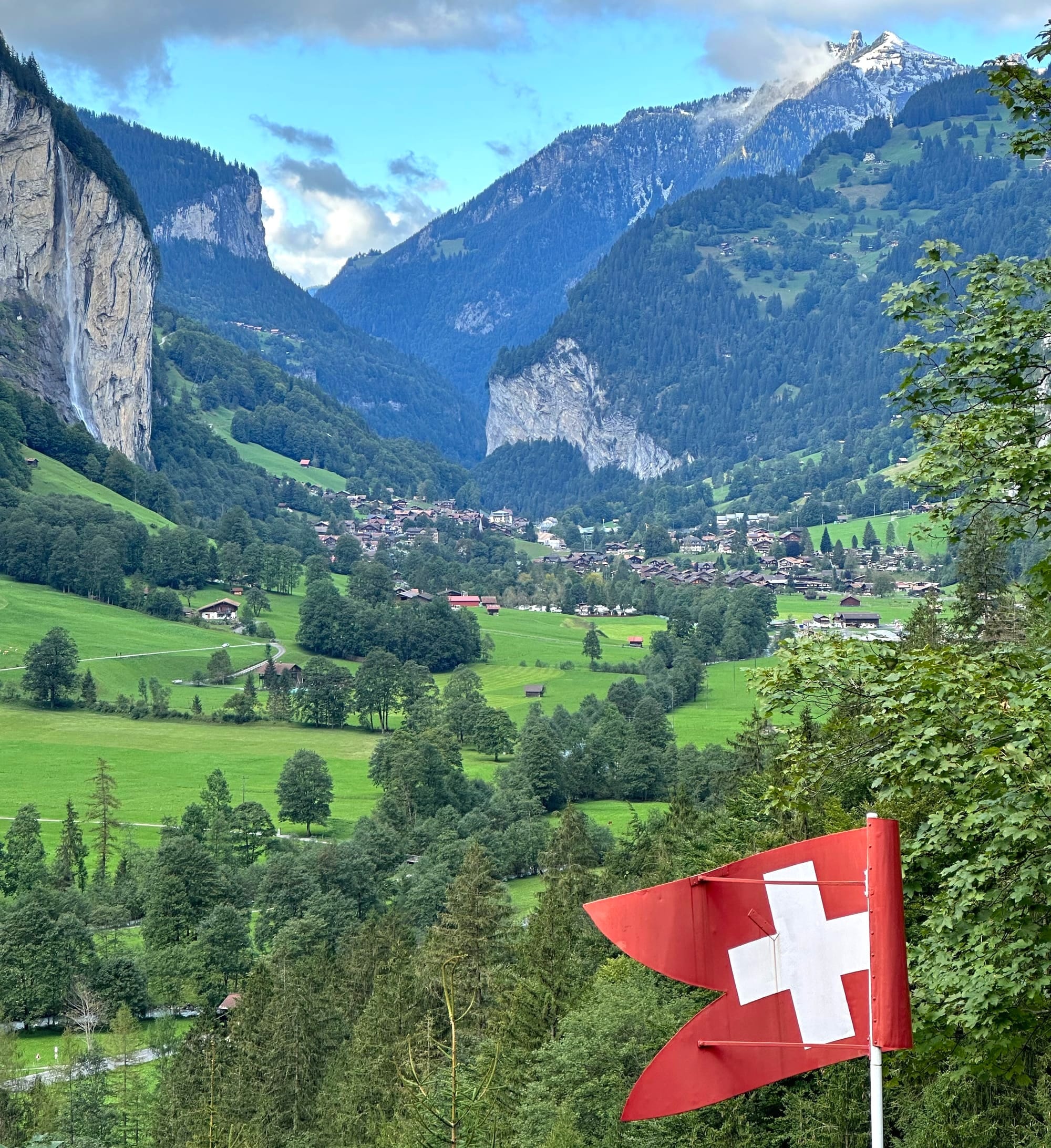
It would be an expensive trip, but I don't know when we will have this opportunity again. In 5 years? 10 years? Maybe never? You can get your money back but not your time.
Here are some highlights and travel tips if you're planning something similar.
Jump to a section:
- Before you travel
- Renting a car in Germany
- Munich to Bern
- Bern & Thun to Zermatt
- Zermatt & Matterhorn
- Lauterbrunnen & Interlaken
- Costs
- BMW M4 review
Before you travel to Switzerland
There are a few things you need to be aware of before embarking on your trip.
Swiss Road Tolls - the "Vignette"
Tolls work differently in Switzerland. Rather than paying a few dollars when using a motorway, you pay 40 francs upfront for the entire year. Yes, even if you're just visiting for a week.
You can get the vignette from petrol stations or from the official website - vignetteswitzerland.com. That's the most convenient way because it's entirely digital, tied to your car's number plate.
Finding parking in Switzerland
Free street parking is almost non-existent in Switzerland.
Luckily, you don't need to put coins in a weird parking terminal. Just use the Easypark app. It shows you all the parking zones nearby and you pay through the app. Just enter a number of minutes and go.
You can also extend the duration at any time if you're getting back to the car later than expected. I was really impressed actually - it's the most convenient parking app I've ever used.
Get an eSim
Switzerland is not part of the EU, so even if you're from Europe, roaming is going to be really expensive.
Instead, you will want to use an eSim app like Yesim or Airalo. The main difference is that Yesim charges by the month (unlimited downloads) and Airalo charges by the gigabyte.
Considering how much I used Google Maps to navigate all over Switzerland, my data usage was extremely high (enabling terrain view makes it worse), so Yesim was the obvious choice.
Also, Yesim is a Swiss company and the rates are a bit cheaper for Switzerland.
Renting our car from Sixt in Germany
Driving a nice car was a major point of the trip for me. We would be spending a lot of time in the car, so it needed to be enjoyable, and we would be driving on the winding alpine mountain passes that are famous amongst car enthusiasts around the world, so I wanted to take advantage of that fully.
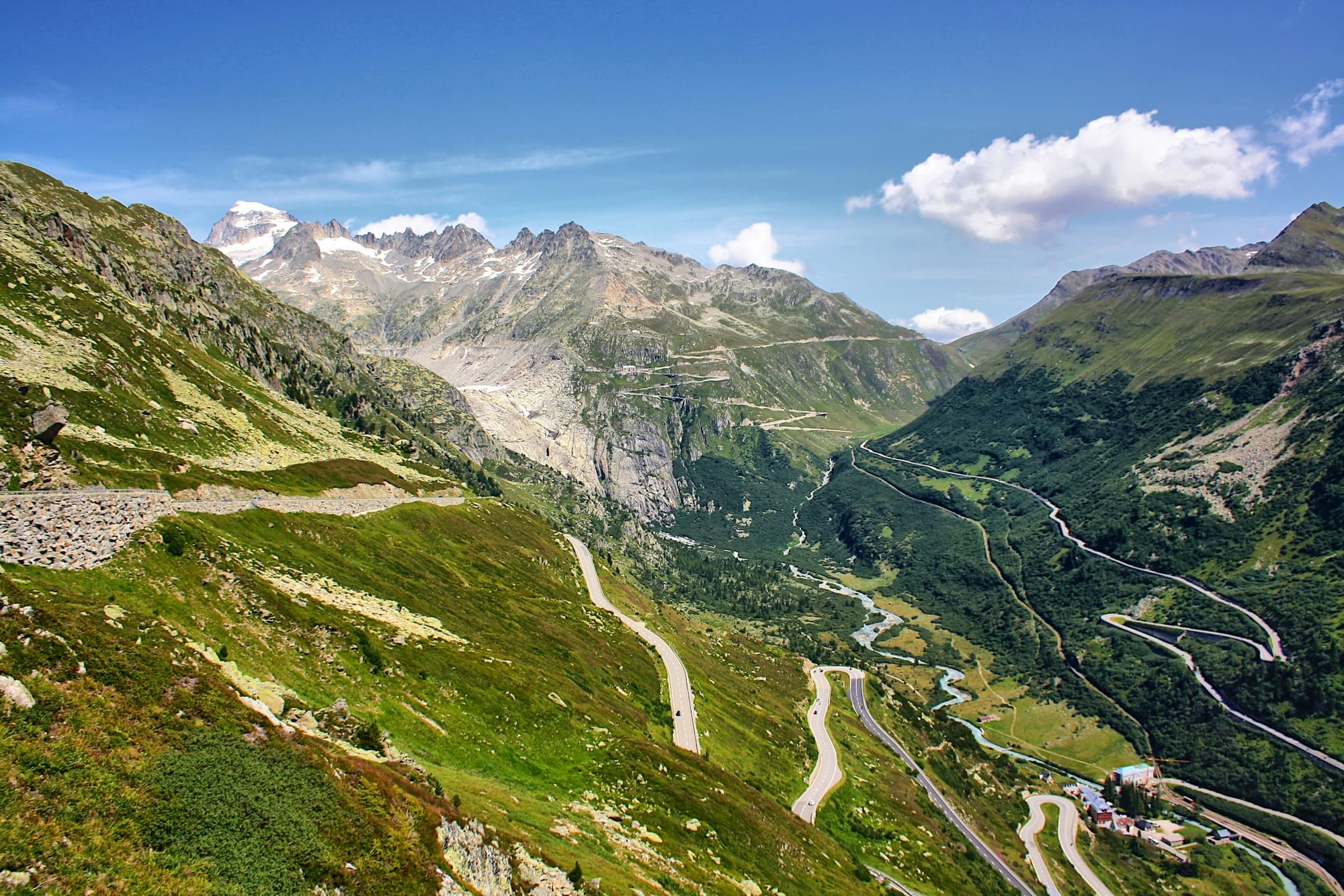
For me, the goal was to drive a BMW. I like the brand. It's from Bavaria - one of my favourite places in the world, and I visited the BMW Museum in Munich where I enjoyed learning about the company's history.
I also like the slogan - "Pure Driving Pleasure" - and the philosophy behind it. It's not just a luxury brand, they make cars for drivers.
Where to rent a car?
We were starting our road trip in Munich, the headquarters and origin of BMW, and also the headquarters of a car rental company called Sixt.
If you've never heard of Sixt, it's a German rental company (available in most major cities around the world), that specializes in premium cars such as BMW, Porsche, and Mercedez, but they have regular cars too.
Surprisingly, the prices for these premium cars are not much higher than an average small car. For example, there was a Volkswagen Polo hatchback for around €600, and a BMW 3 series for around €750 (both including full insurance).
The M4 Competition
At first, I booked a BMW M440i (not the true M4) for around €1100 all up, including full insurance with a 45% discount when you pay online.
Of course, when we got there I got upsold; they happened to have the M4 Competition available. This was a big upgrade from the m440i I had booked. It would cost an additional €400, but it's an experience to drive one of these anywhere, let alone across Switzerland. I took the opportunity.
All up the car cost me €1500 for 7 days.
They also took a €2000 security deposit which was returned 3 days after returning the car.
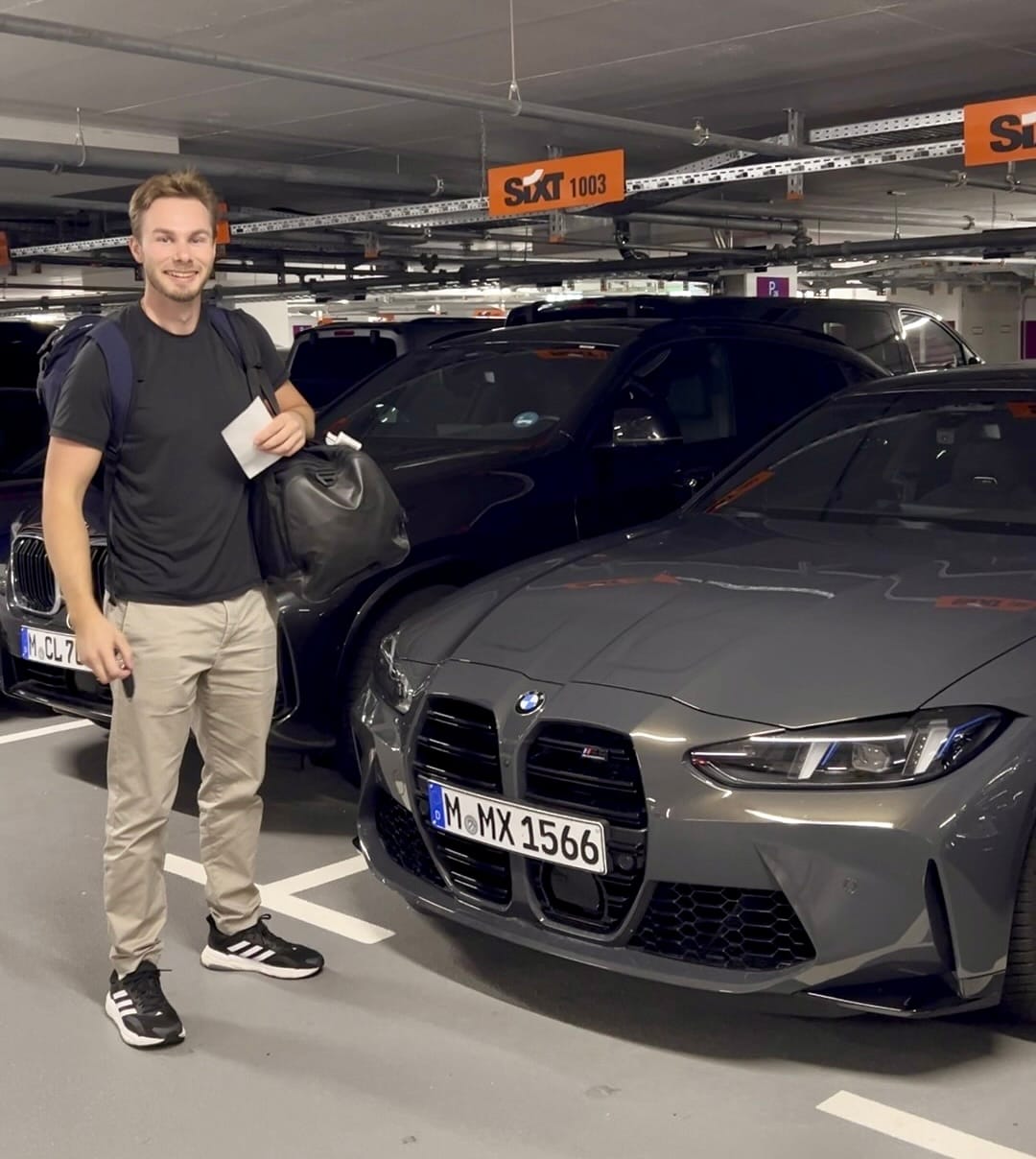
Munich to Bern
After picking up our car in Munich, Germany, we stayed a night in Hagnau, a small German town close to the Swiss-German border.
Rheinfall
Our first stop the next day was the Rheinfall - a large and powerful waterfall along the Rhine River. The photos don't do it justice - it's a huge amount of thundering crashing water. And it's a great place to stop and have lunch if you're passing by.

We decided to skip Zurich as this trip wasn't really about seeing the cities. Plus we heard that it's nowhere near as nice as Bern. We also realized at this point that our plan was overly ambitious and we were short on time, so we continued on to Bern.
Swiss farm shops
We did, however, stop at a small farm on the way, in the Aargau region, where we bought some milk and cheese. These farm stores are common in Switzerland. You can buy the freshest produce directly from farmers. Just put "farm shop" into Google maps to find some on your route.

You can also see cows, sheep, and some lovely green farm landscapes. Not the epic mountains of the Alps, but a friendlier, cosier land. If you're into that, you can also pass through the Emmental region (yes, like Emmentaler cheese).
Bern to Zermatt
We had a long drive ahead that day. Waking up in Bern, driving through Thun and then to Täsch where we would leave our car to get to the car-free mountain town of Zermatt.
Bern
We got to Bern late at night so we only had a couple of hours to explore it in the morning. It's a small city so that was enough time to walk around most of the touristy centre.
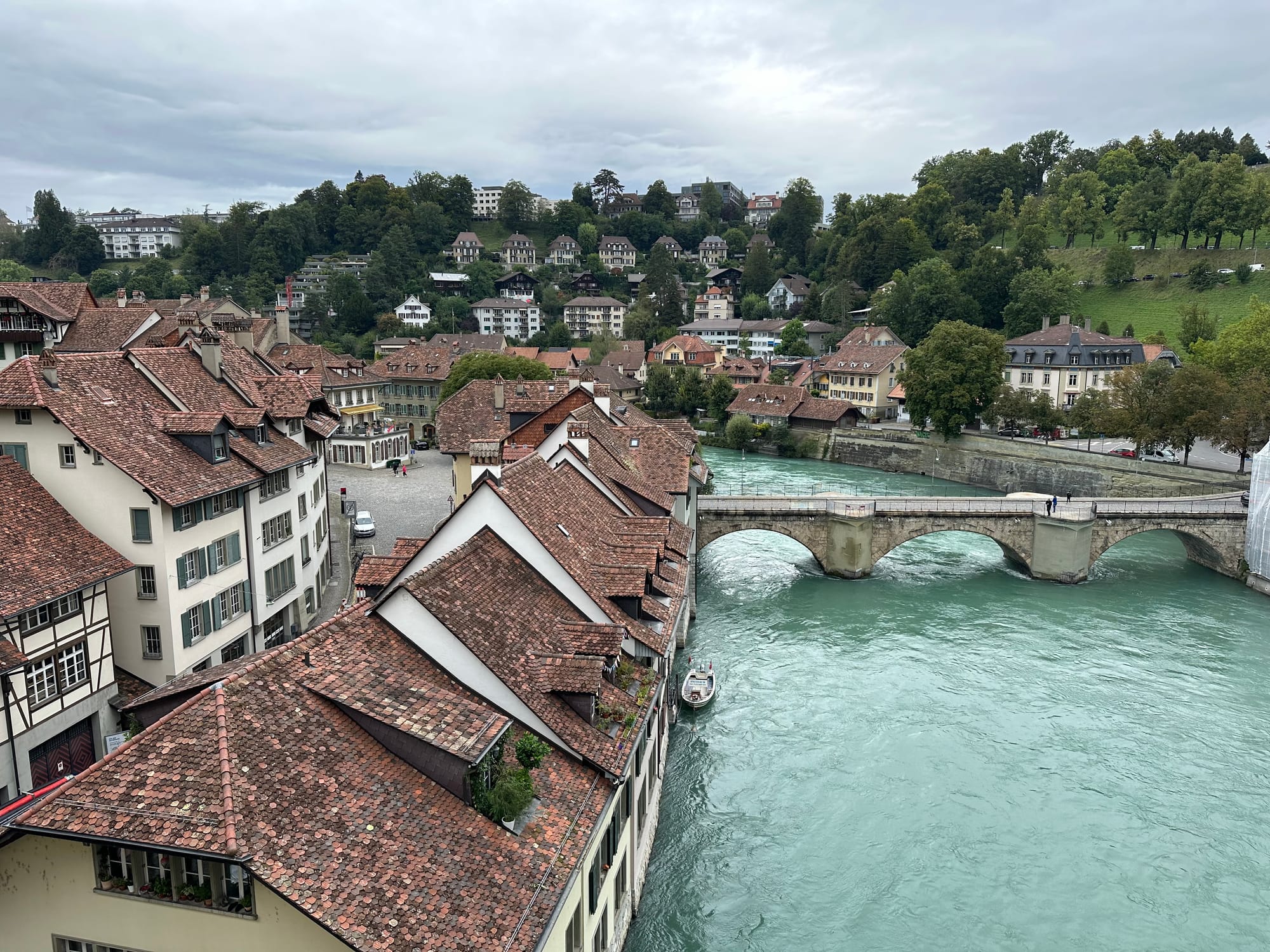
Bern is the city that I knew mainly from the videos of residents floating down the river as their daily commute to/from work. This is the first time we saw those bright blue waters, and despite it being a cold day I had the desire to jump in. The river is definitely the top attraction of Bern for me.
Bern is a hilly city with buildings and bridges standing at different heights. It adds "layers" to the city, a 3D effect. It felt futuristic somehow despite the old architecture.
Everything was clean and well-maintained in Bern and throughout Switzerland, to a level that I had never seen even in other wealthy countries.
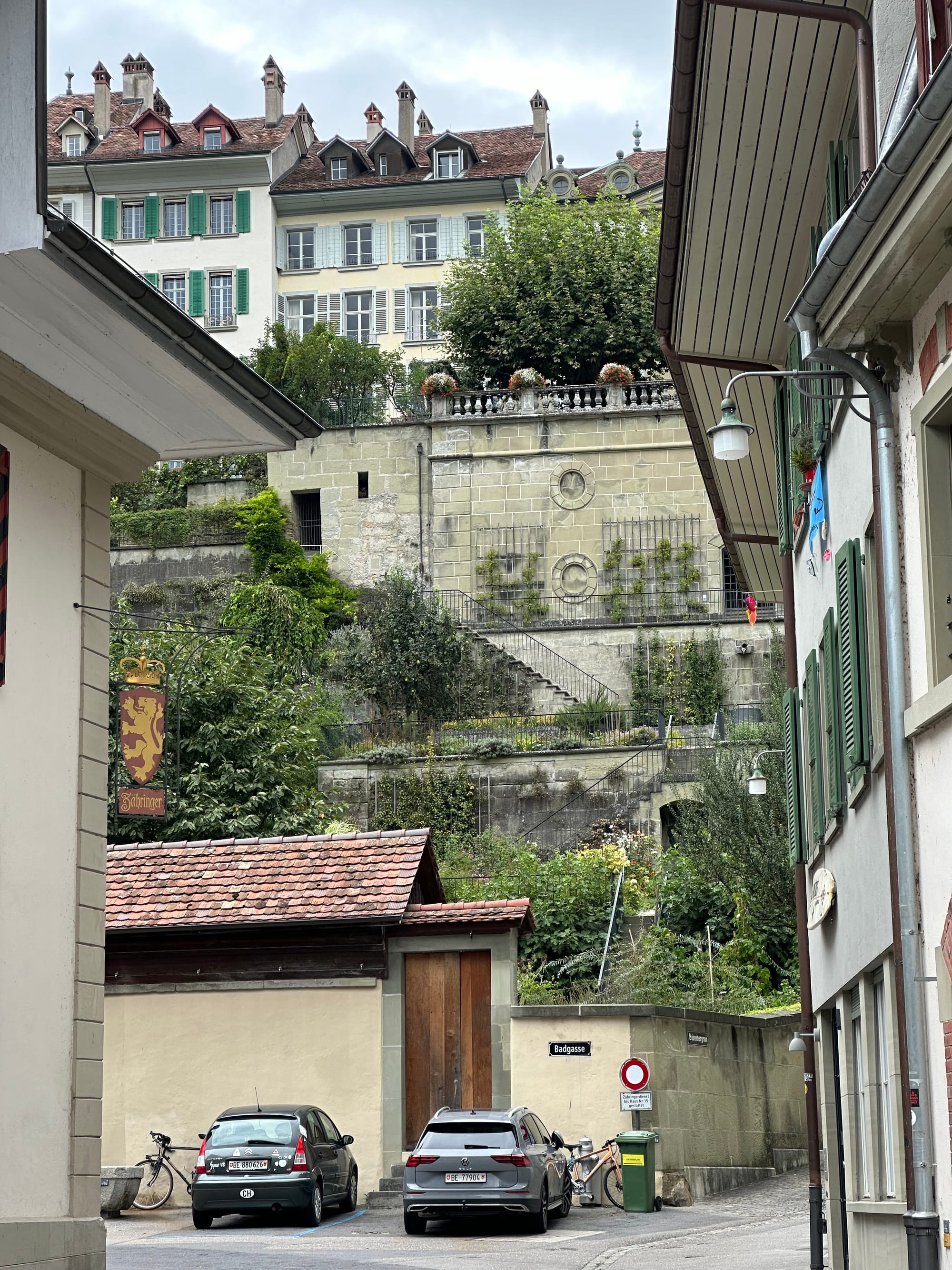
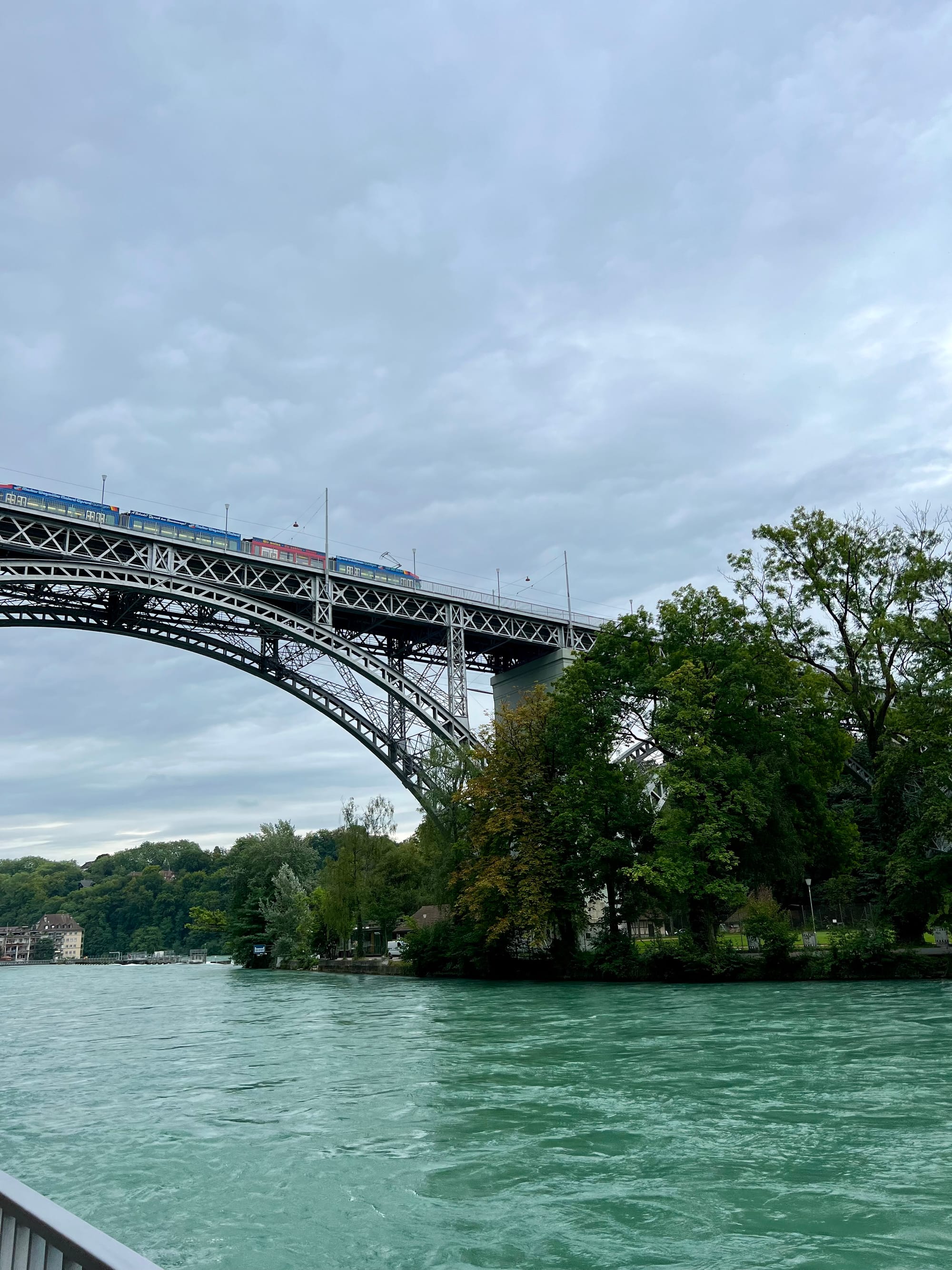
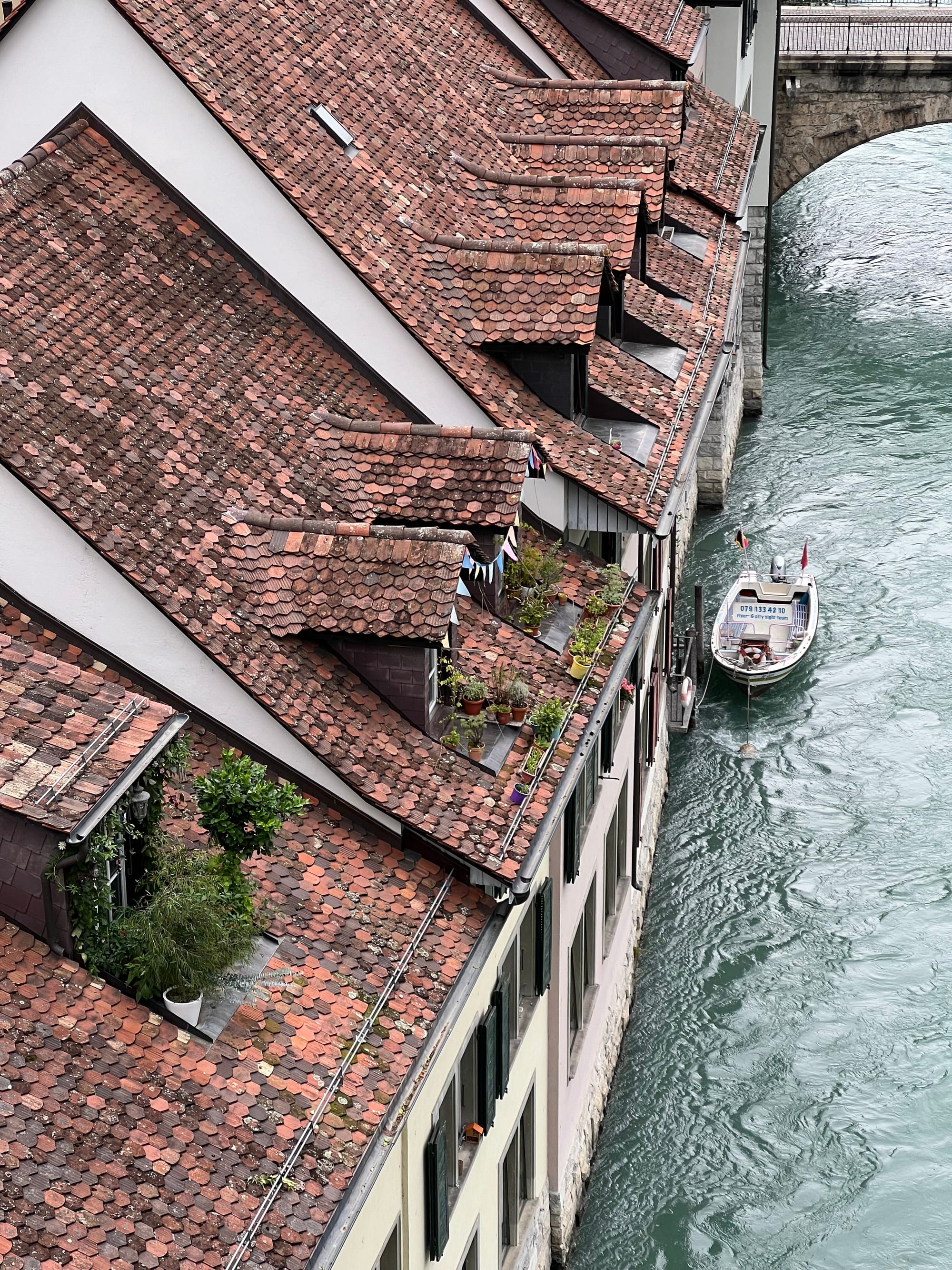
Bern, Switzerland
Thun
Thun is just 20 minutes drive south of Bern. It's a smaller town on the edge of a huge lake - the Thunersee.
We left our car in a large parkhaus in the middle of the city, for 3 francs per hour, which by my standards is cheap. In my hometown of Sydney, Australia, parking in the city center can be around $20 per hour! I never saw prices like this anywhere in Switzerland, so I can say that parking is much cheaper in Switzerland. Although to be fair, there is more free parking in Australia, whereas in Switzerland it can be hard to find.
We only stopped at Thun for a couple of hours, but we walked around the river, again a bright blue and often used by the residents for swimming.
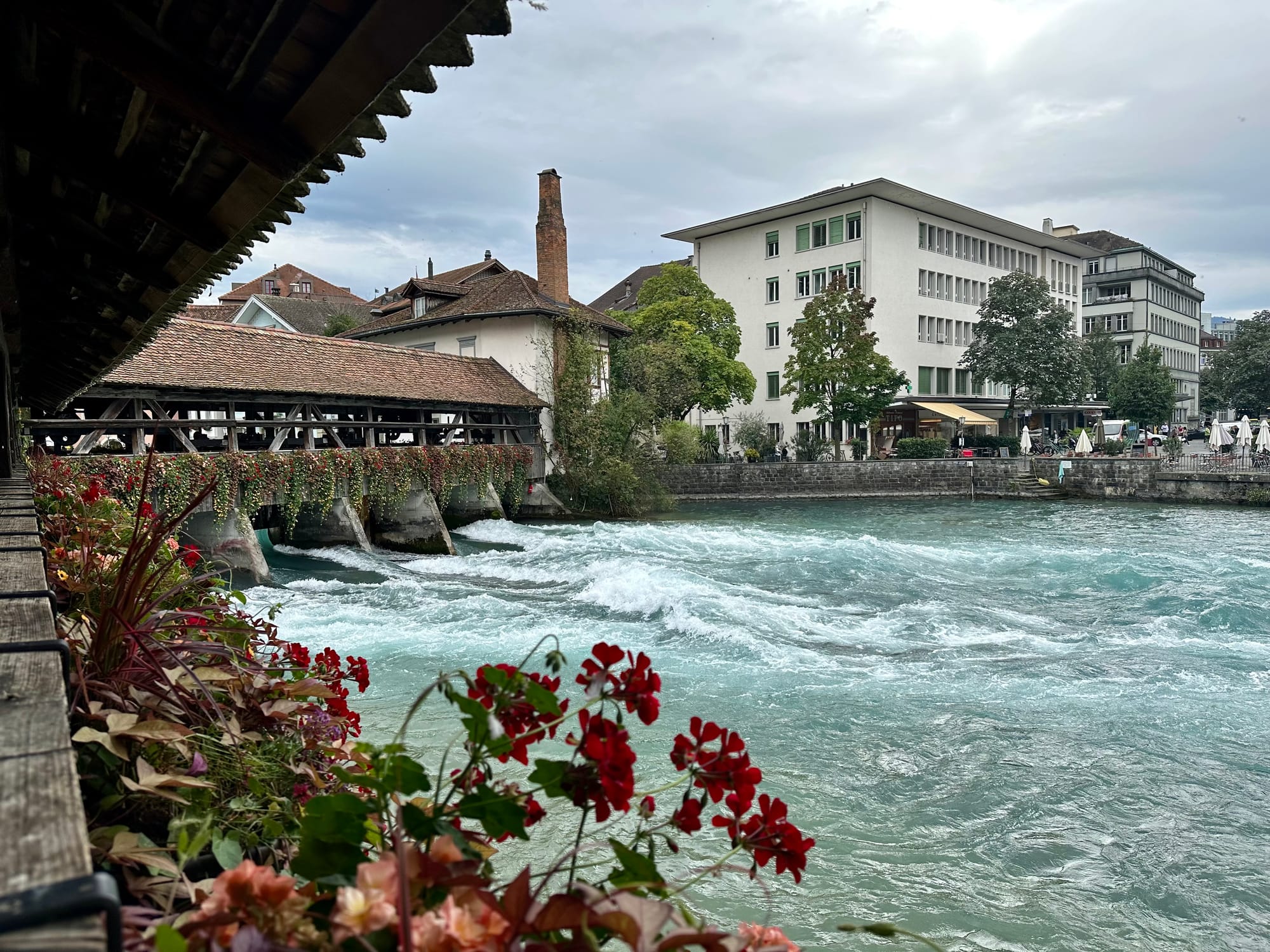
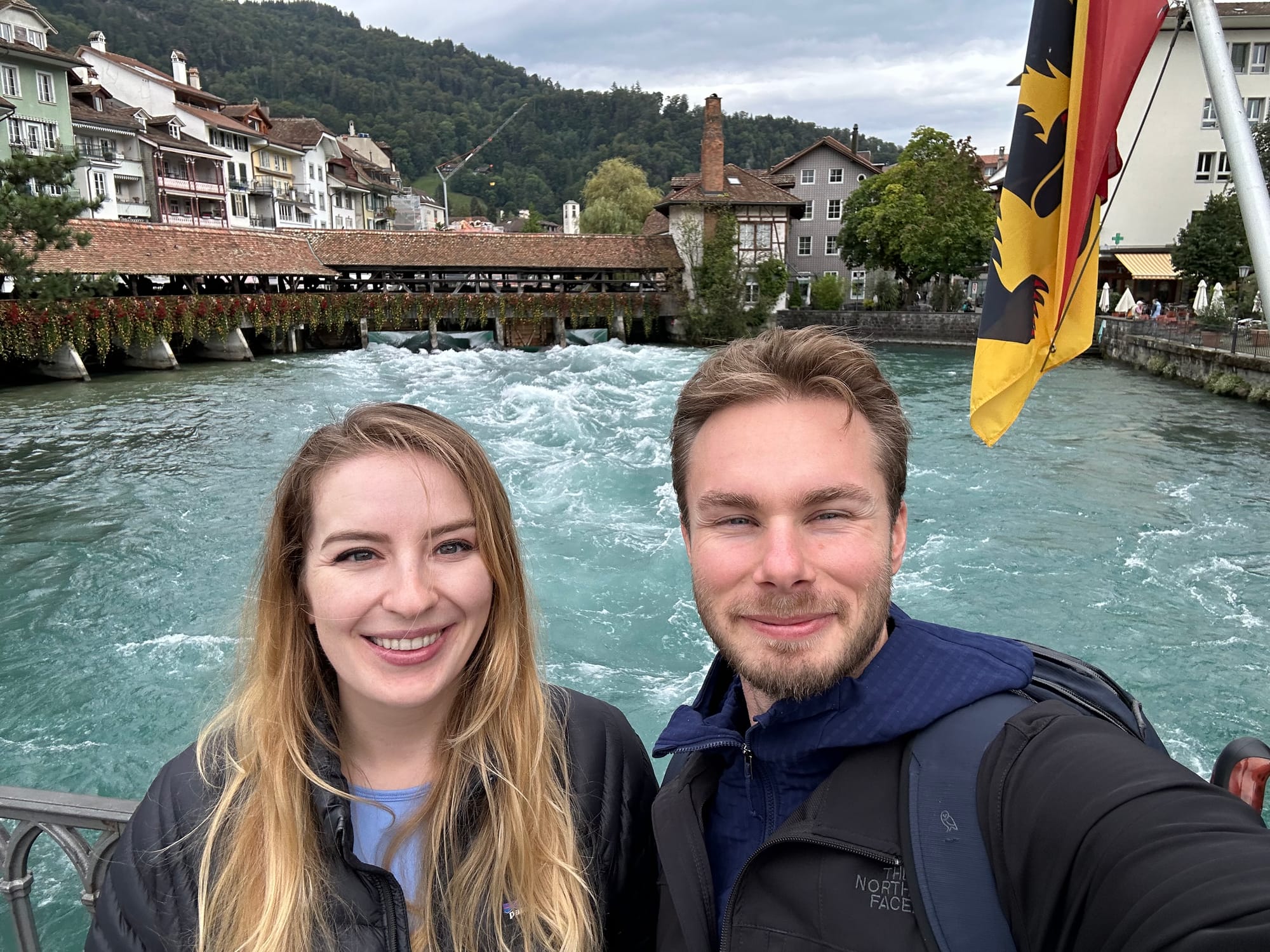
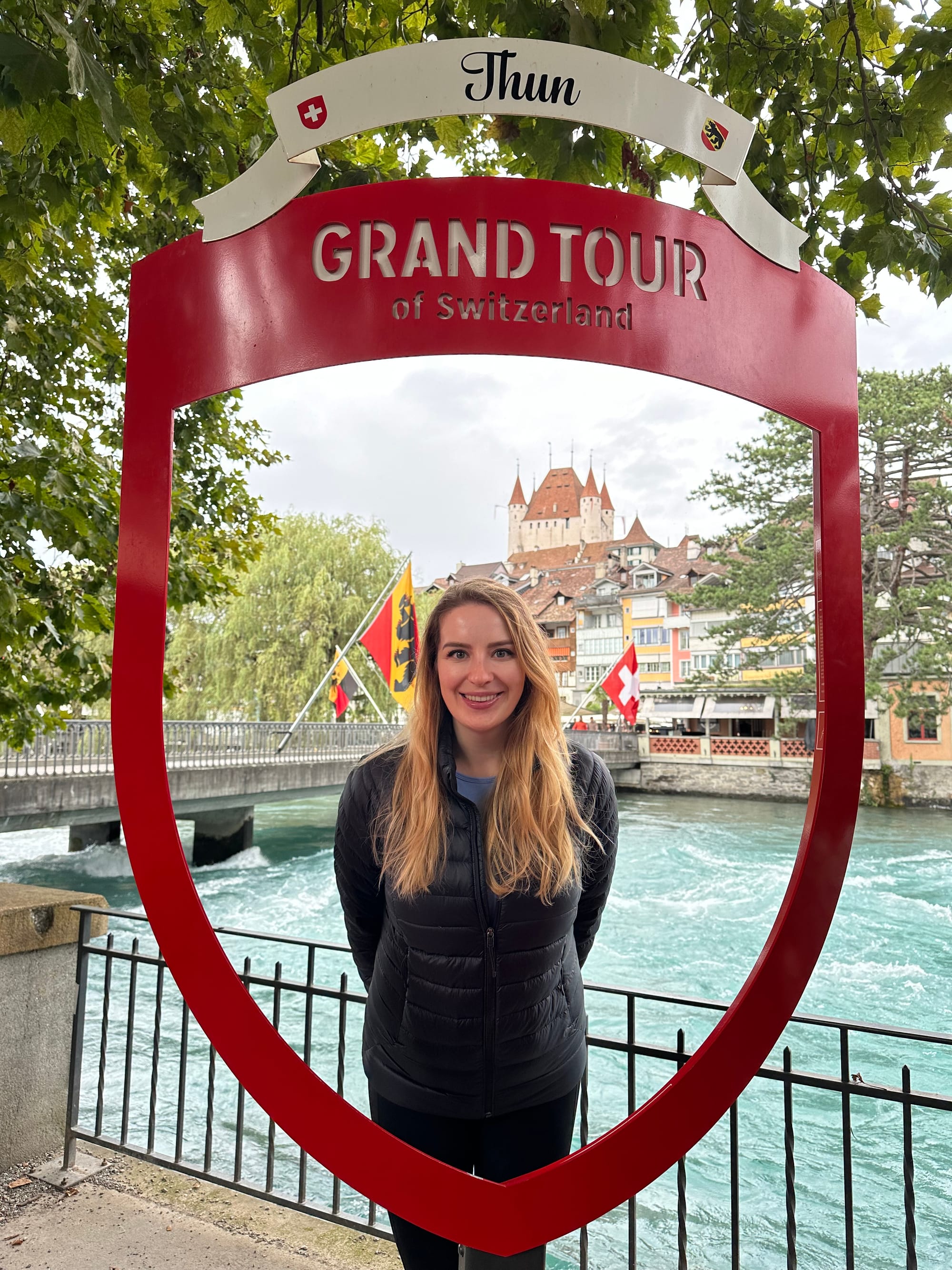
Centre of Thun, Switzerland
By the way, you might see these "Swiss Grand Tour" signs around Switzerland. It's a recommended driving route, taking 9 days to visit all the spots. We didn't do the grand tour route because we had our own plans, and 9 days was too much. There is a matching app to help you navigate, and you can collect digital badges for each location.
Lotschberg car train
To get to Täsch & Zermatt, you must cross a huge mountain range - it's the start of the Alps. There aren't many ways to drive there, so the best and fastest way is by an underground train that you drive onto with your car.
It cuts straight through the mountain range, transporting you to a different part of Switzerland in just 15 minutes.
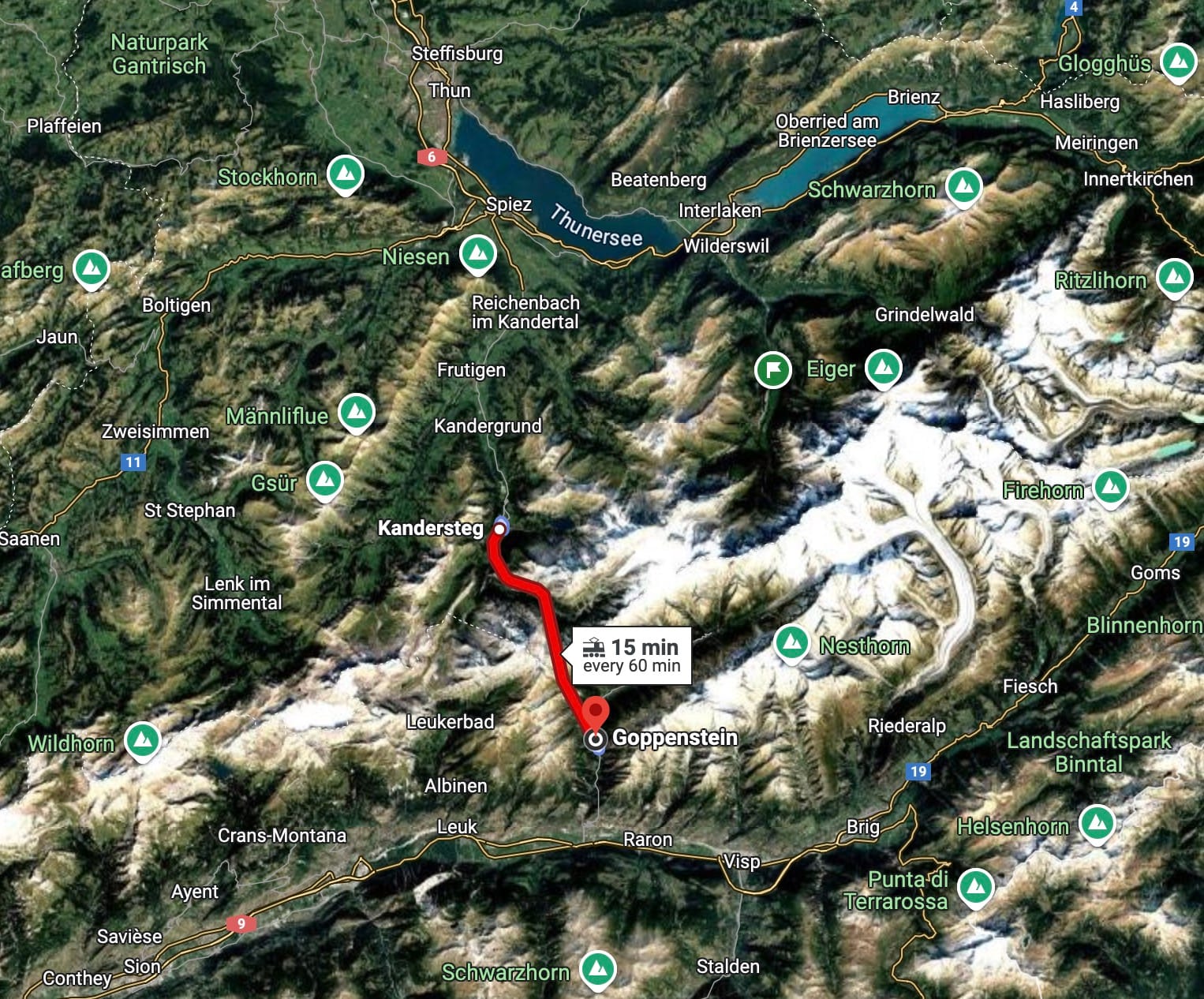
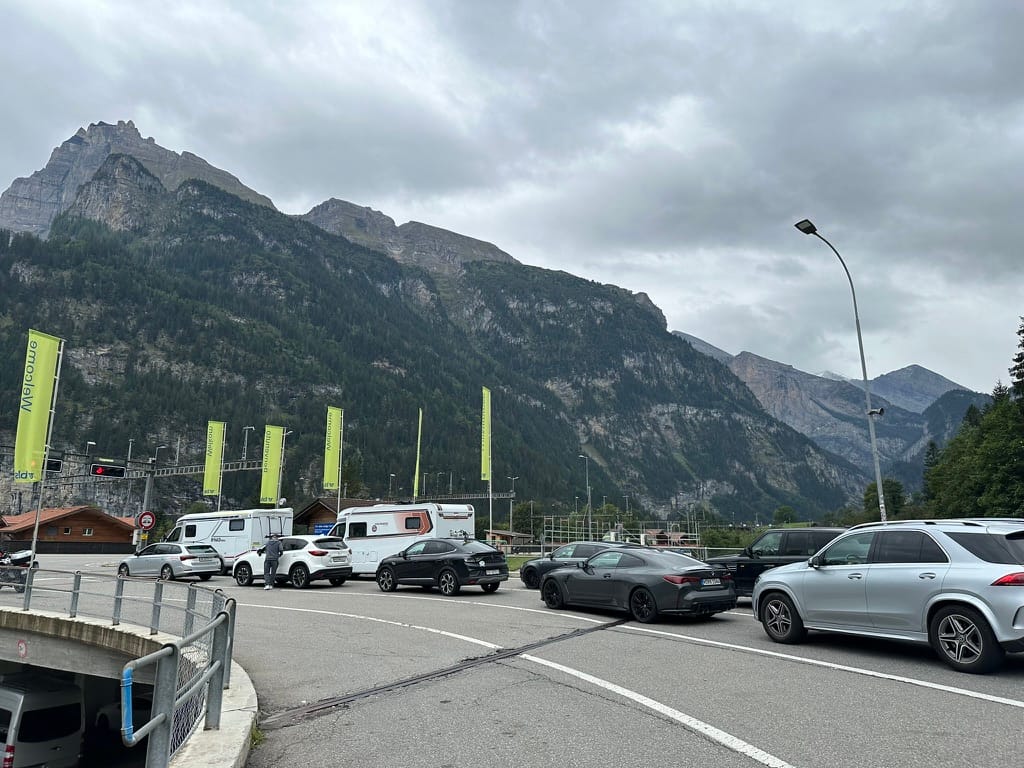
Lotschberg car train
To use the train just drive to Kandersteg or Goppenstein (depending on which way you're going) and follow the signs. The cost is 28 francs and you pay at a toll booth before driving onto the train.
Zermatt & Matterhorn
Zermatt is a famous alpine resort town. It's a 'base camp' for hiking and skiing around the iconic Matterhorn mountain, and some of highest parts of the Swiss Alps.
It's a car-free town. You leave your car at a nearby town called Täsch, and catch the shuttle (express train) to Zermatt. It's very well-organized - there is a huge car park directly above the train station, so the transfer is very smooth.
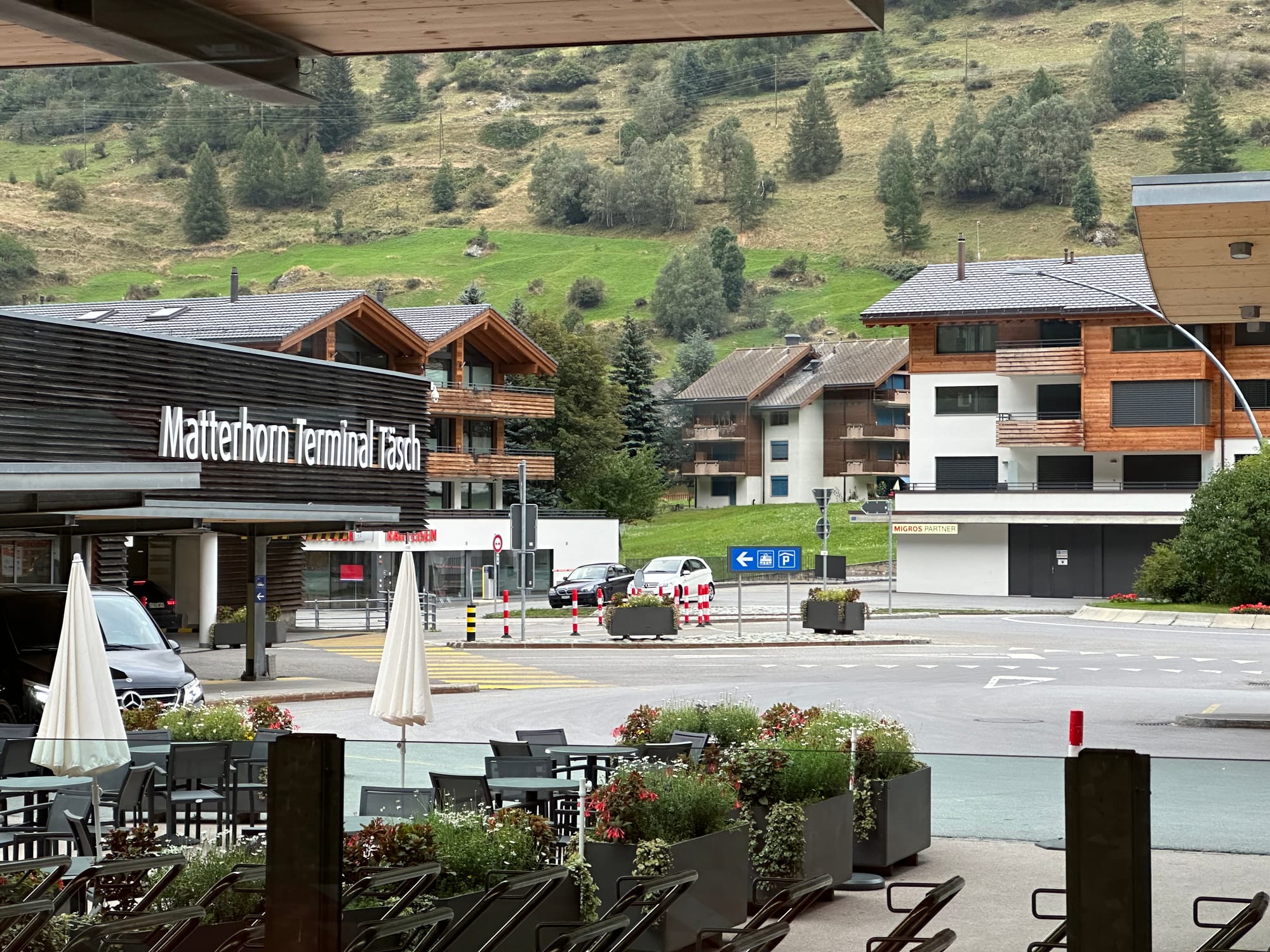
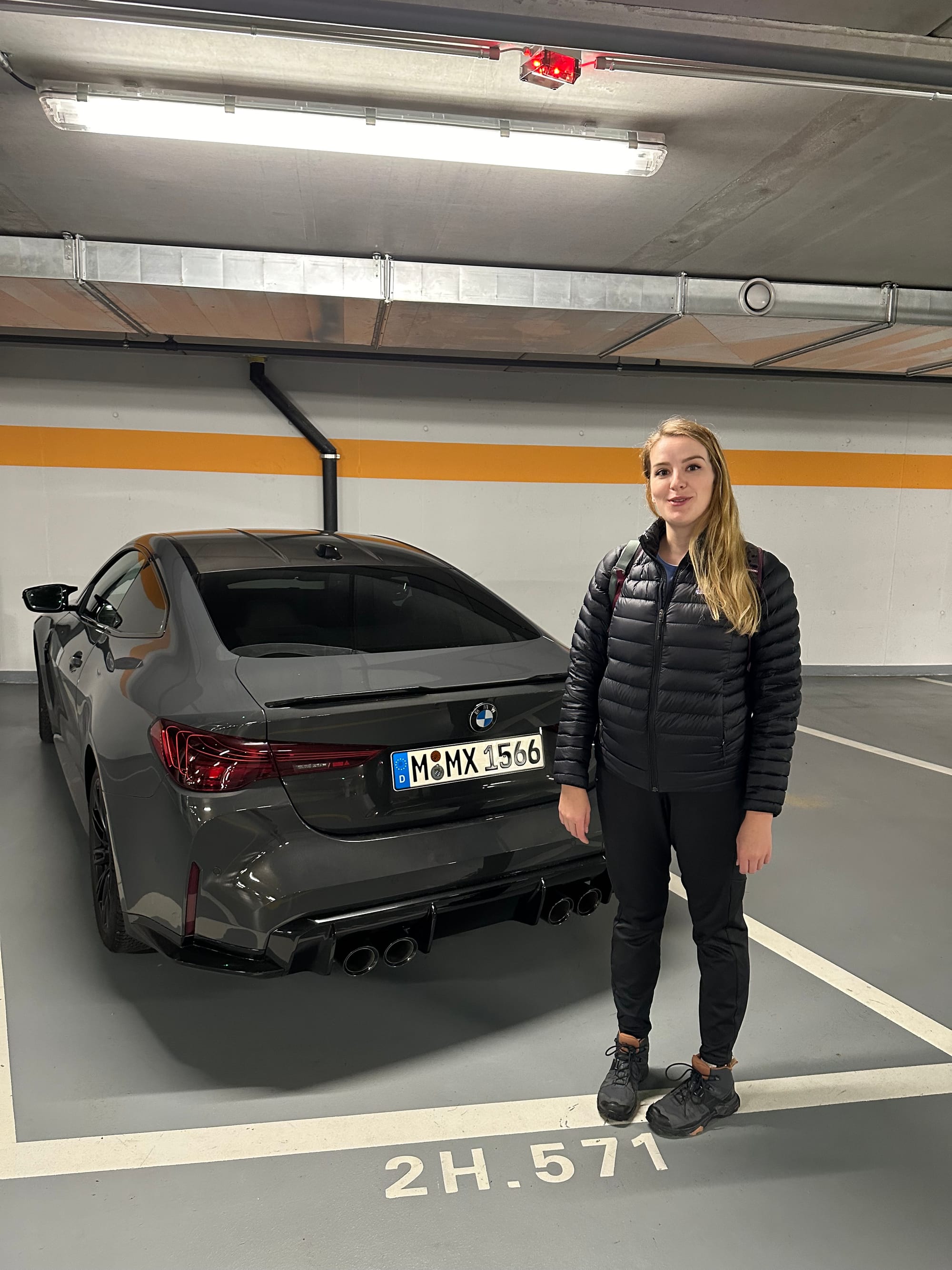
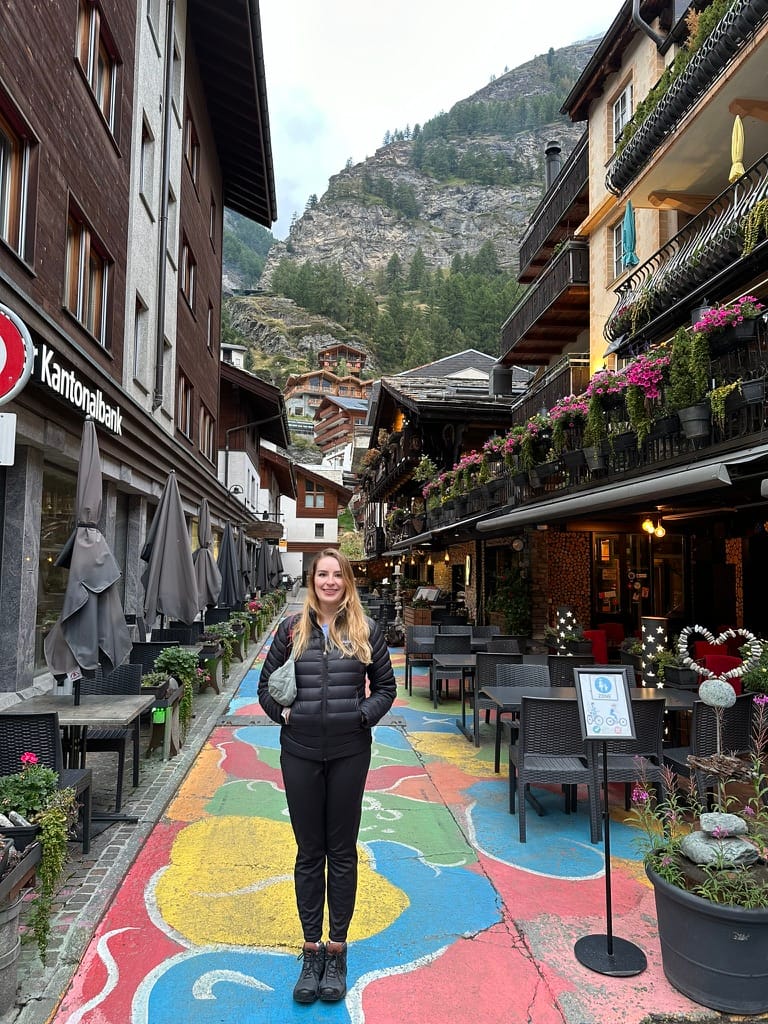
Täsch parking AKA "Matterhorn Terminal", and then arriving in Zermatt
We parked, re-organized our bags for hiking, leaving some stuff in the car, and caught the shuttle - 15 minutes later we were in Zermatt!
I honestly didn't like Zermatt itself much, I felt a bit out of place - not wealthy enough, and too young. For example, it was hard to find a relaxed place to eat dinner, everywhere was quite formal and posh (except the macdonalds).
I'm used to Zakopane in Poland, where people come down from hiking all day, still dressed in their boots and hiking gear, to have a beer and a huge meat & potatoes dinner at a local inn - very rustic and cozy. Whereas in Zermatt everyone was dressed up, and the waiters were extremely formal. It makes me a bit uncomfortable. Plus, after a 6-hour hike I just want to devour some food like a barbarian! Not all this luxury.
That being said, the hikes around the area are amazing and definitely worth it. I recommend the Alltrails app to see what interests you - it's a hiking map with photos, reviews, time estimates and difficulties for each trail.
5 lakes hike
One of the most popular hikes around Matterhorn. You pass by small mountain lakes, and on a clear day you see Matterhorn almost the entire hike. Find it on Alltrails.
The hike starts at Blauherd, and continues downhill to Sunnegga, taking about 3 hours of walking time. If you like stopping for photos like we do, plan for 4-5 hours.
To get to Blauherd you need to catch the funicular train from Zermatt to Sunnegga, and then a cable car from Sunnegga to Blauherd. In other words you pass your finish point (Sunnegga) on the way up, and hike back down to it.
What would constantly surprise me throughout Switzerland is how developed the transport infrastructure is. There are trains and cable cars everywhere. Many of them function all day, all year, with very frequent trips. The Polish mountains are by comparison very wild and undeveloped - you have to hike to get anywhere.
We seem to have a special kind of luck. Almost every time we go to the mountains it's foggy. Even though it's only the start of September, it was 0 degrees, we were dressed in winter clothing, and Matterhorn (or anything else) was nowhere to be seen.
However, as the day warmed up, and we continued downhill the views got better.
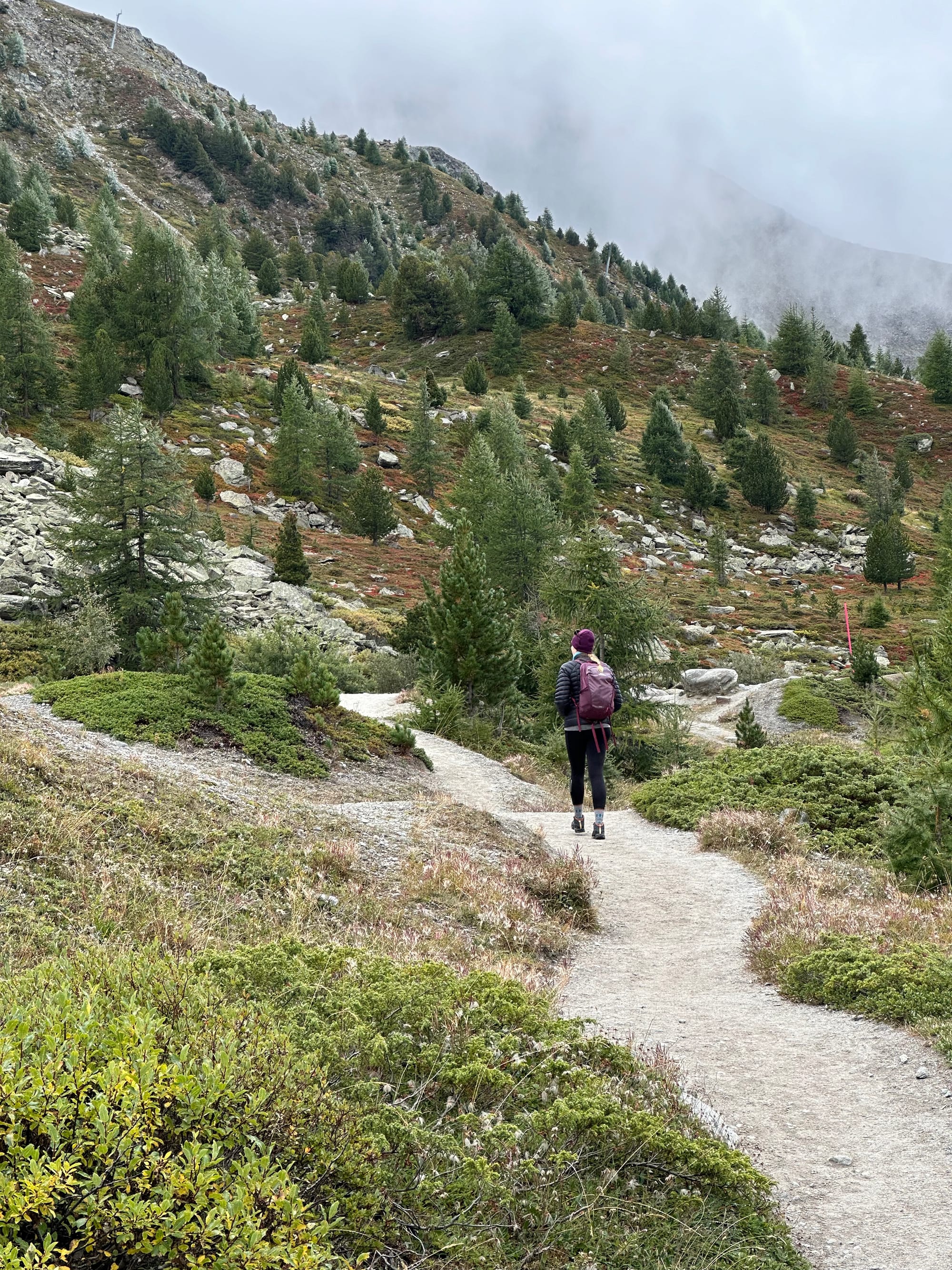
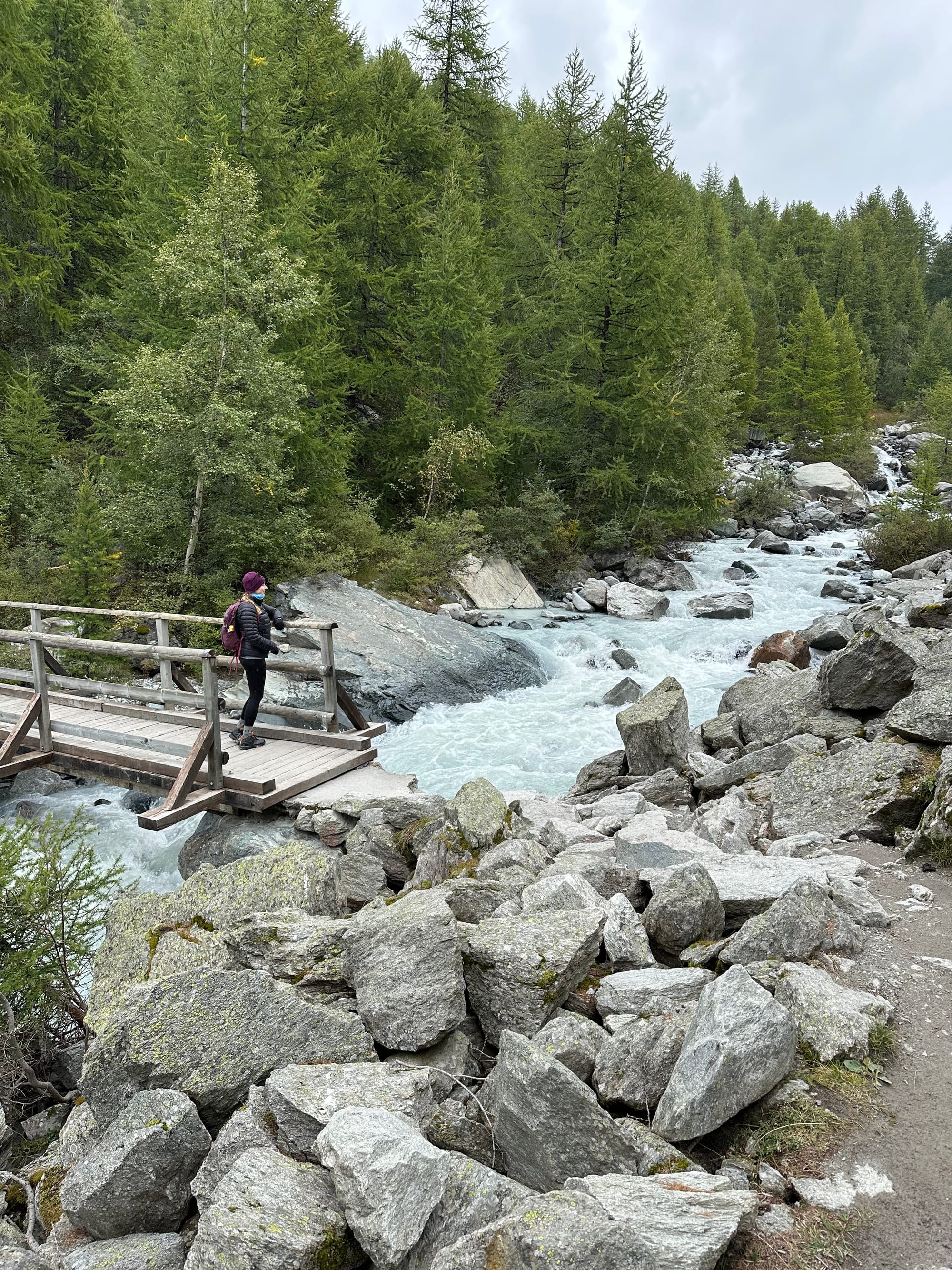
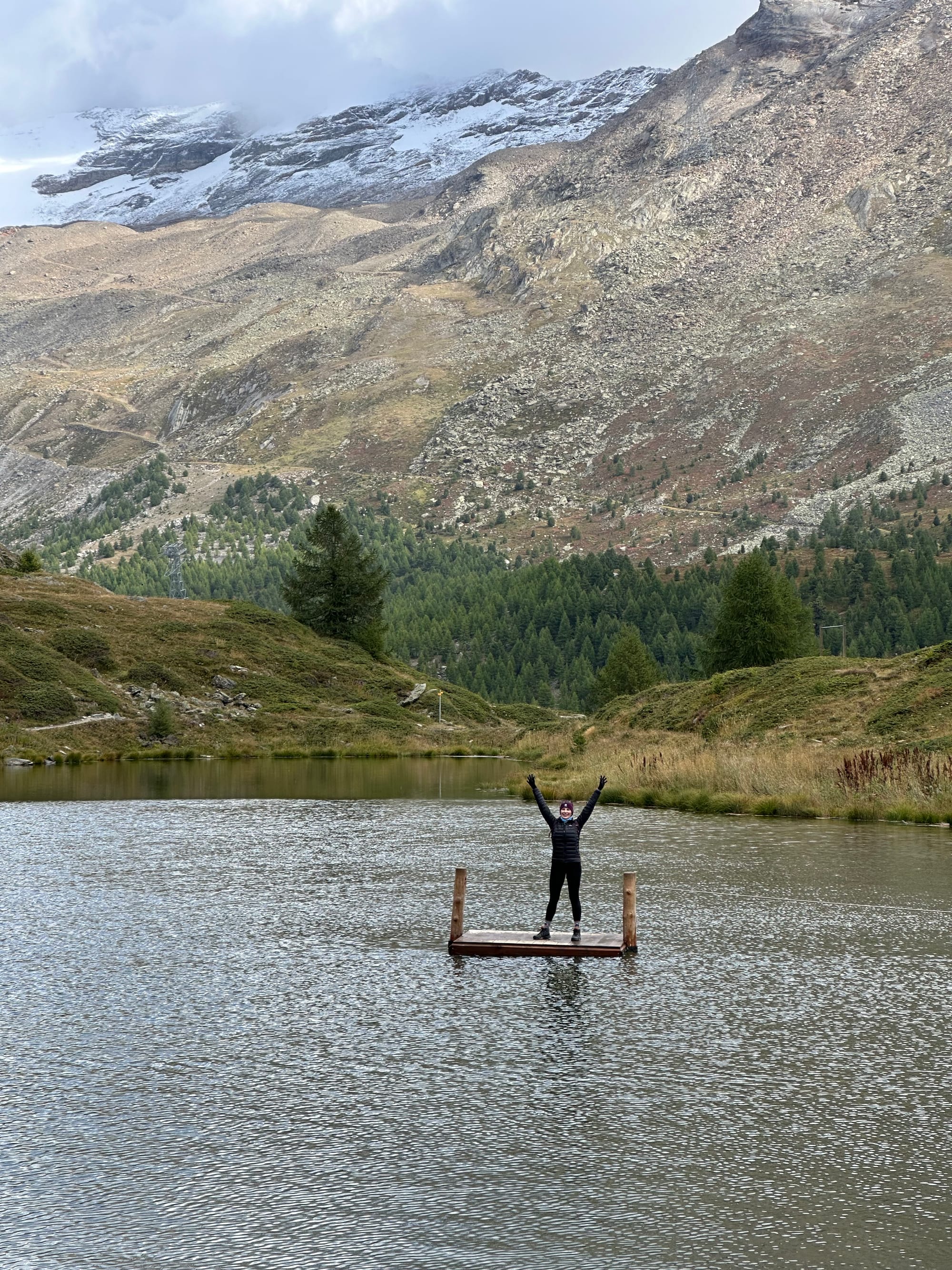
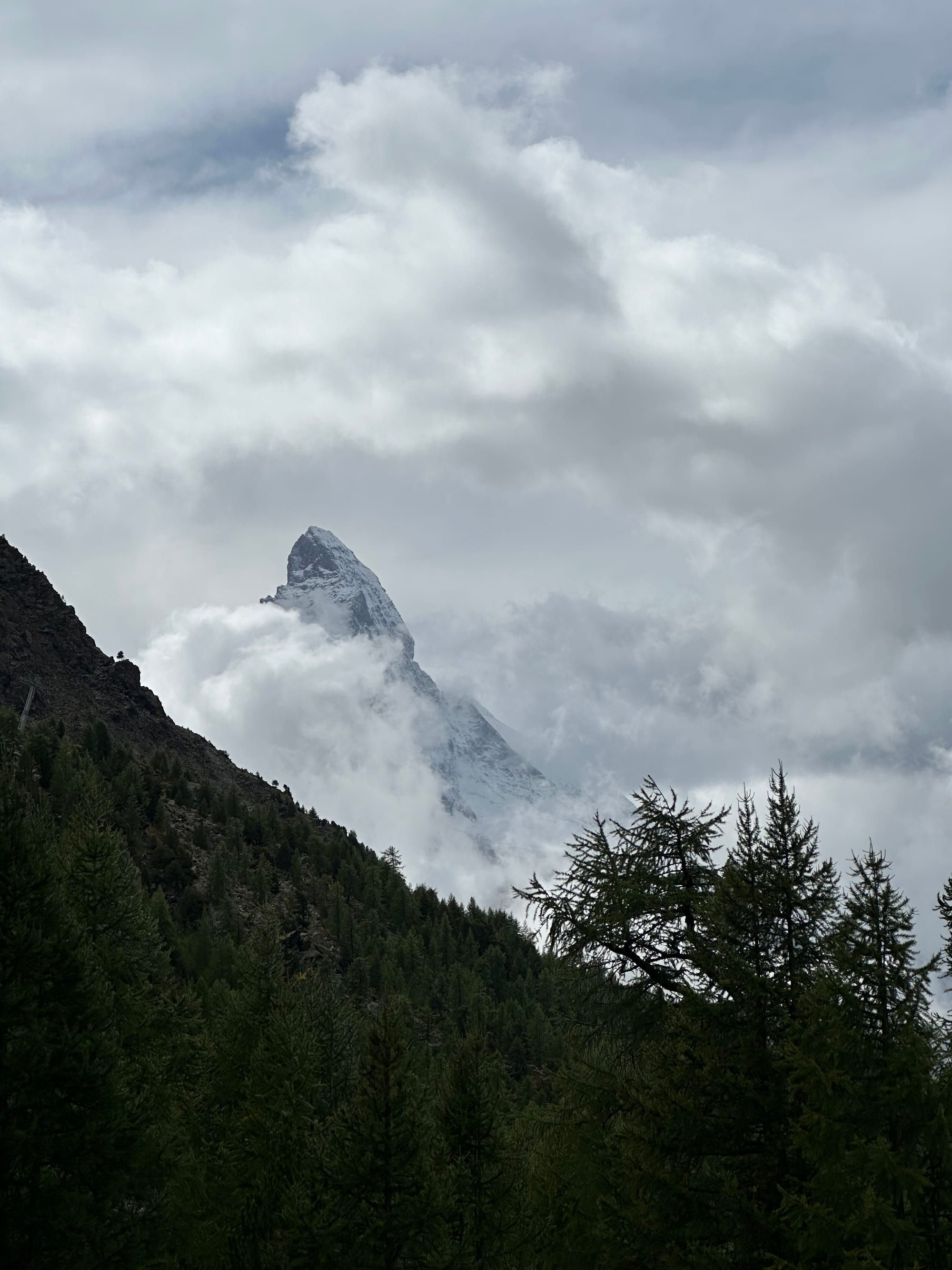
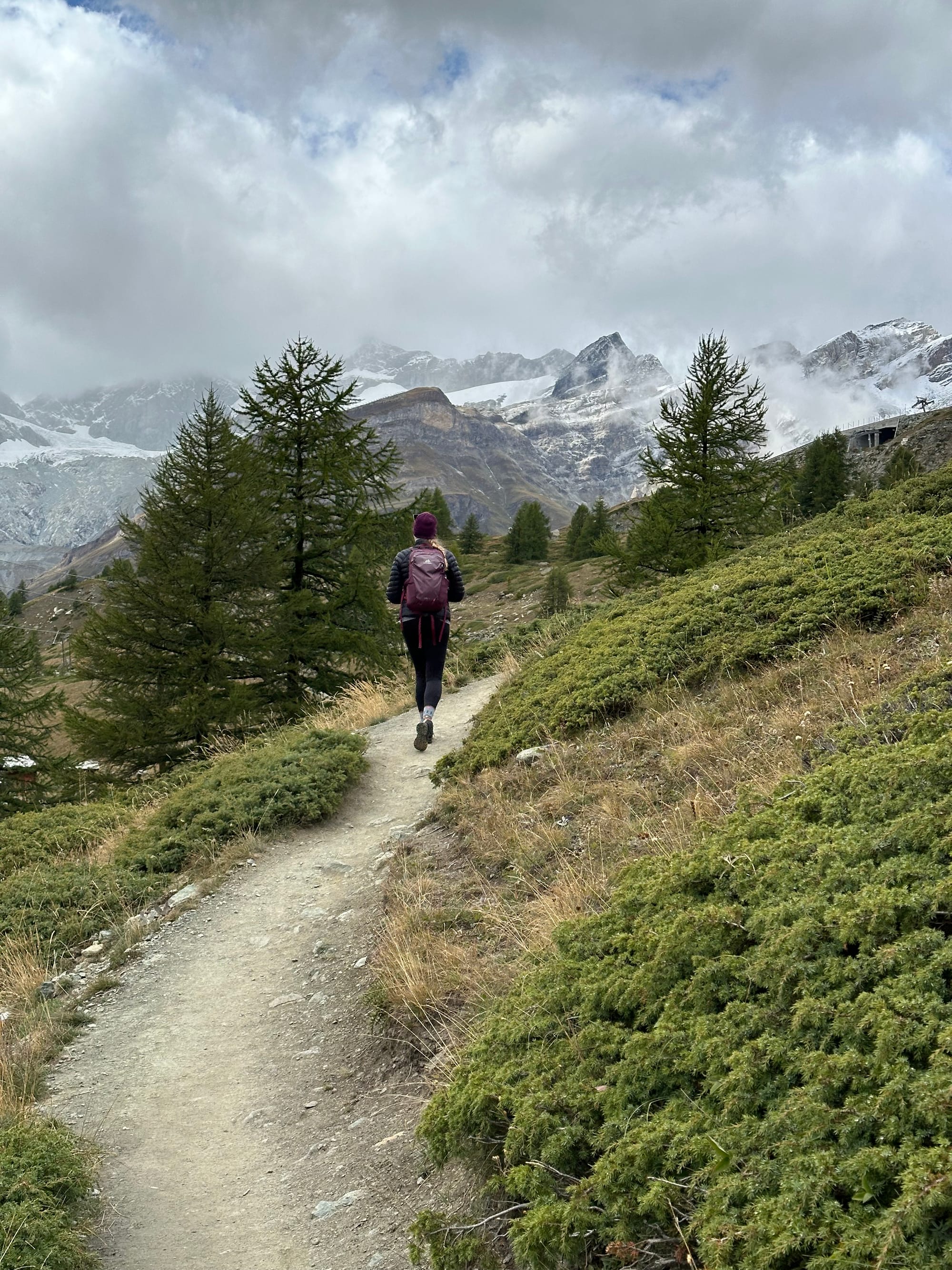
We even got a peek of Matterhorn before it disappeared into the clouds once more.
We were a bit surprised at how pale and dry the grass was. One of the things we wanted to see in Switzerland was that lush green colour (we saw it later in Lauterbrunnen). But I guess it was a hot summer and the grass had dried out. Everything was yellowish. Still beautiful but somehow a less friendly, more rugged nature.
There were still plenty of cows and goats around, and at one point while taking a shortcut off-trail, we saw a family of marmots. By the way, feeding marmots is usually not allowed and they are shy, but there is a region called "Saas-fee" where it's allowed and they aren't scared of humans.
Gornergrat train
This is one of the highlights of the Matterhorn region. If you want to go high up into the Alps and see those snow capped peaks and glaciers, make sure you do this.
You will be going to the Gornergrat station, 3000m above sea level. It's high above the tree line, so it's a very rocky and barren environment, but it's awesome in an alien planet kind of way. The station is directly above the Gorner glacier.
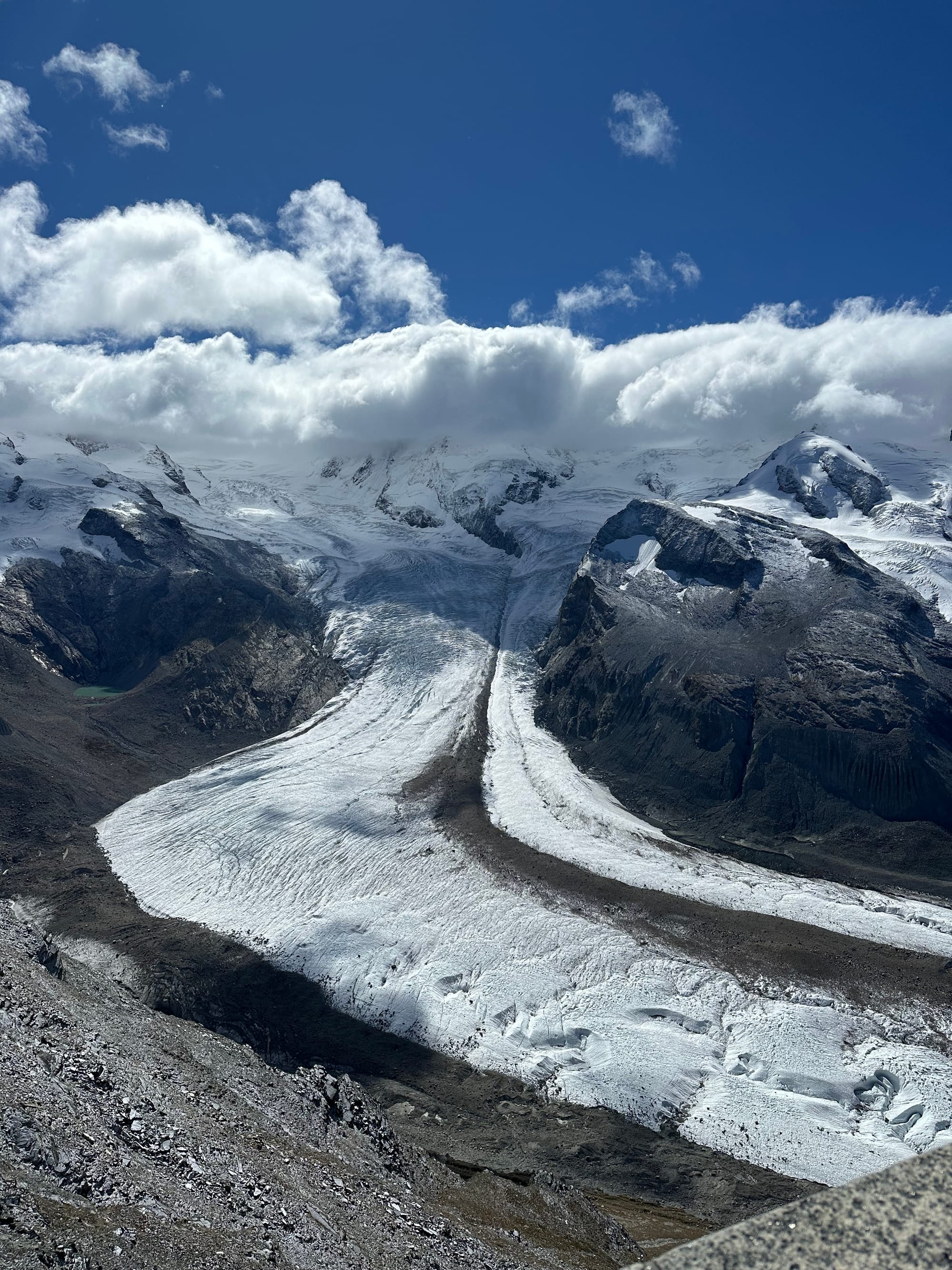
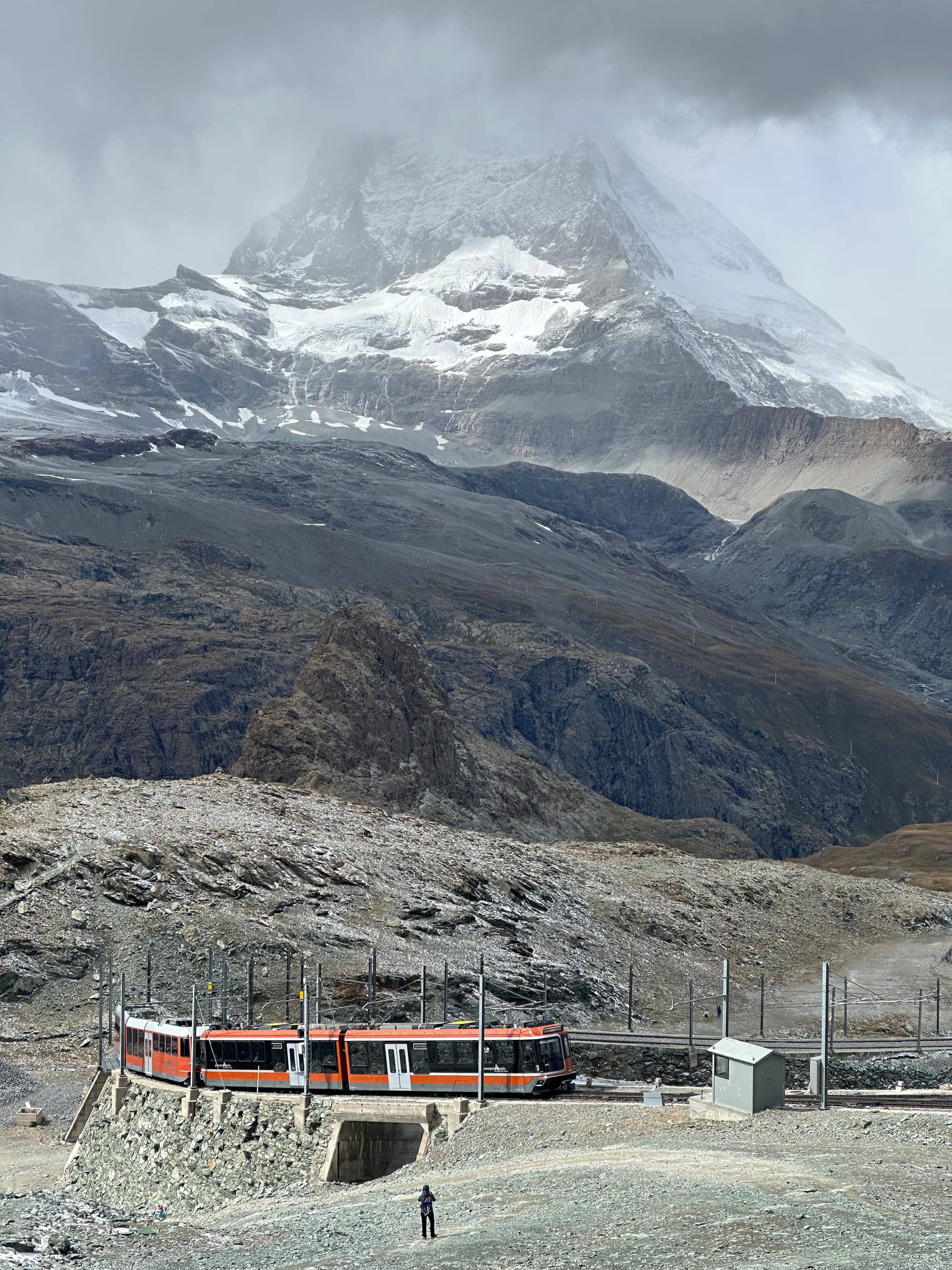
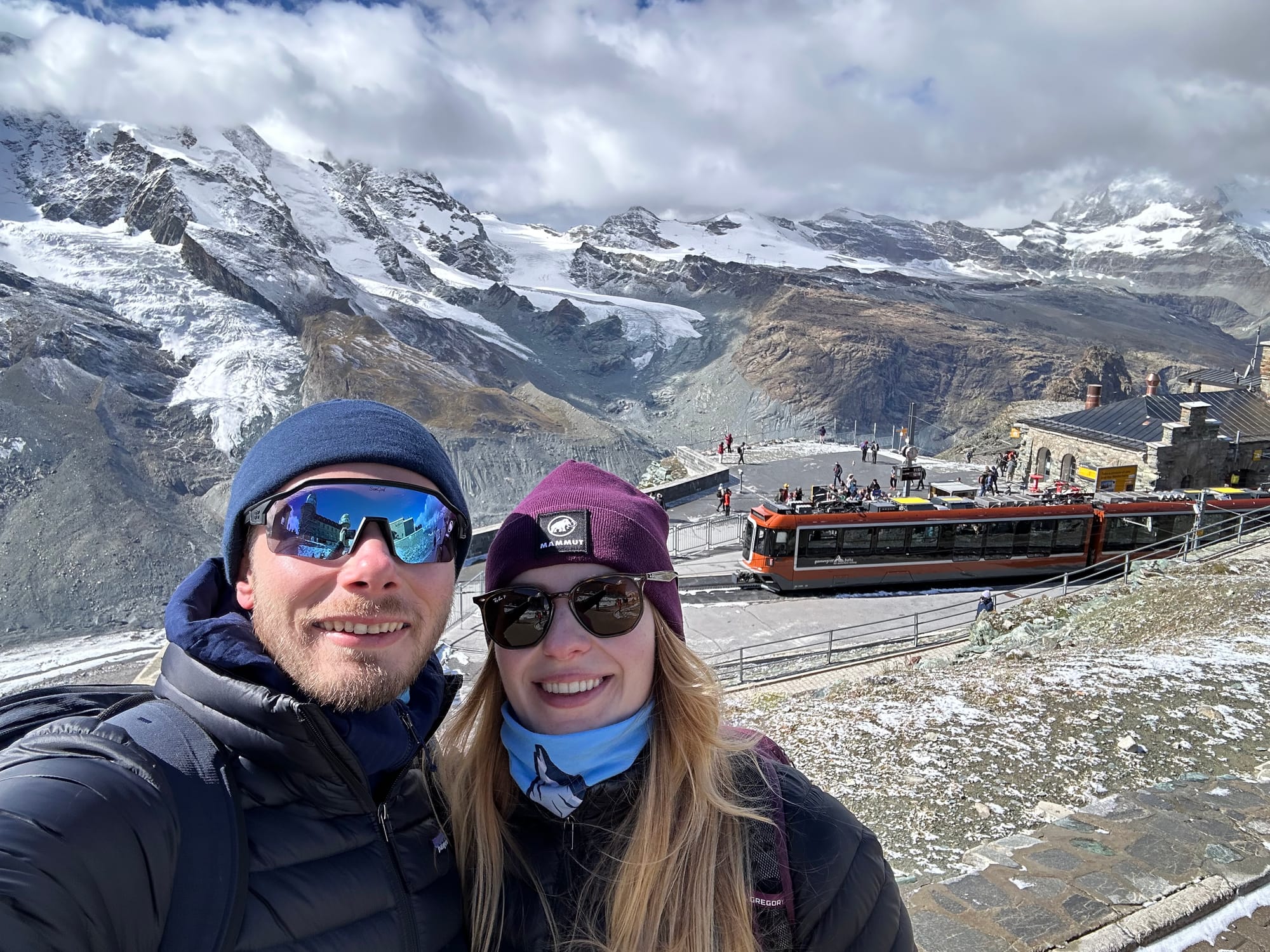
The Gorner glacier, and Gronergrat train at different stations.
If you're keen for a hike you could start at the top and hike all the way down to Zermatt (this would take 6hrs), on the way you will pass through various alpine zones - first just rocks, then grasslands, then forests.
You can also just hike segments with the help of the train. The ticket allows you to get on and off at any of the stations, and it's around 1hr walk between stations. Each station offers a different view and a slightly different climate. There are also restaurants and toilets at these stations. Tip - Stop at riffelberg for a more affordable buffet / salad bar place.
The train costs 120 CHF per person for a return ticket. I recommend spending a extra 7 francs for priority seating - they will let you in the train first, so you can grab the best seats on the right side, where you will see the best views (on the way up). Just enjoy the ride all the way up, and do the hiking stuff I explained above on the way down, otherwise you will lose your seat.
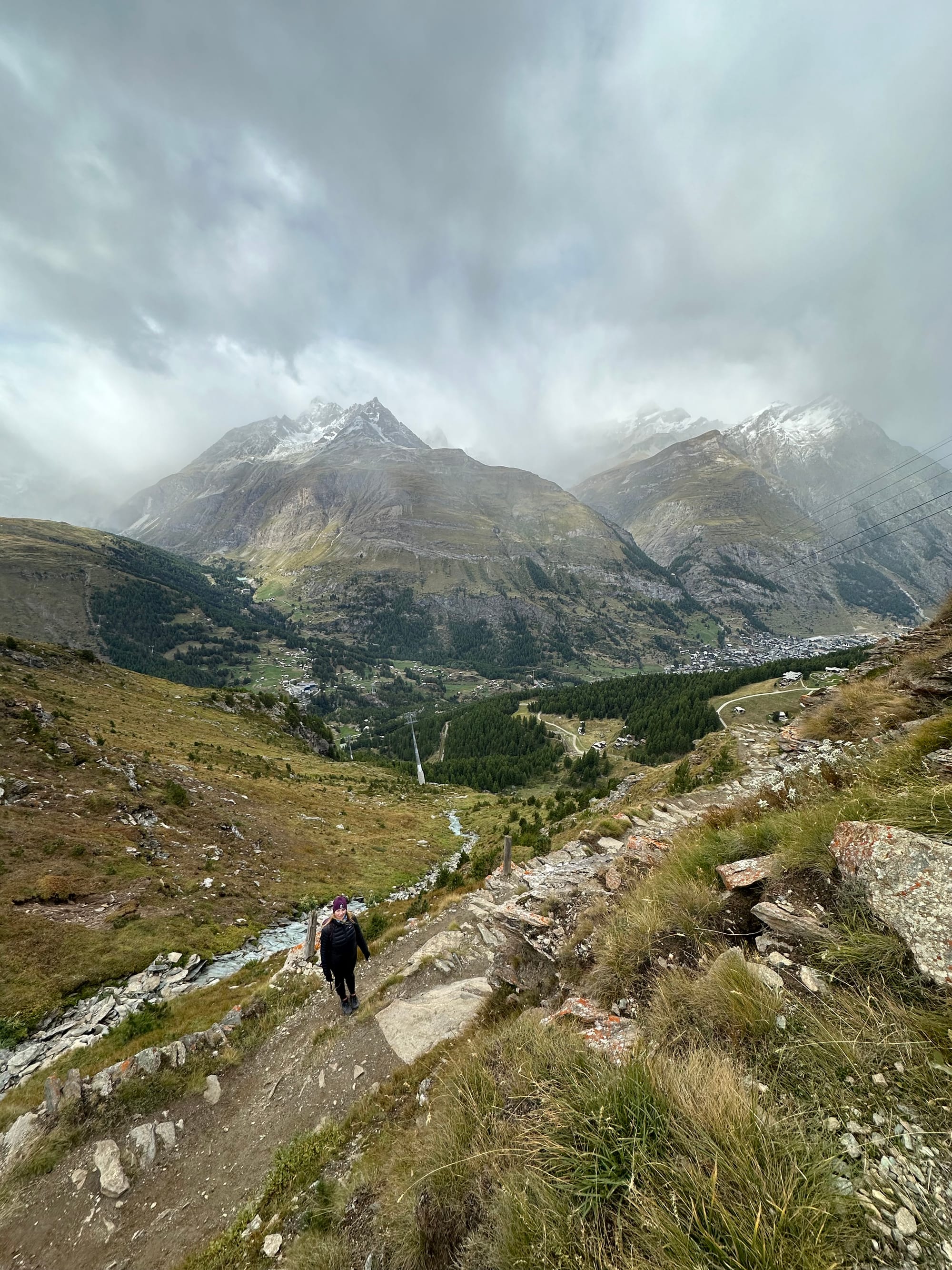
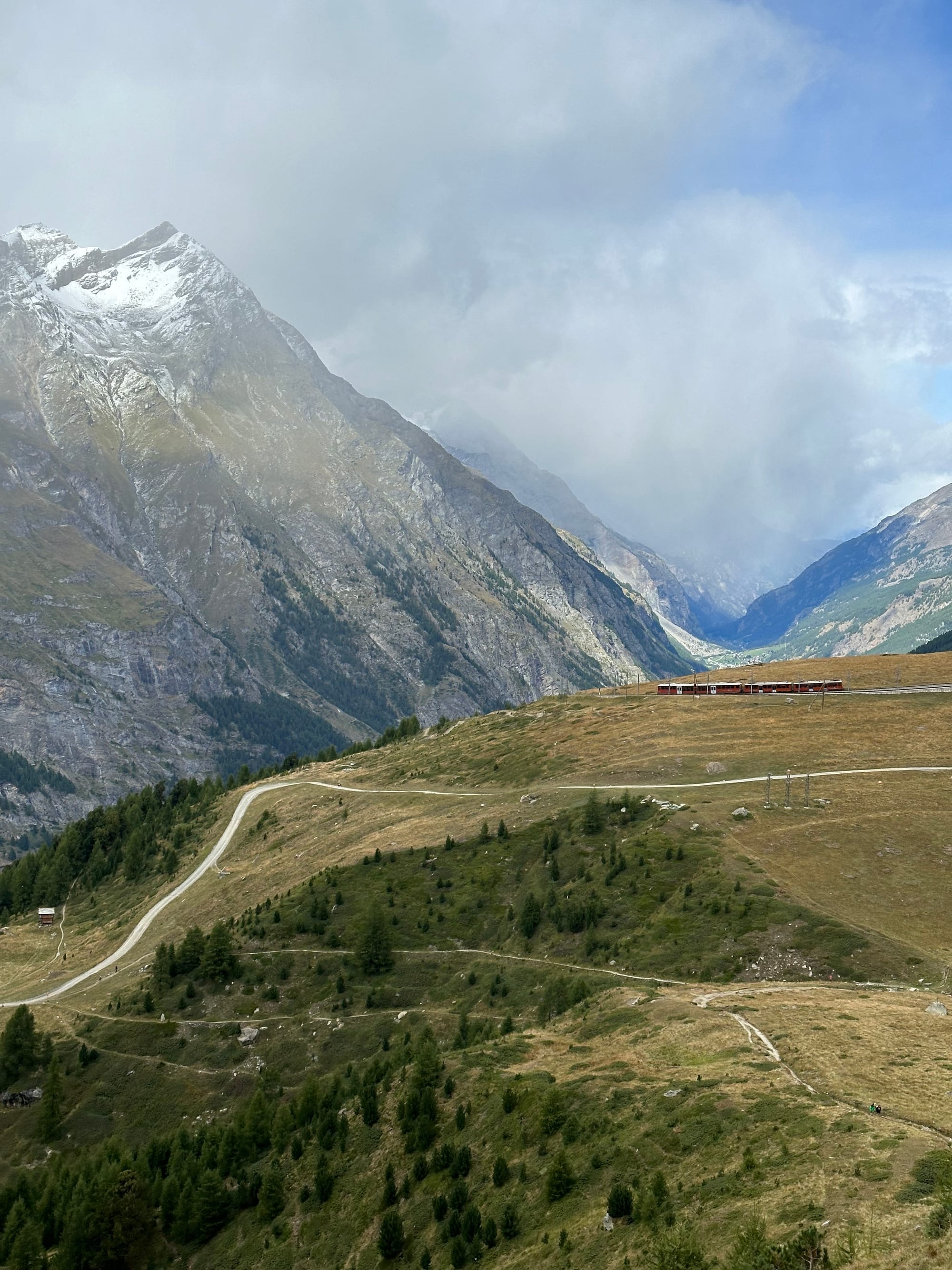
Hiking down near Riffelberg
Hotel Chäserstatt (Goms region)
We had to leave Zermatt and Matterhorn around 4pm. It was a 1.5 hour drive to our next hotel for that night - Berghotel Chäserstatt.
The idea was that it was a good mid-point between Zermatt and Lauterbrunnen, where we wanted to go to the next day.
Chaserstatt is a mountain lodge, perched up high on a grassy plain at 1700m elevation. We chose it for the location and view. Plus it was pretty affordable (for Switzerland) at 120 francs per night.
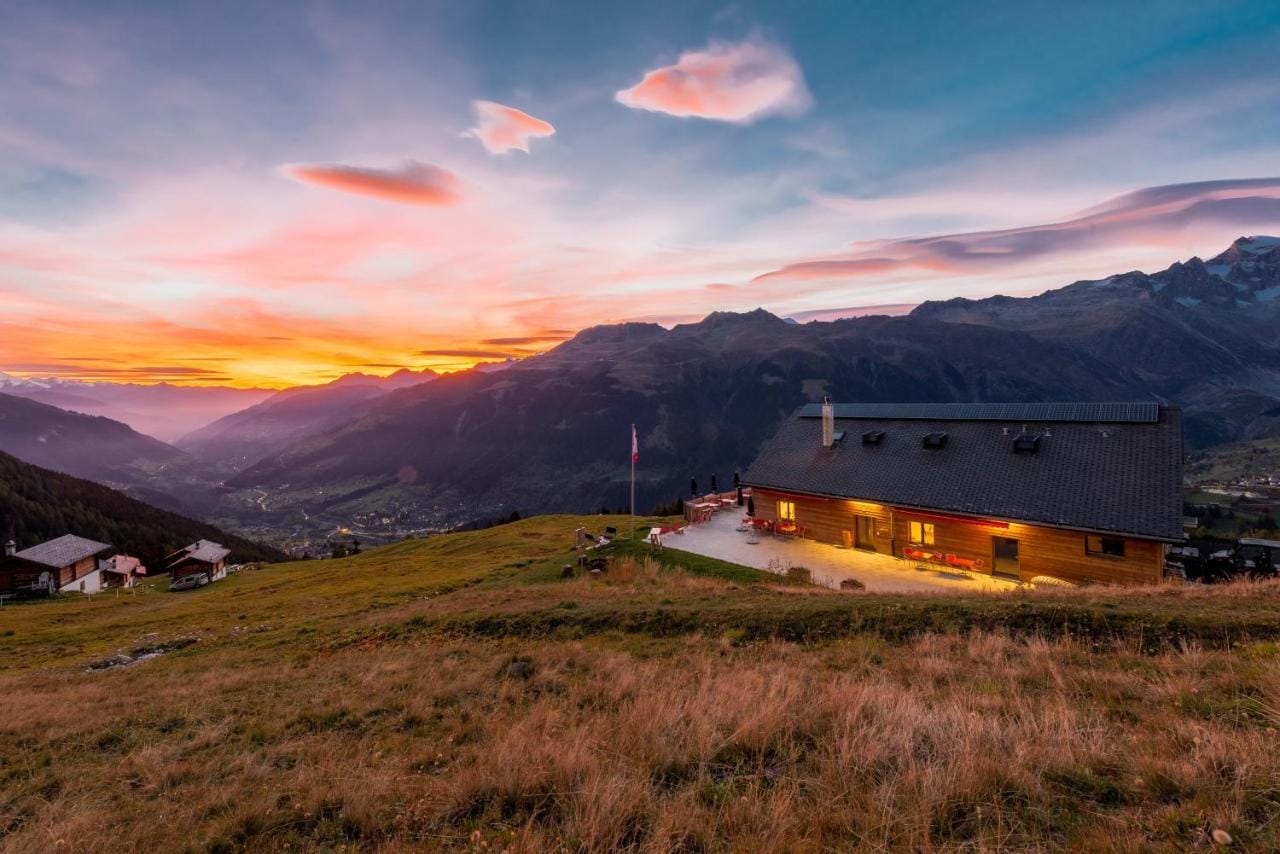
The only problem was that the road there was extremely steep and winding, and only gravel in some sections - and we were on a BMW M4 - a precision machine built for speed, not offroad adventures! The car was very low to the ground with a stiff suspension. I was a bit worried driving up, but the views were beautiful - it even started snowing.
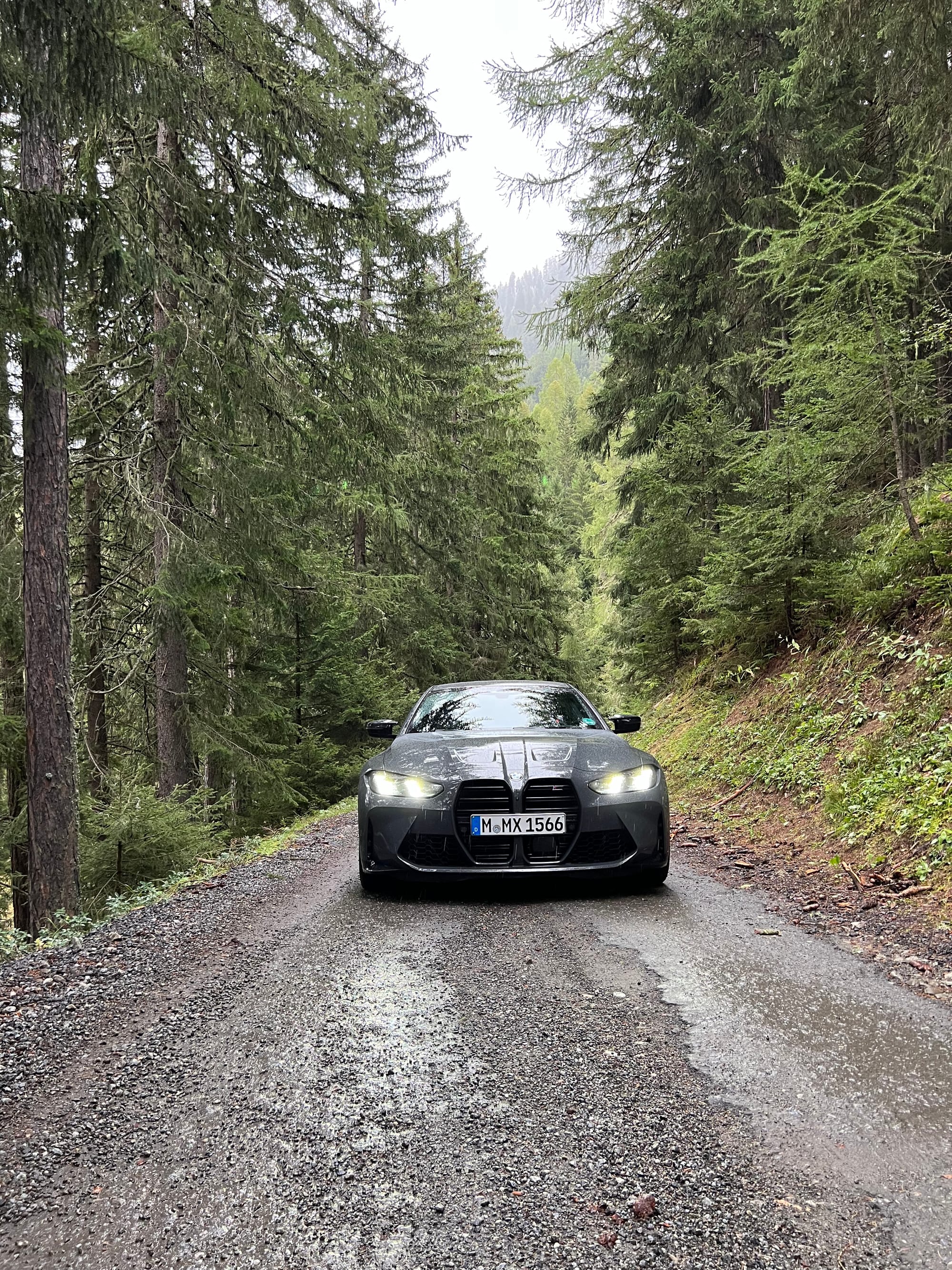
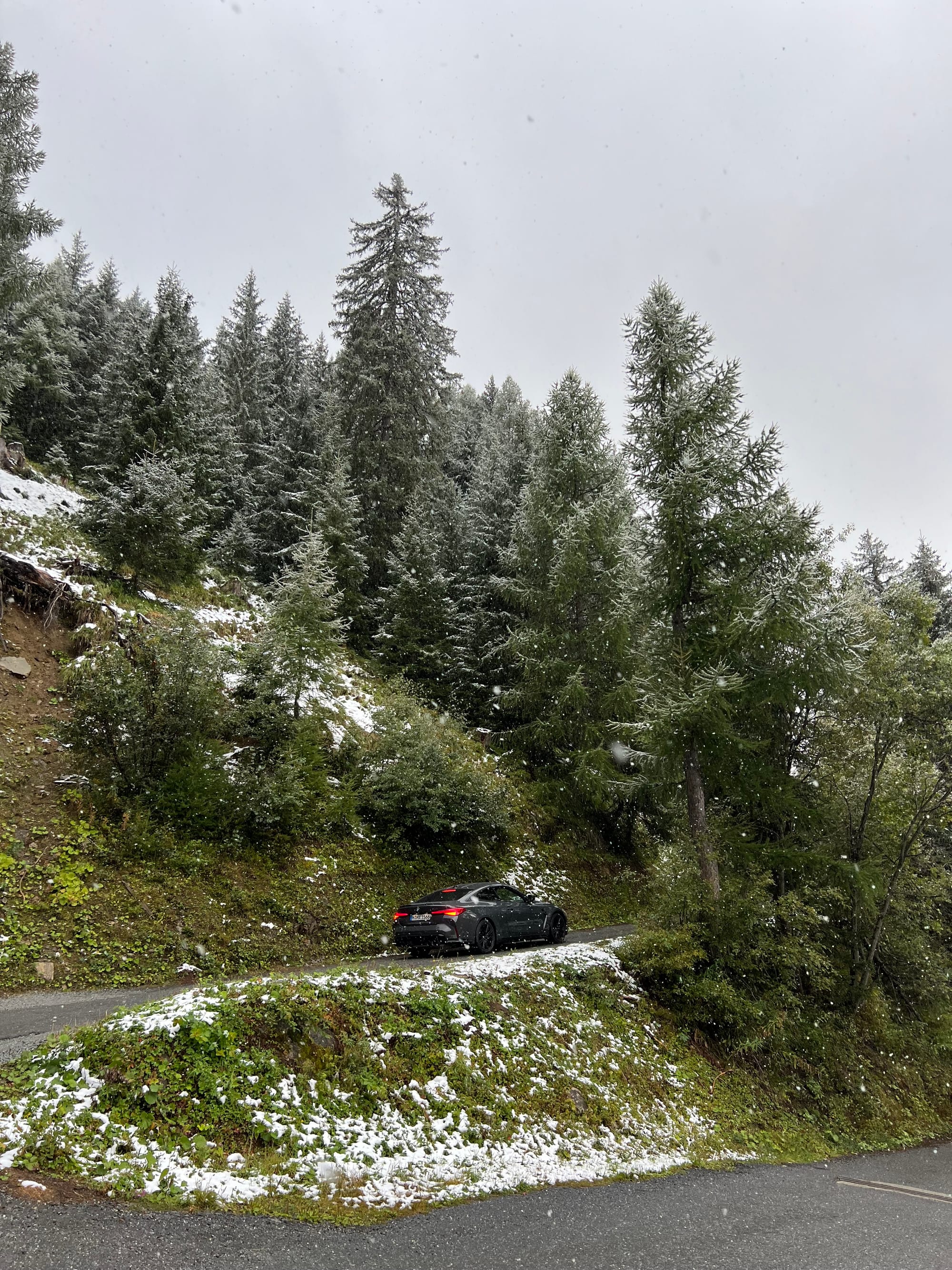
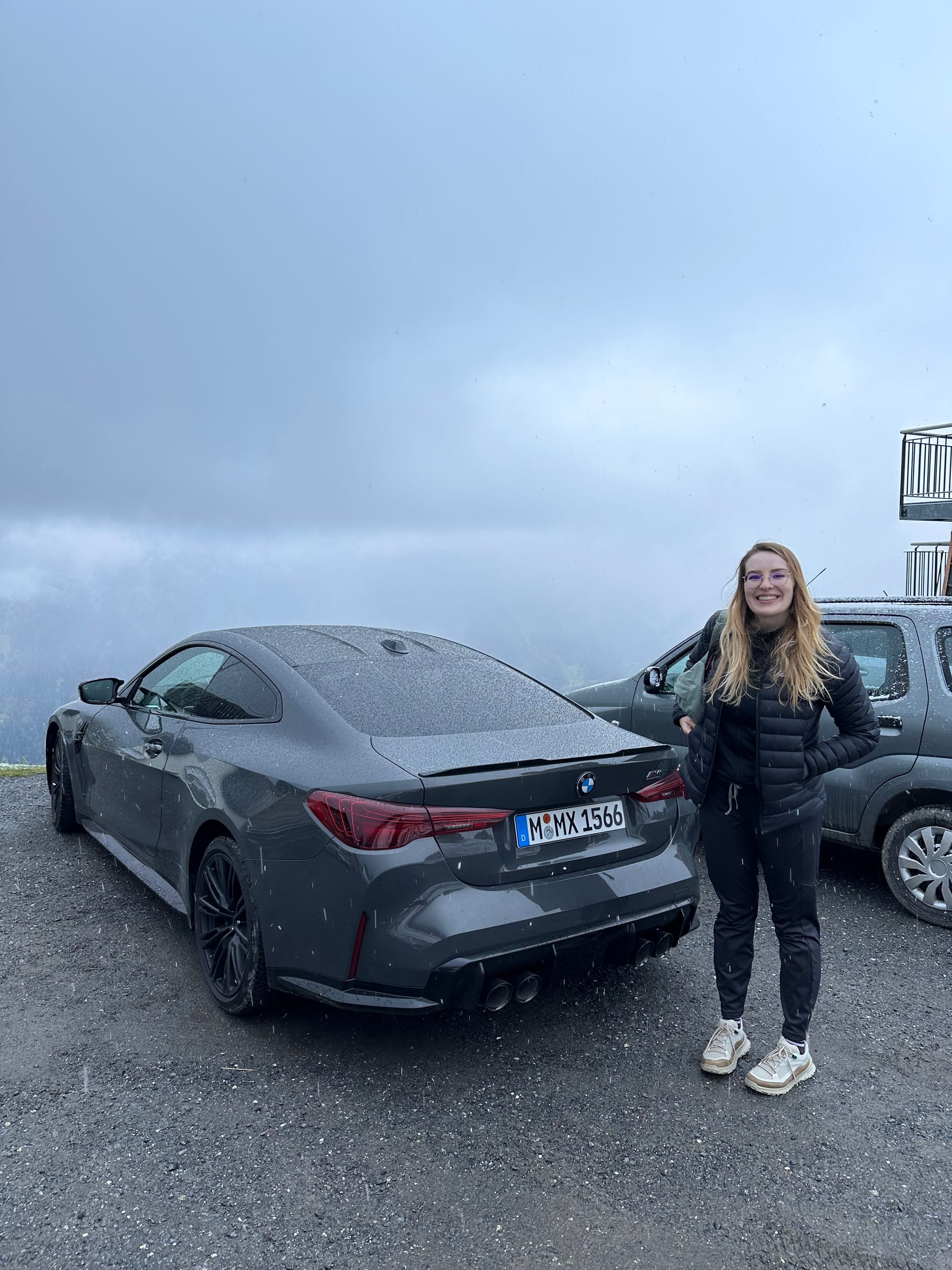
Driving up to Hotel Chäserstatt with the BMW M4 Competition
We didn't see much at night, but in the morning we were greeted with the most amazing view we've ever seen from a hotel window.
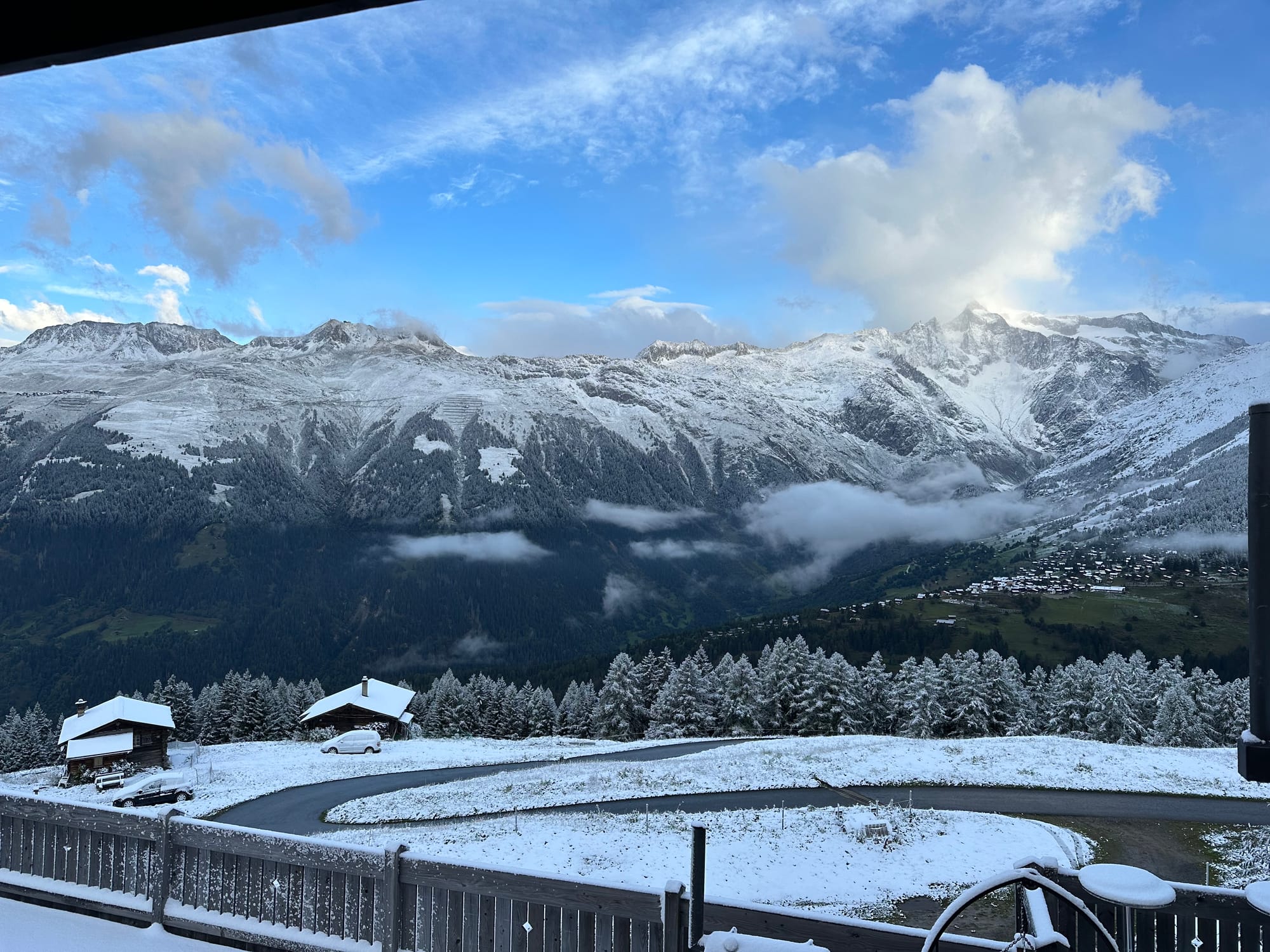
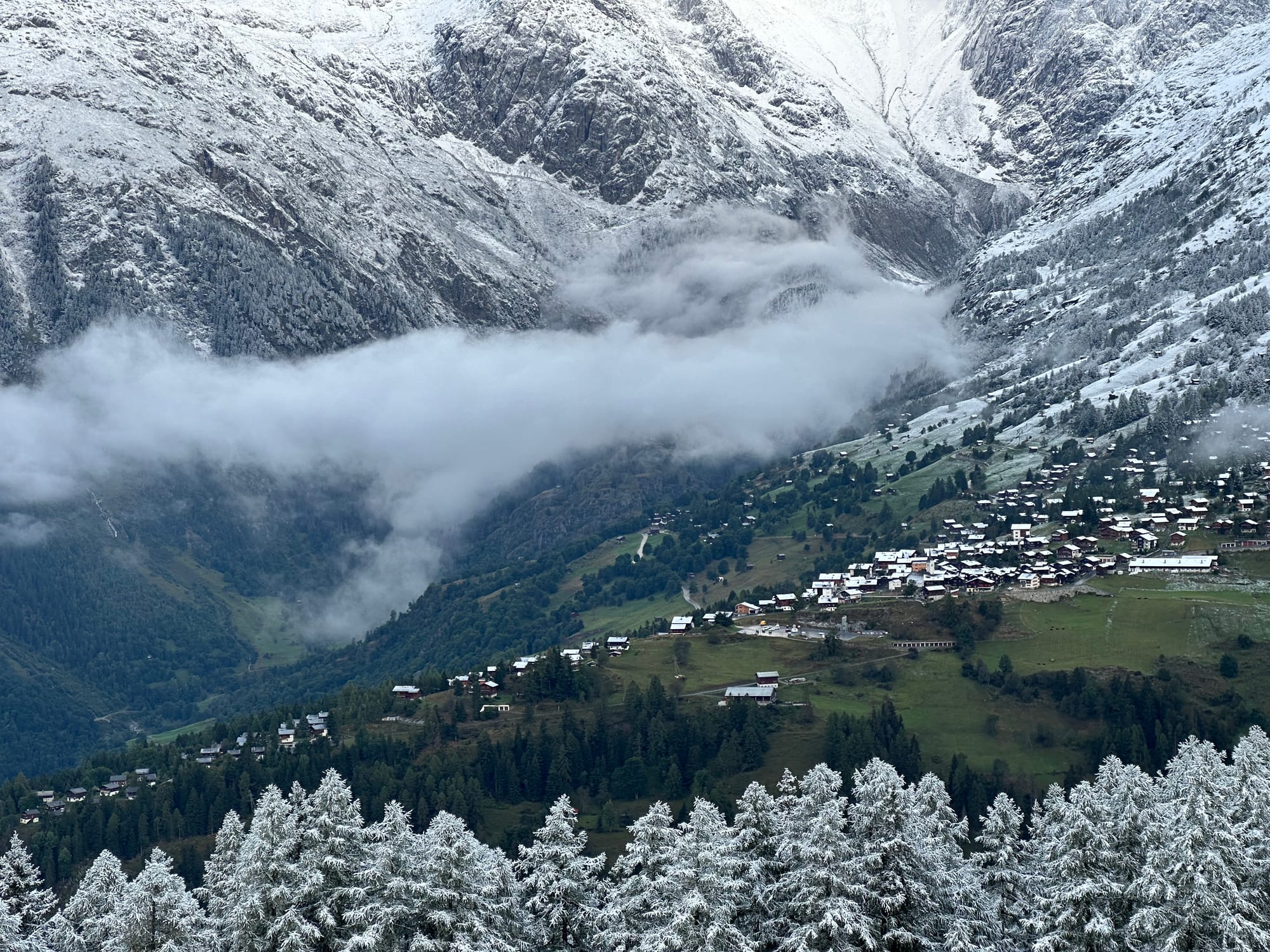
The view from our window
From Chäsertstatt to Lauterbrunnen
I was excited for this day. We were going to Lauterbrunnen via the Grimsel pass - a road that is famous in the motoring world, and also among serious cyclists.
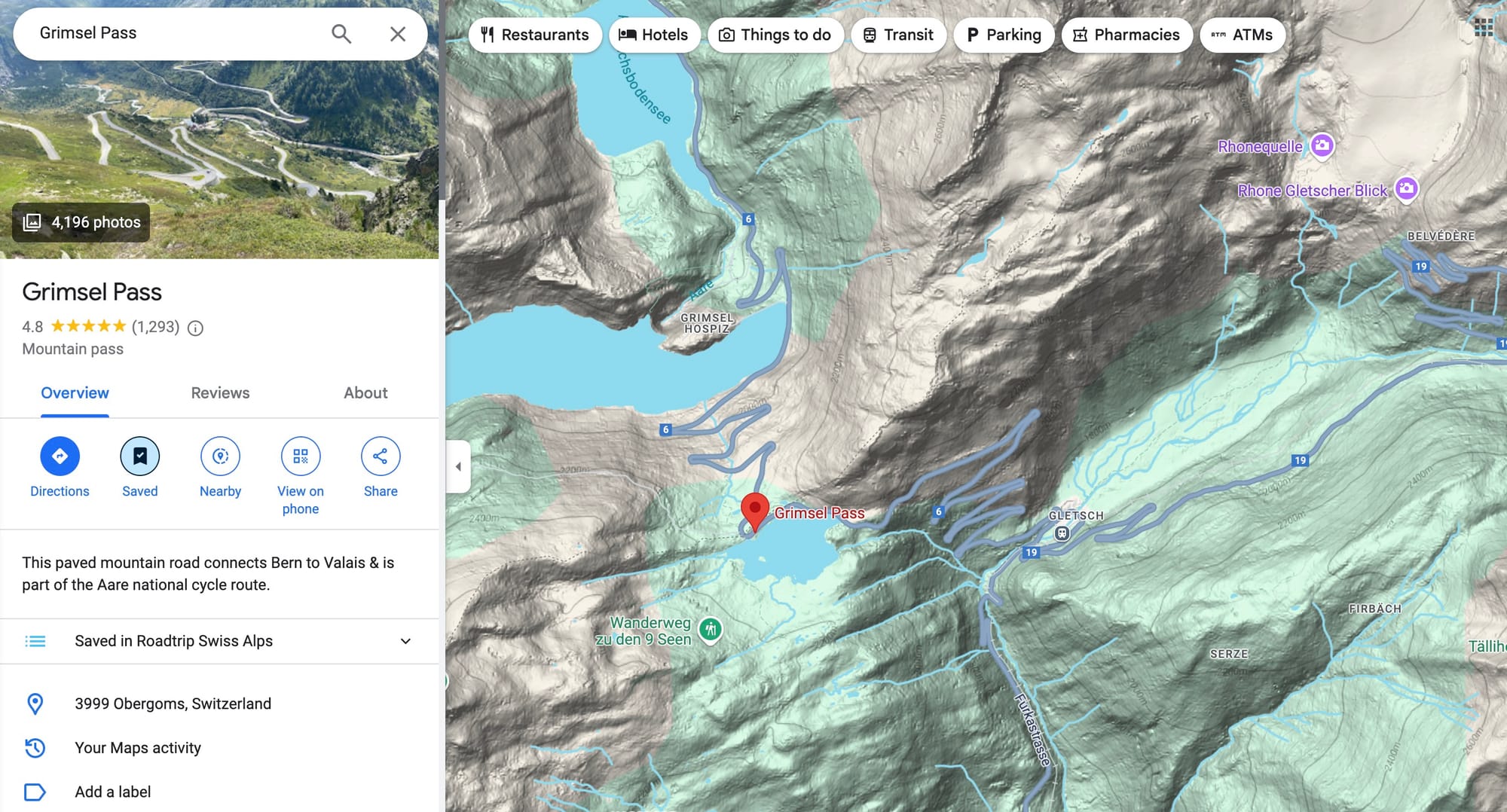
But as I checked our route that morning, I saw the pass was closed due to snow!
Apparently, they close the passes any time there is even a bit of snow. They are too dangerous, and in September there may still be tourists on summer tyres. It was summer just two weeks ago!
You can check the live status of all Swiss passes on the Alpenpässe website.
*What is a 'pass' anyway?
In case you haven't visited lots of mountains - a pass is a corridor through a mountain range. It's a place flat enough that a winding S-shaped road can be built there, and the mountains can be crossed.
There aren't many passes, historically they have been very strategic locations for armies and trade, and they can often become snowed in and uncrossable - meaning you need to take the long way around.
Just like Gandalf and the Hobbits, we had no choice but to go through the Mines of Moria (Lotscheberg tunnel), again.
It was still a great drive, and we got to Lauterbrunnen around 2pm.
Lauterbrunnen
In 1911, a 19-year-old boy by the name of J.R.R Tolkien visited Lauterbrunnen.
It became his inspiration for Rivendell - the utopian elf city featured in "The Lord of the Rings" and "The Hobbit".
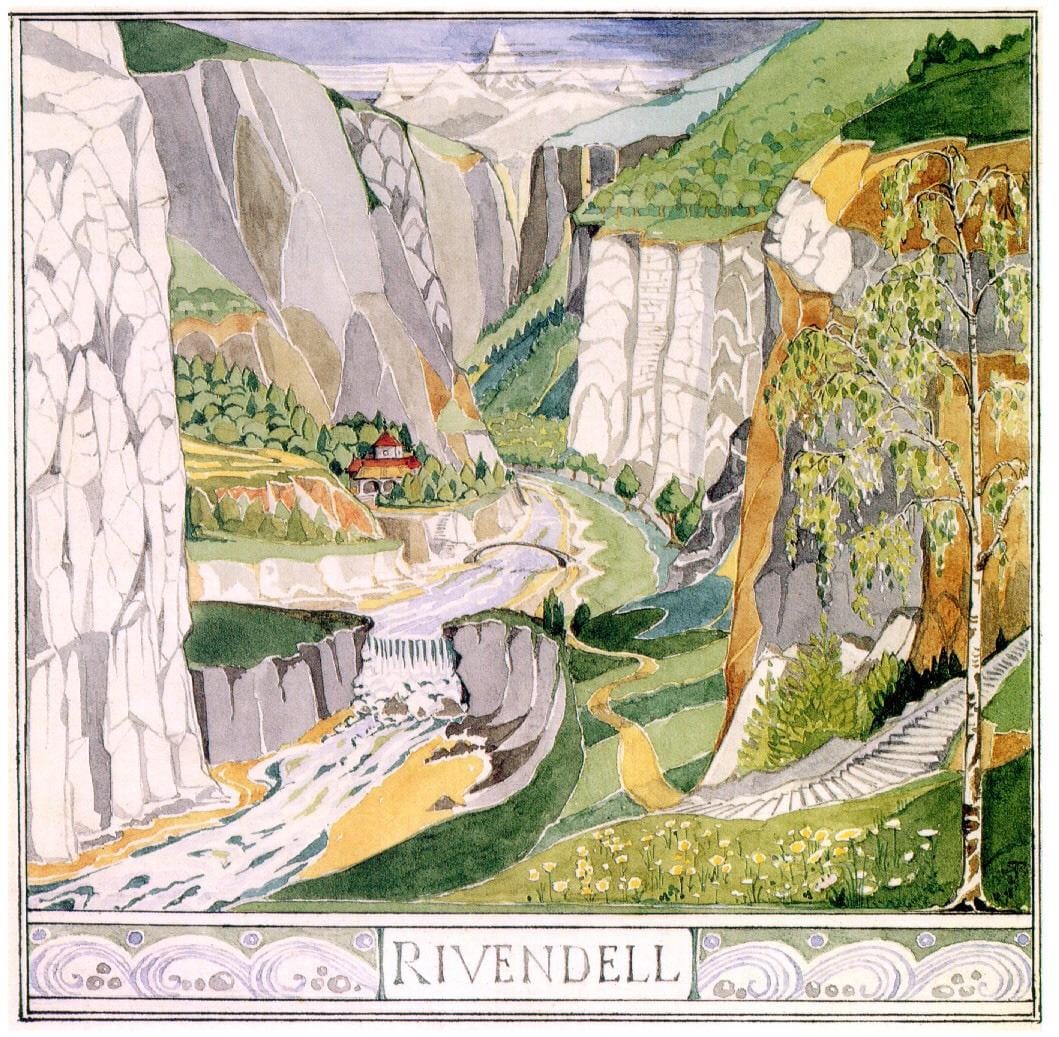
Lauterbrunnen matches his description of Rivendell perfectly - a lush green valley surrounded by mountains and waterfalls, with icy peaks in the background.
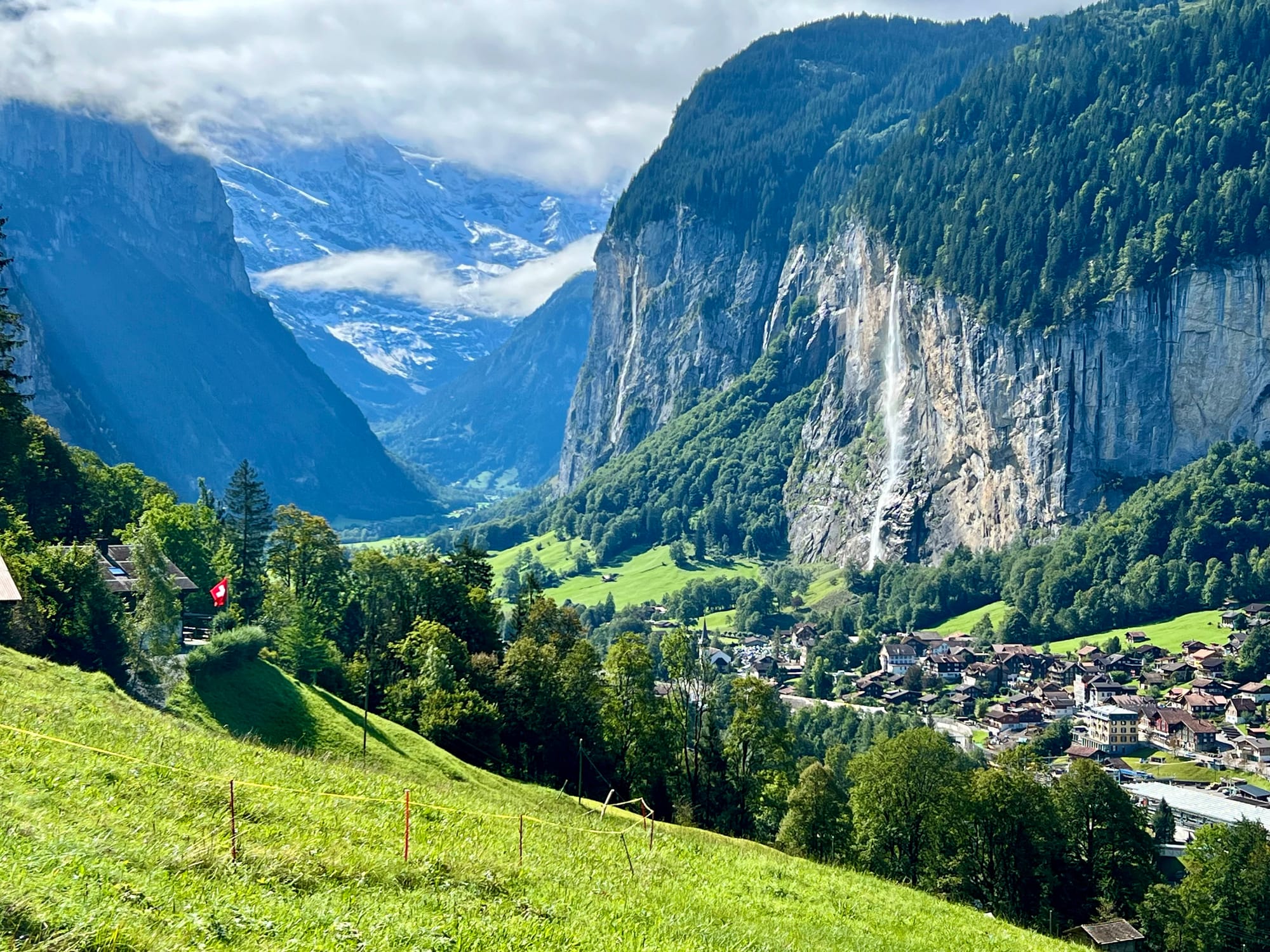
Lauterbrunnen was probably the highlight of the trip for us. It really looks like heaven on earth.
We got here in the second half of the day, and had only a few hours of daylight left to enjoy. So we decided to do a small walk along the village itself. Everywhere is beautiful - you don't need to go far.
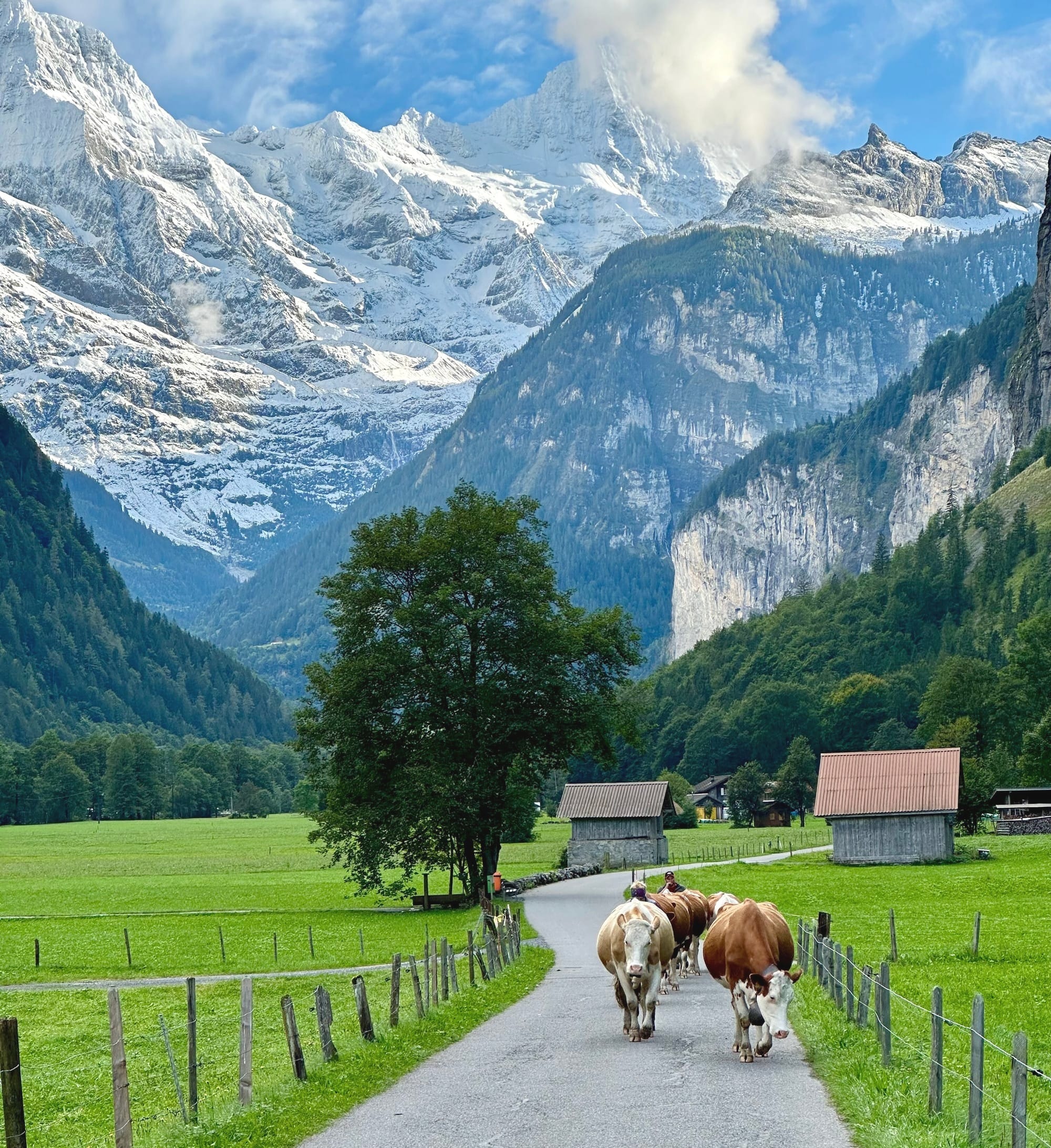
We were very lucky to be here during the "alpine descent" - a festive period when they bring the cows down from the higher pastures, closer to home for the winter. So we saw a lot of cows, they were all wearing the bells typical to the alpine regions. You can hear them from far away, echoing around the valley, their lack of rhythm is surprisingly pleasant.
We wanted to walk to the Trummelbach Falls and back. I didn't research and thought it was a regular waterfall, like many others in Lauterbrunnen.
It turns out, it's a waterfall inside a mountain - partly an underground cave system and partly a ravine. I've never seen anything like it. The Swiss again built an impressive infrastructure - you walk up through the inside of the mountain, passing several viewing platforms for parts of the waterfall. There is even a lift if you don't like stairs.
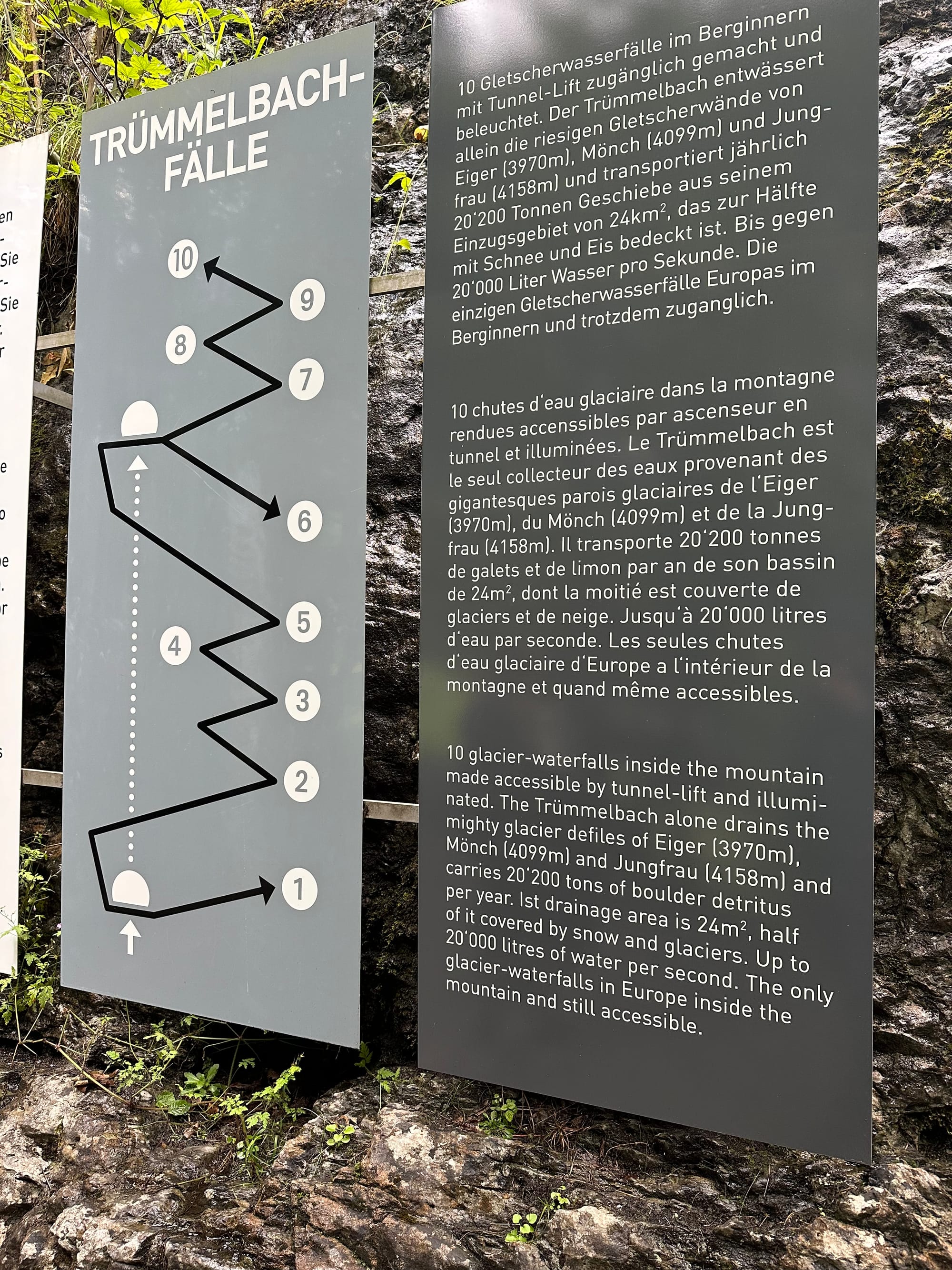
I usually think that waterfalls are no big deal, but this one is definitely worth seeing, and hearing! The narrow spaces seemed to speed up the flow of water faster than gravity, and the crashing sound was immense. It's one of those times you appreciate the power of nature.
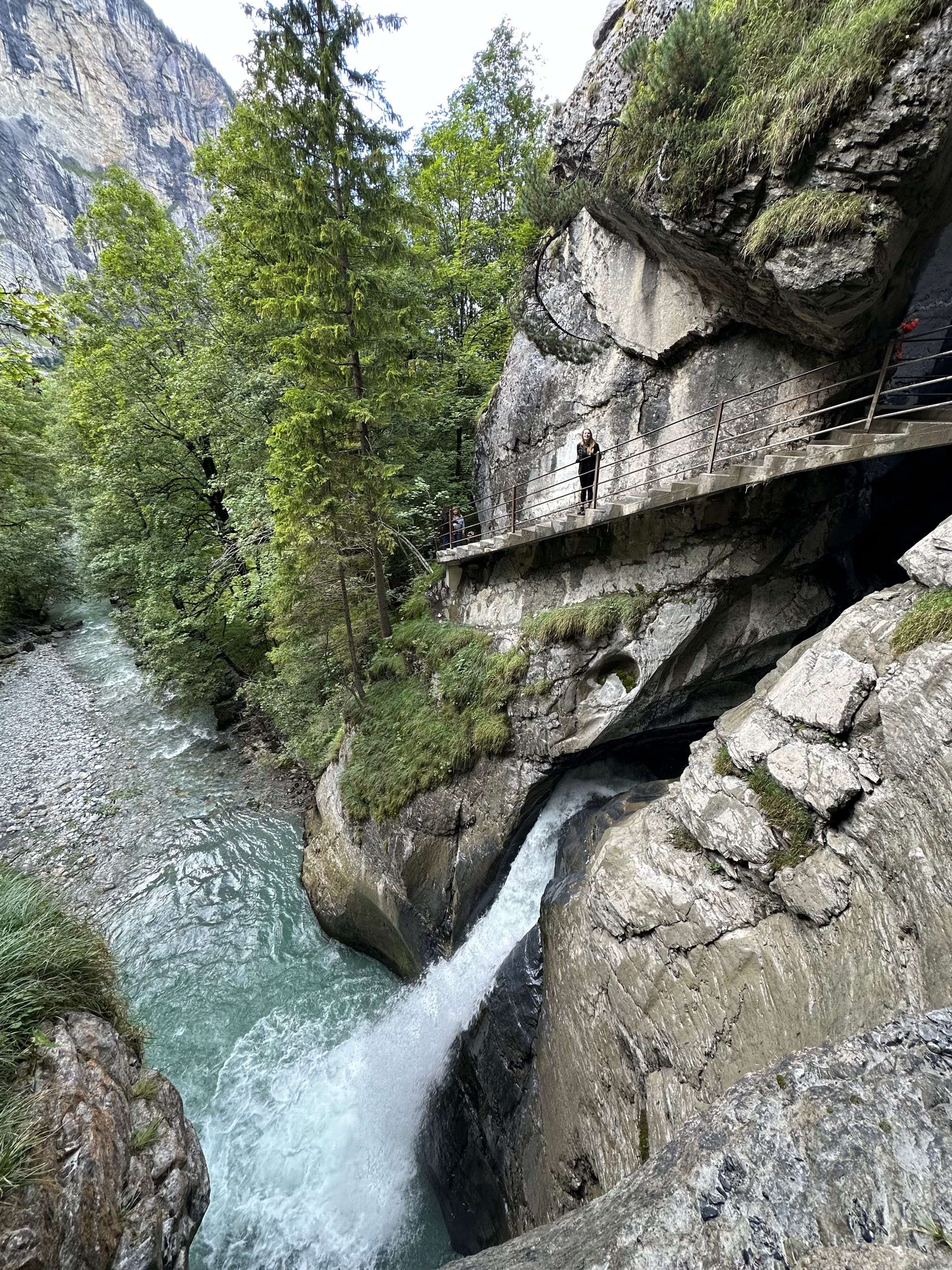
Lauterbrunnen is also known as a world-famous BASE jumping spot. It is completely legal there. People jump from the cliff on the right side of the valley (if looking towards the alps) near the Staubbach falls, a place called 'the nose'.
We saw one base jumper there, or rather, we only saw him when his parachute opened with a loud whoosh. He landed in a pasture below, calmly packed his parachute into a bag and walked away. Nobody was with him.
Shops in Lauterbrunnen close at 7pm and finding dinner at 8pm was difficult. It's a small town after all and it felt completely dead at 8, so if you're a night person, make sure you have food with you.
Lauterbrunnen to Lindau
It was back to Germany today, the last day of our trip, but still a lot to see on the way.
We would pass through Interlaken, Lucerne, Zurich region, and a bit of Austria on the way to Lindau (on the german border) where we would sleep before driving to Munich airport the next day.
Lauterbrunnen morning hike
We woke up in Lauterbrunnen and decided to do a small 2-hour hike there before driving out for the day. The sun was out, everything was perfect.
We did a trail called the Panoramaweg, on Alltrails. It's a small loop that can be done in one hour, but we took our time and spent 2 hours. It takes you onto the sides of the valley where you can see the entire village below.
Tip: Make sure you do the loop clockwise. This gives you the best view of the high mountains in the distance for most of your walk.
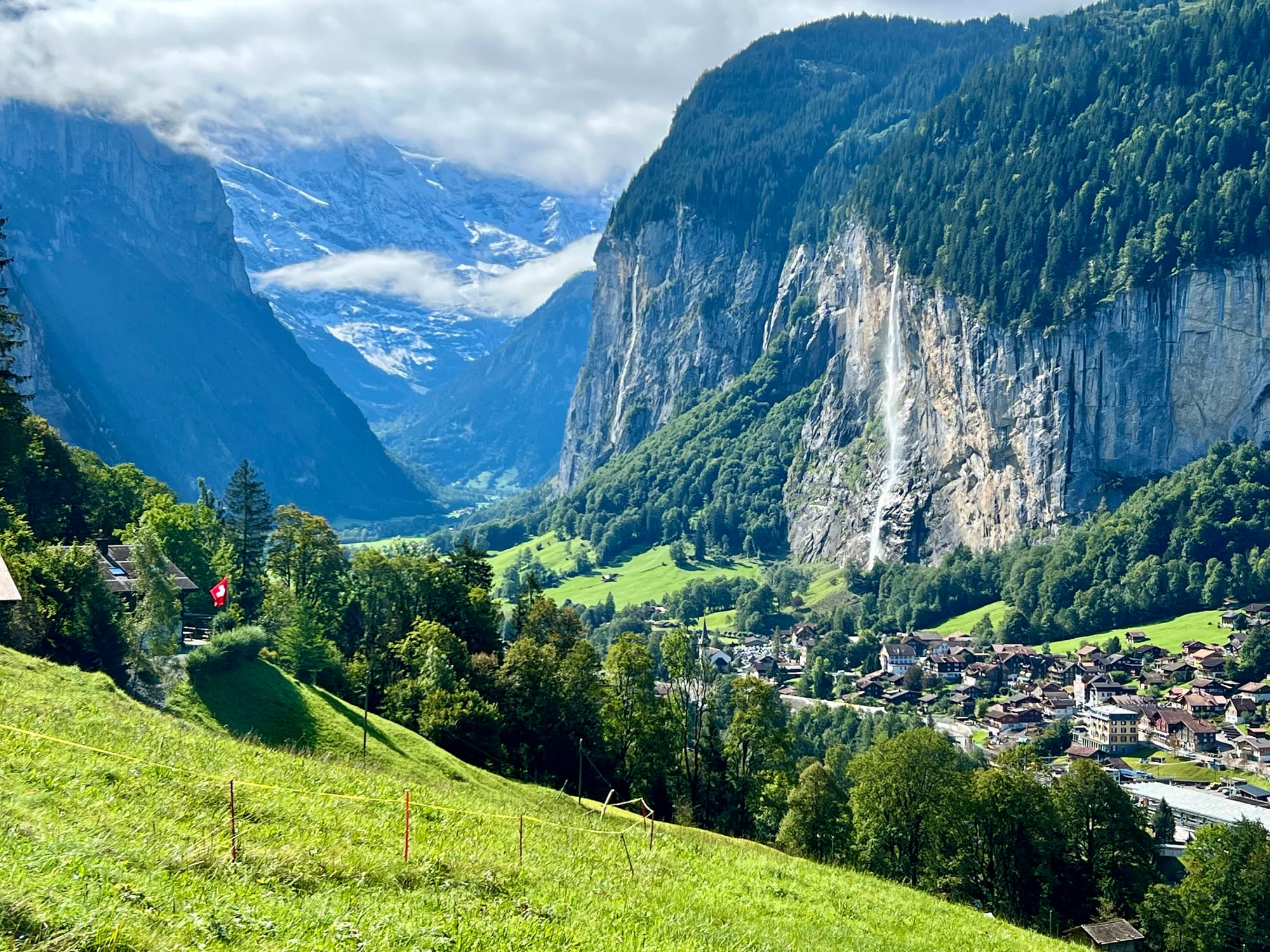
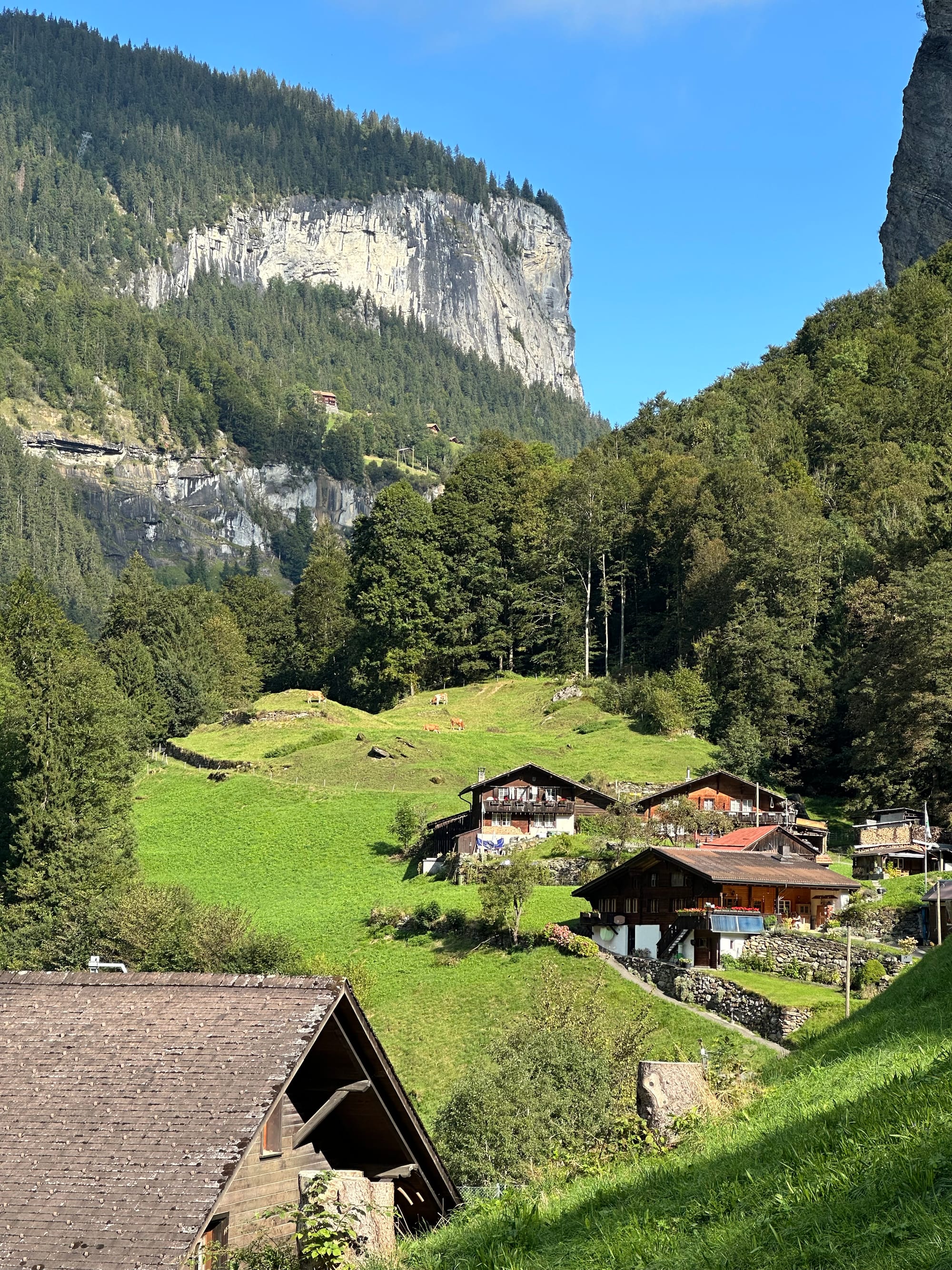
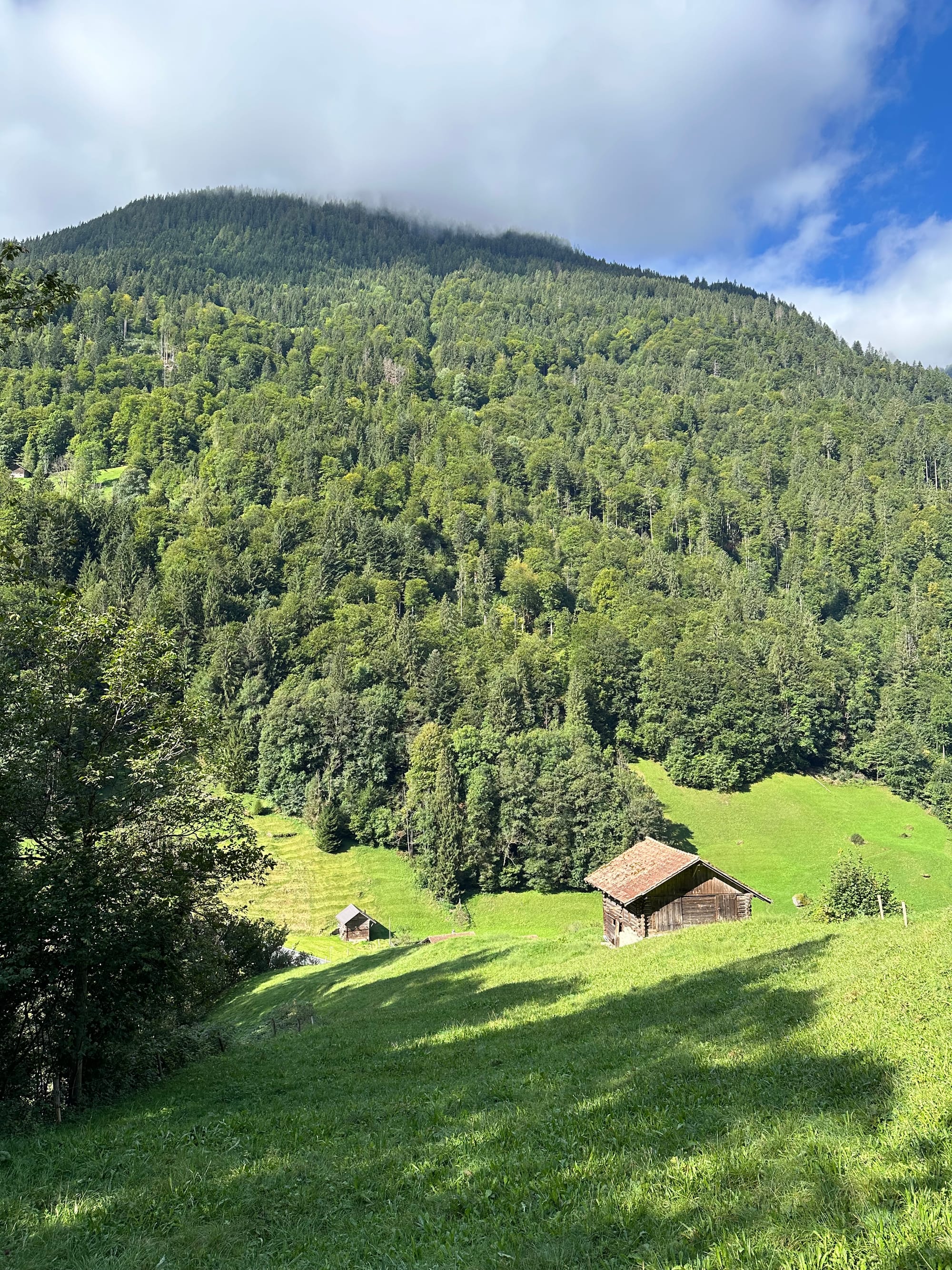
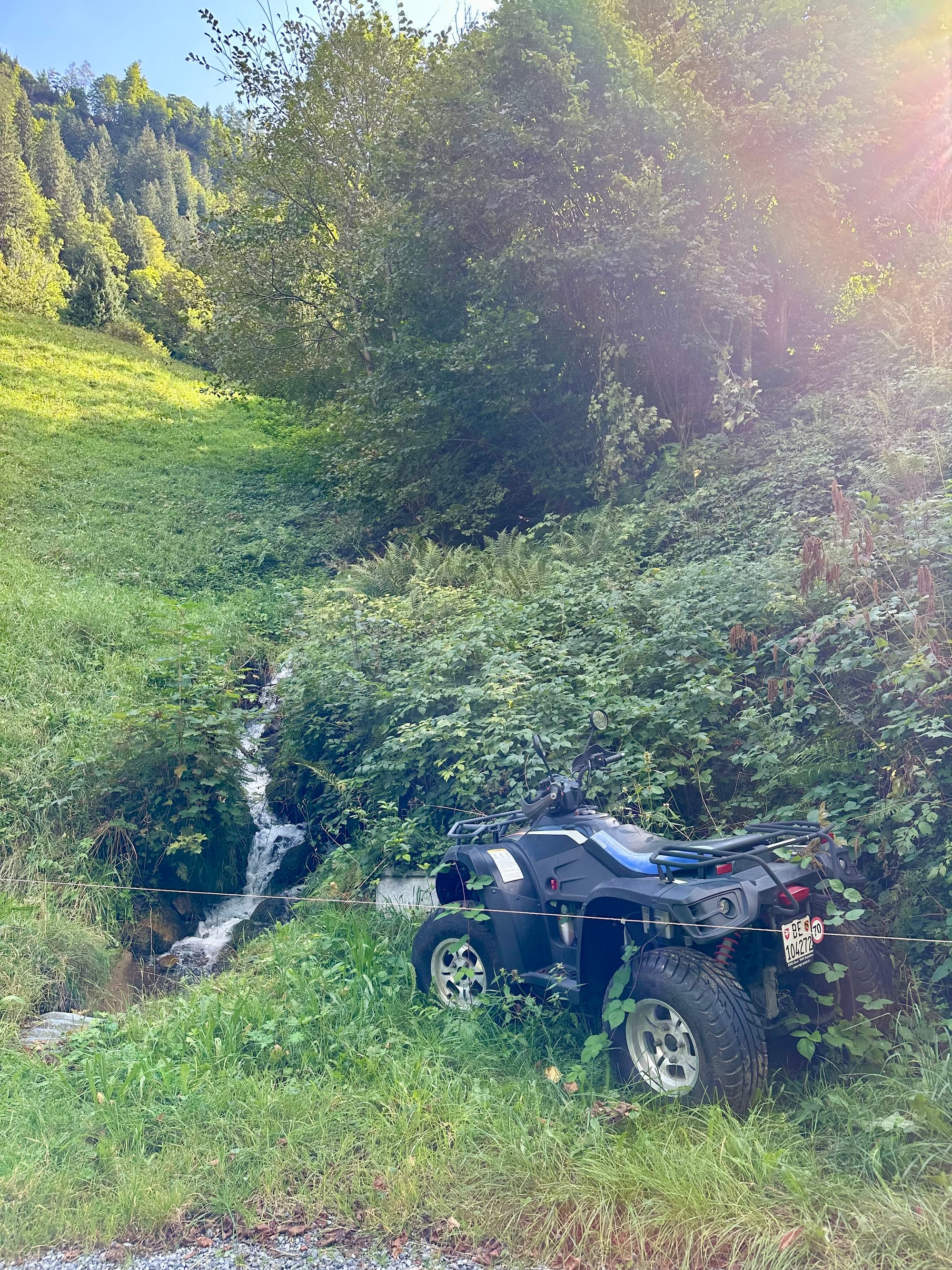
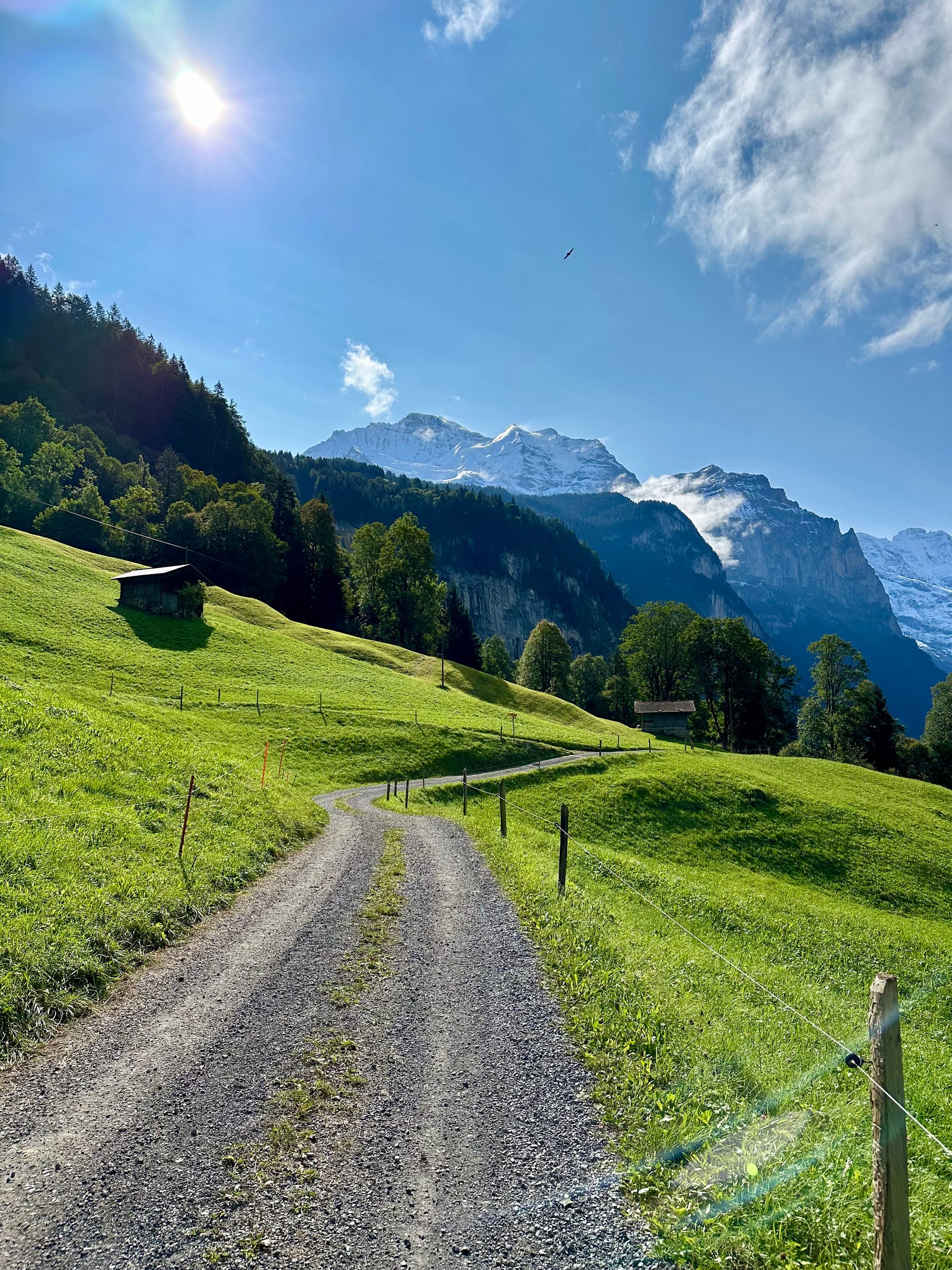
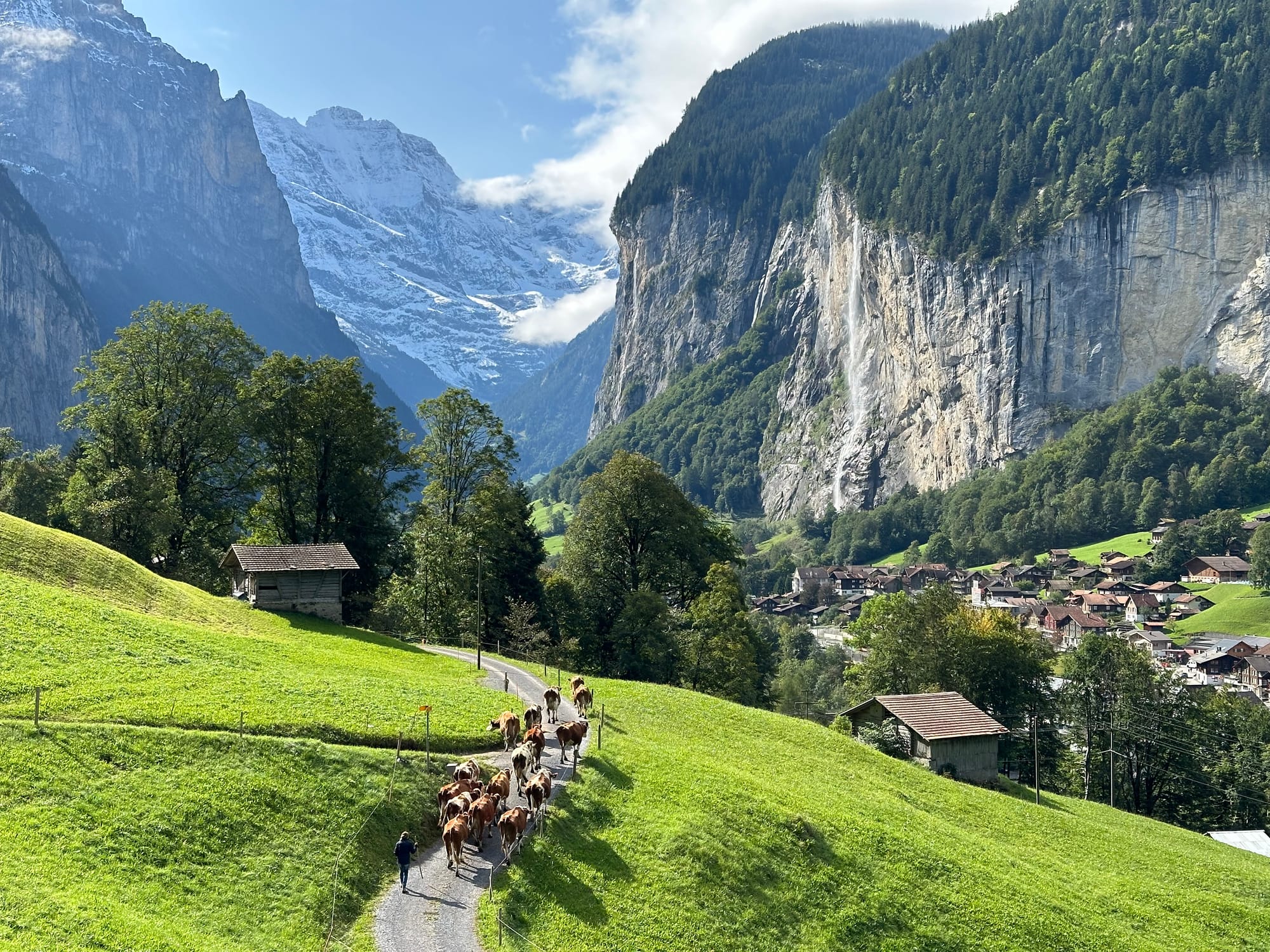
It's perfect if you park in the Lauterbrunnen station parking, because the trail starts around there. I took this photo standing right next to the car, in the parking garage
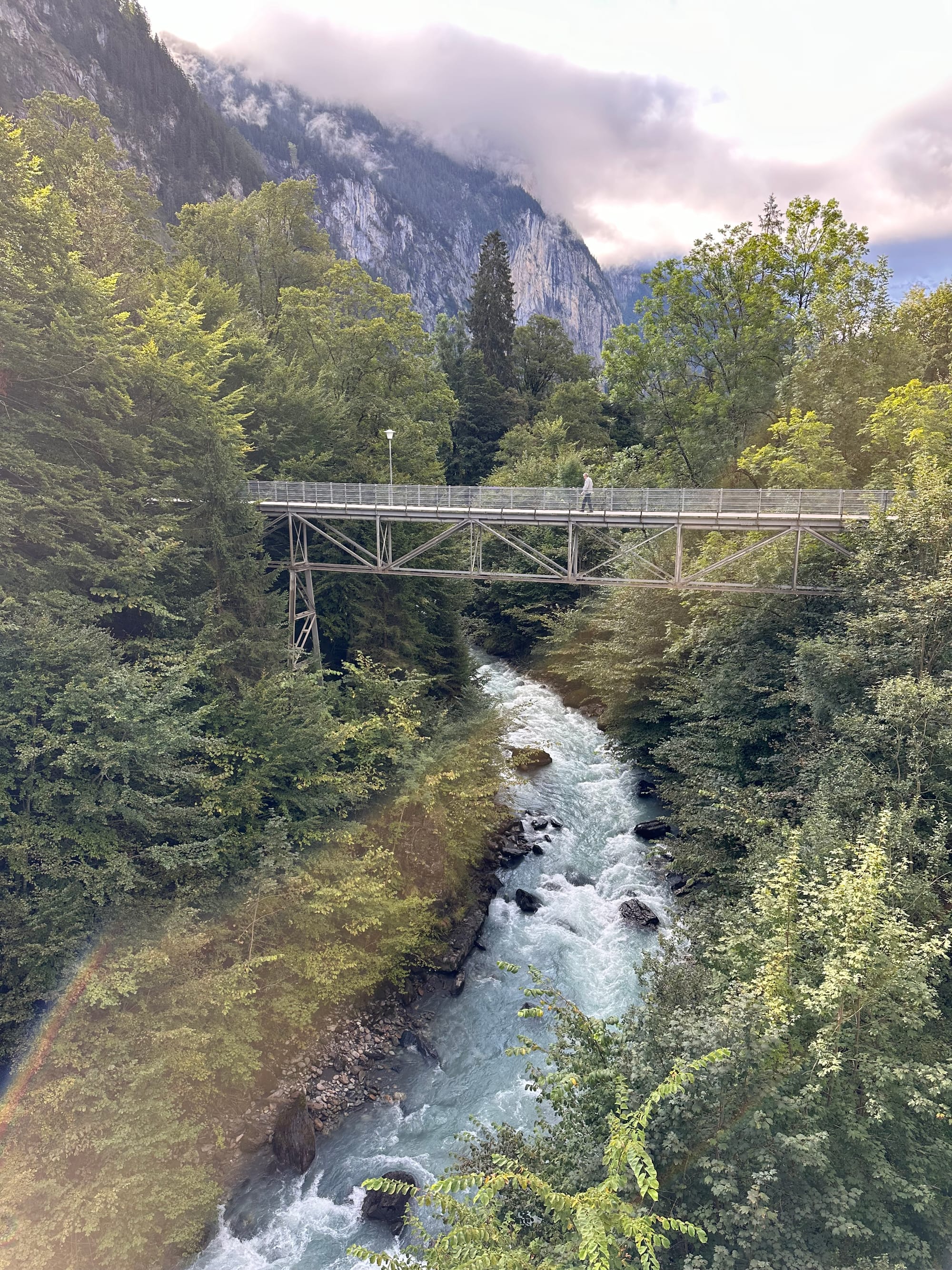
We even went off course a little to go further up the hill towards wengen, where the views are even more spectacular.
Interlaken & Sendli
After leaving Lauterbrunnen we stopped for lunch at a spot called Sendli. It was totally unplanned, we just stumbled upon this epic beautiful place with bright blue water surrounded by corn fields and of course, mountains.
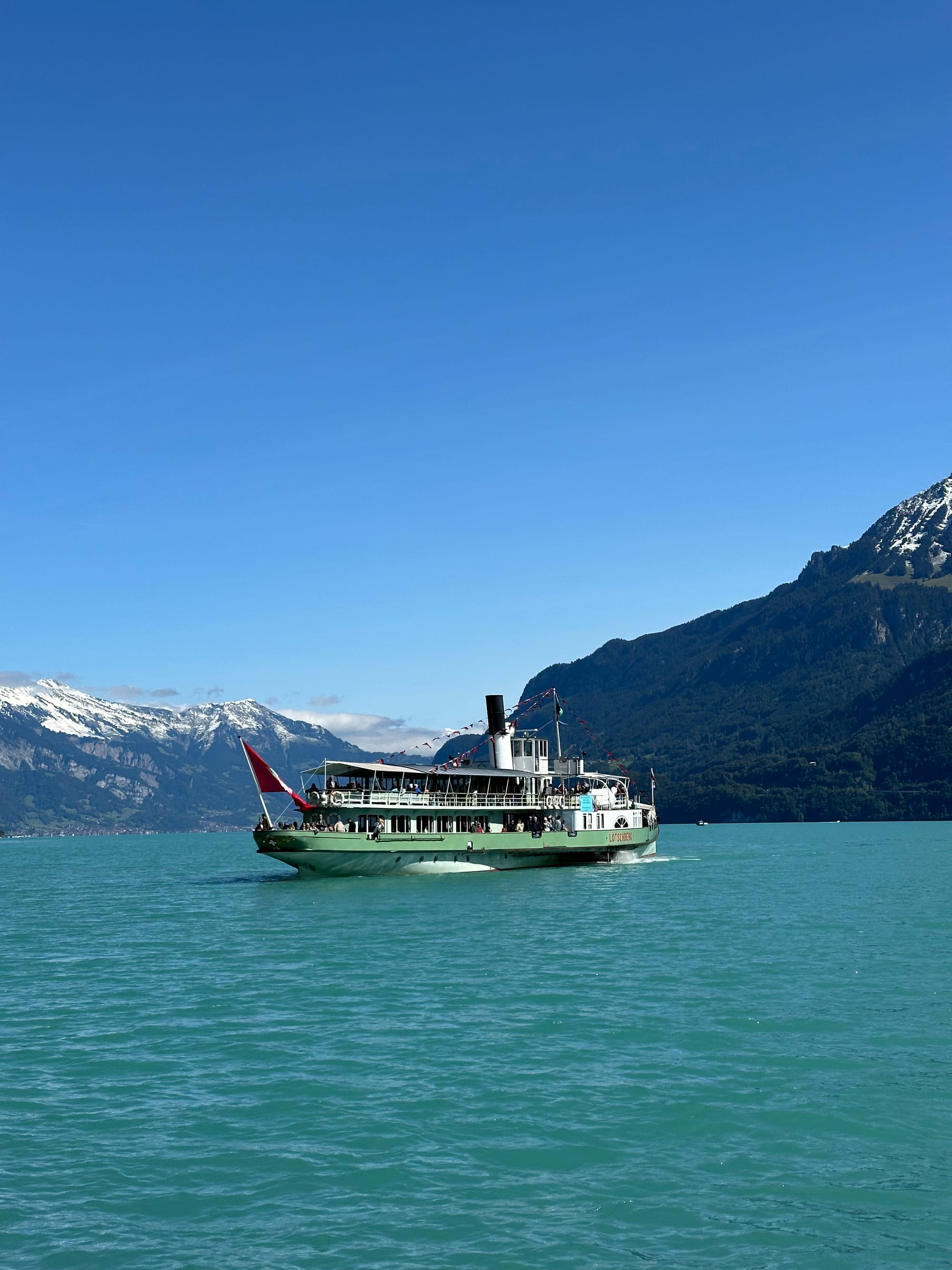

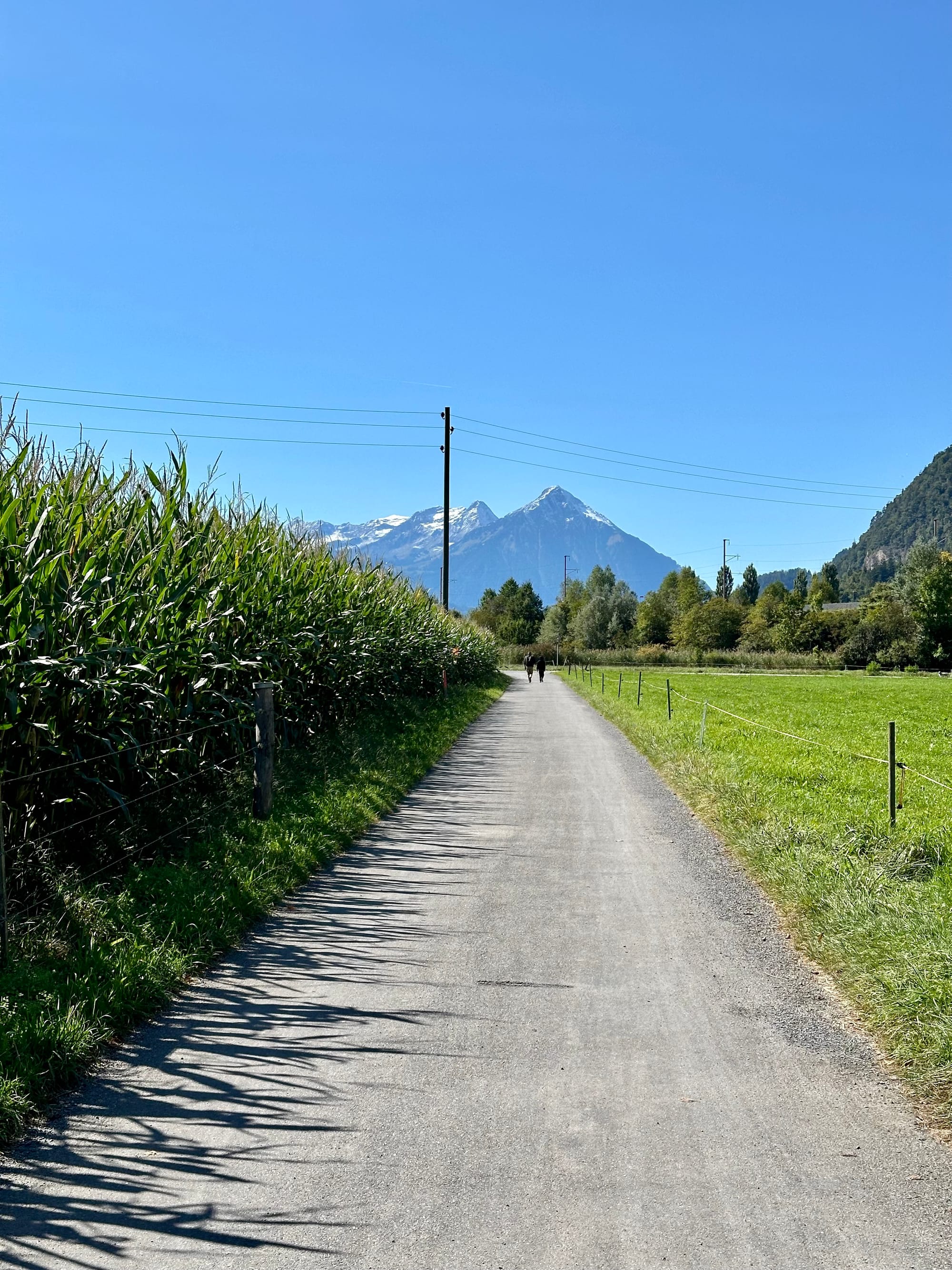
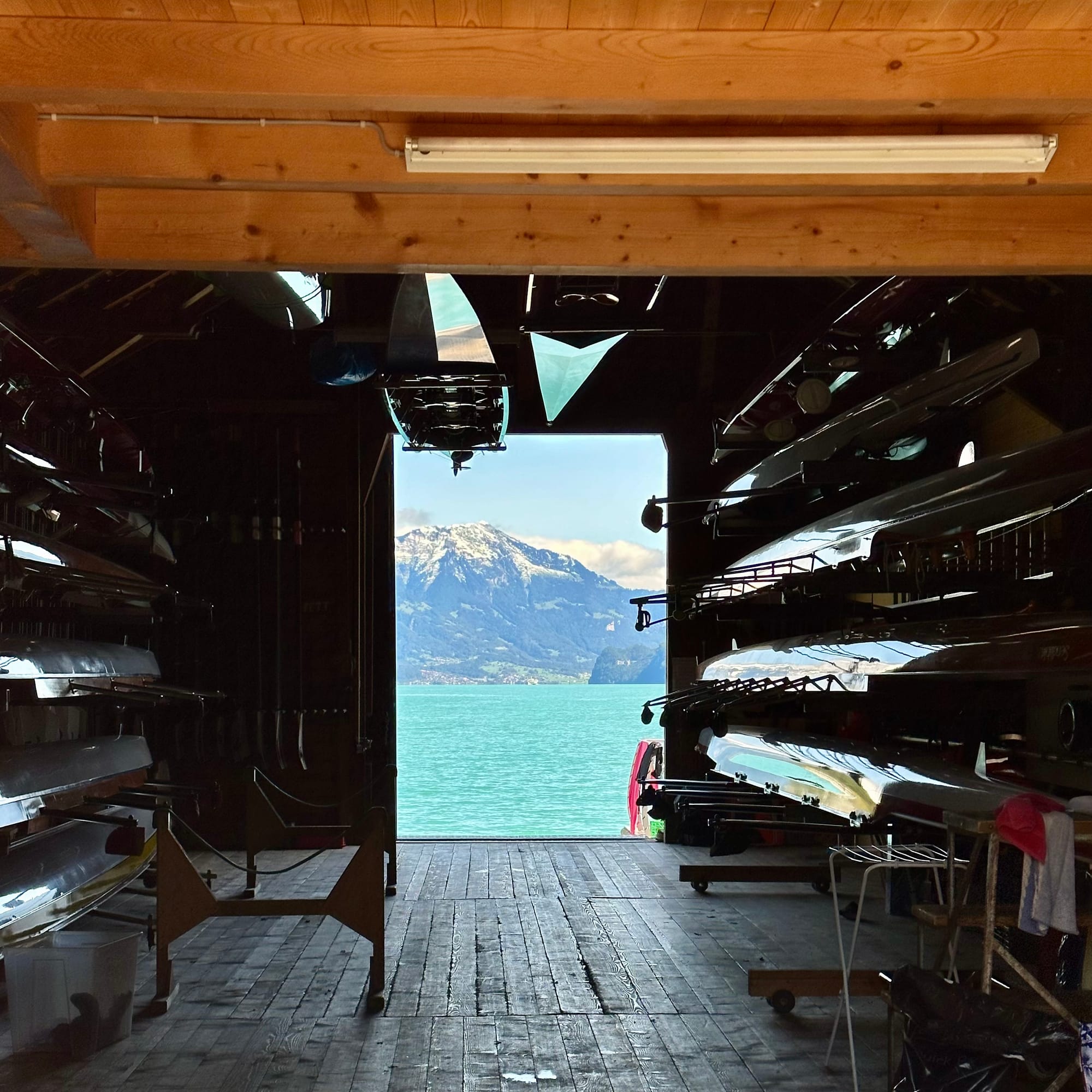
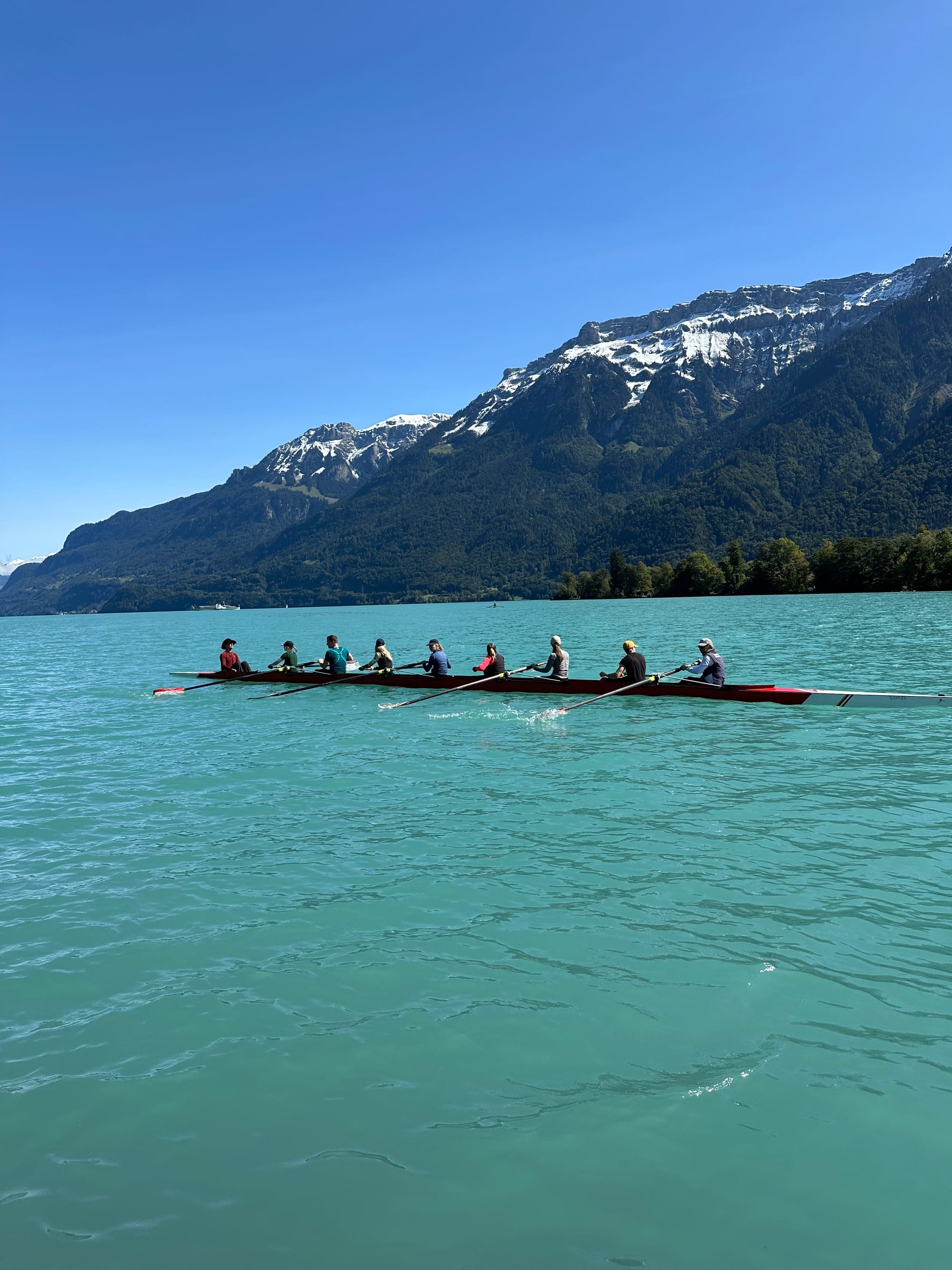
We continued along the lake to a town called Brienz, and ascended through sort of an alpine pass on the Brünigstrasse between Brienz and Lungern.
This was a fun drive with plenty of view points along the way. You can stop in many places along the road, great for car photography!
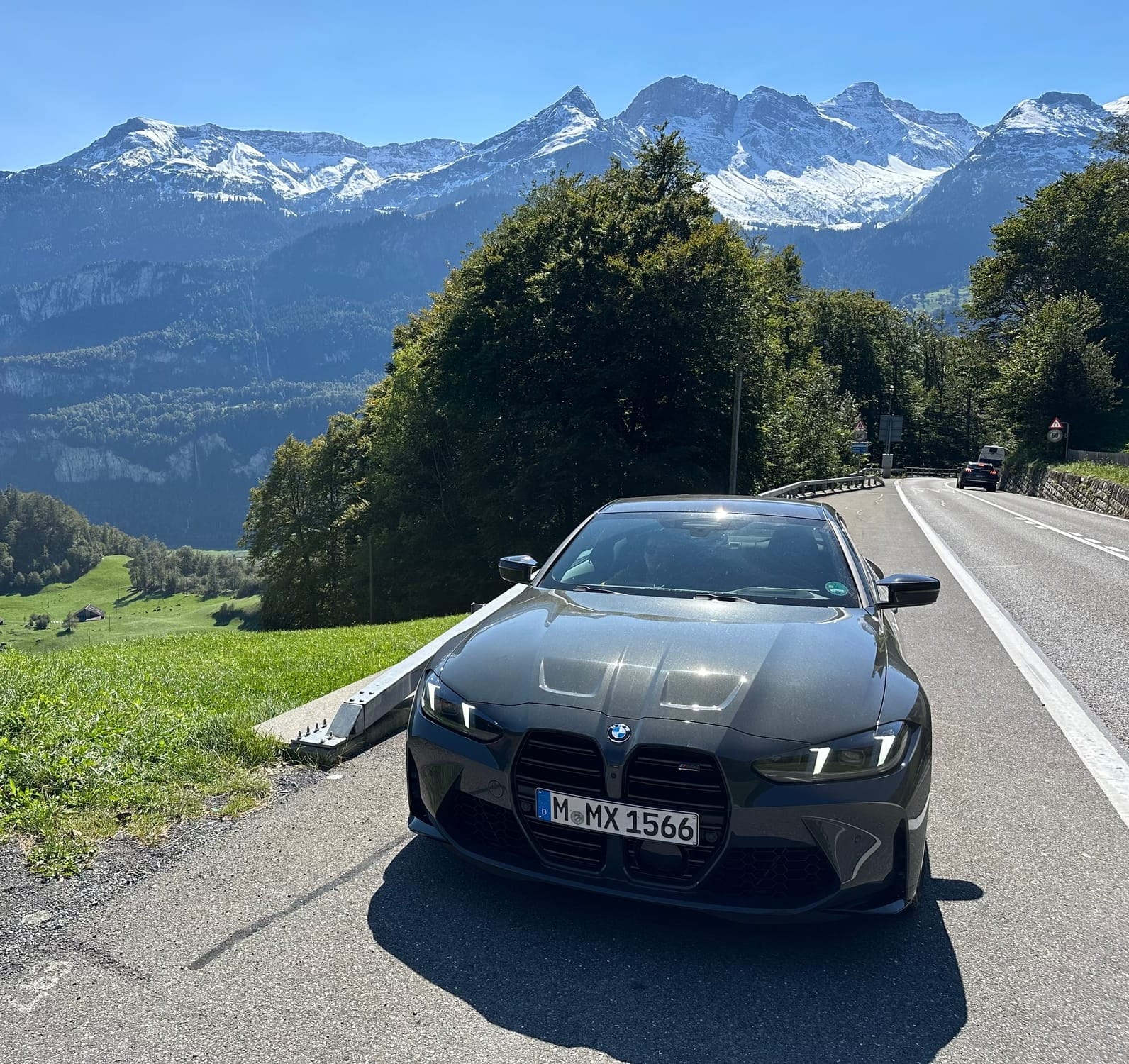
The rest of the drive back to Germany was really chill. Cows were everywhere along the roadside, we stopped several times along petrol stations with epic views. We saw eagles or falcons at one place near Zurich.
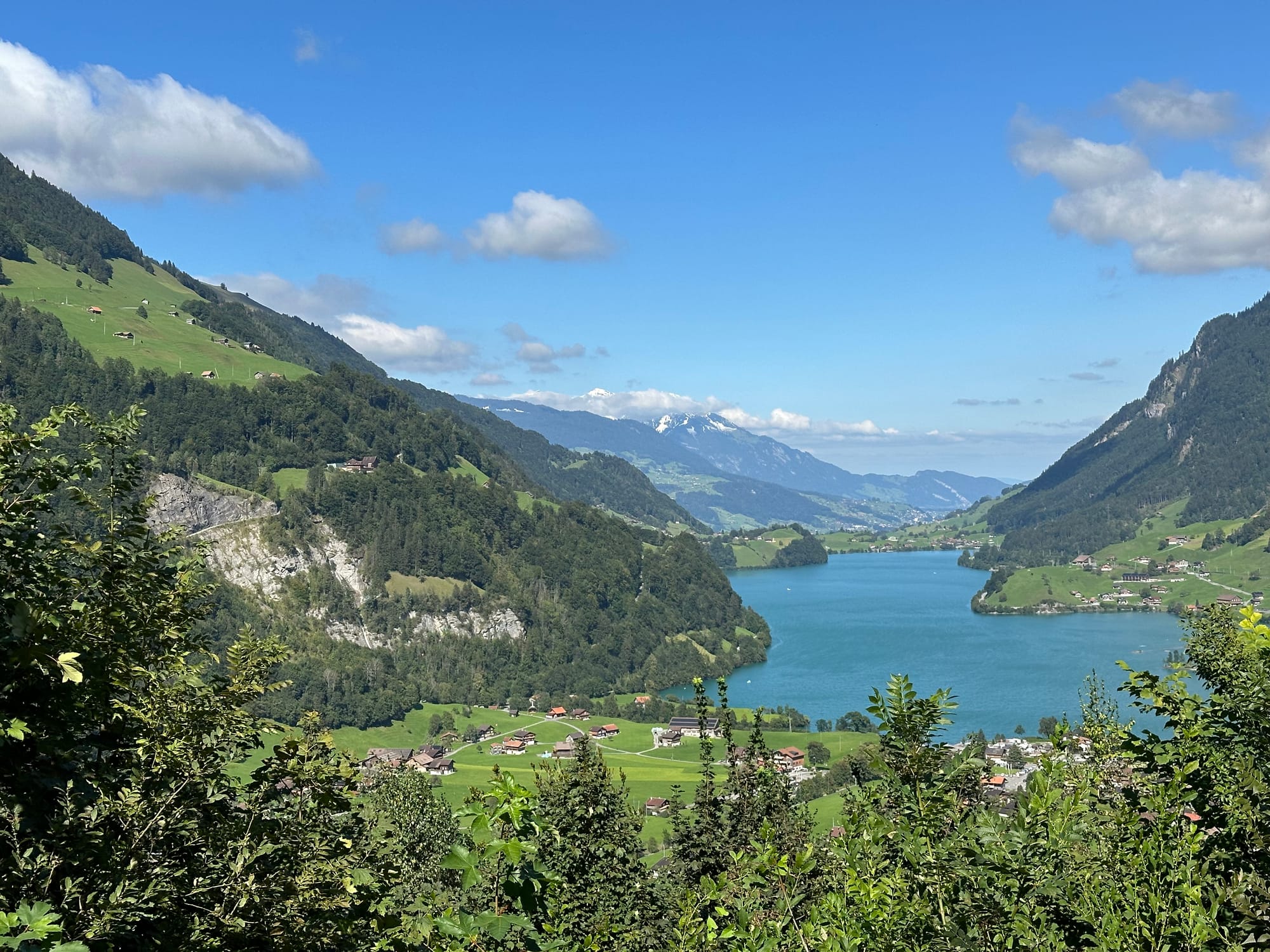
We passed by the Zurichsee, and saw the city of Zurich from a distance. It seemed really nice and small, I think you can easily live in the 'countryside' and commute 20 minutes to the city for work. Imagine having a green pasture with cows at home while working in the office as a programmer. It's not like this in bigger cities around the world.
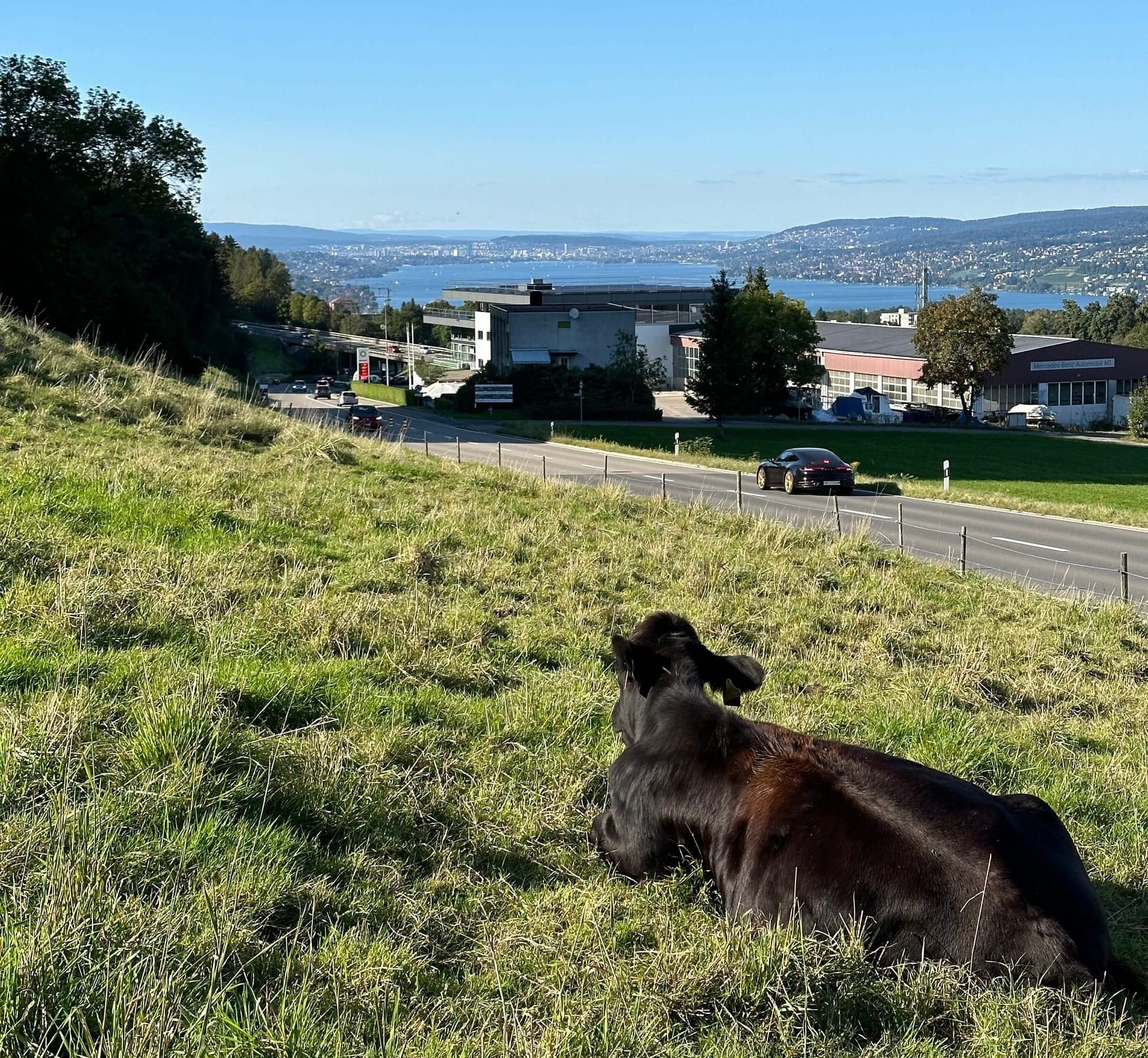
We ended our trip in Lindau - worth a visit if you're in the area. Really a nice German lakeside town, and much cheaper than Switzerland! We immediately noticed a 20-30% decrease in the price of food and hotels.
Approximate costs for a road trip in Switzerland
I'm using euros as it's a more universal currency, it's almost the same as Swiss francs currently.
- €150 per night for hotels on average. Expect to pay more for places like Zermatt or Lauterbrunnen.
- €80-100 for a dinner for two. Expect to pay more in Zermatt.
- Various cable cars, cogwheel trains, funiculars etc... can be surprisingly expensive. Gornegrat cogwheel train costs 120 CHF per person. Gimmelwald cable car from Lauterbrunnen is also 120 per person.
- €1500 for the BMW M4 Competition from Sixt Munich for 7 days (including full insurance). There were discounts involved. The insurance is a big chunk of that. If you book online you get a 45% discount on the insurance, which normally can cost just as much, or more than, the rental itself.
All up, we spent about €5,000 on this one-week trip (not including flights).
Get an eSim for mobile internet
Roaming internet packages for Swtzerland can be expensive. Switzerland is not in the EU so even if you're from a European country, your mobile plan likely won't cover Switzerland. Or if you're from the USA or elsewhere then obviously that's already the case.
The cheapest way to have internet while travelling is by using a travel eSim provider such as Airalo or the one I used - Yesim (a Swiss company).
If you've never used an eSim, these work by giving you a virtual sim card at local rates. Don't worry, you don't need to change your physical sim card in your phone, and it doesn't deactivate your regular number, so you can still receive your usual text, calls etc... Most modern phones allow you to install multiple eSims, and have 2 numbers active at the same time. It's very easy to install an eSim, just get one of the apps (Airalo or Yesim) and it shows you how to turn it on through your phone settings.
Yesim offers unlimited data for 7 days for €23. Whereas Airalo (the bigger company) only offered a maximum of 20GB for $38. If you're driving with carplay and Google Maps, you're going to burn through your data quite quickly. I used up more than 1GB per day (I think because I had topography and satellite view switched on).
My verdict on the BMW M4 Competition
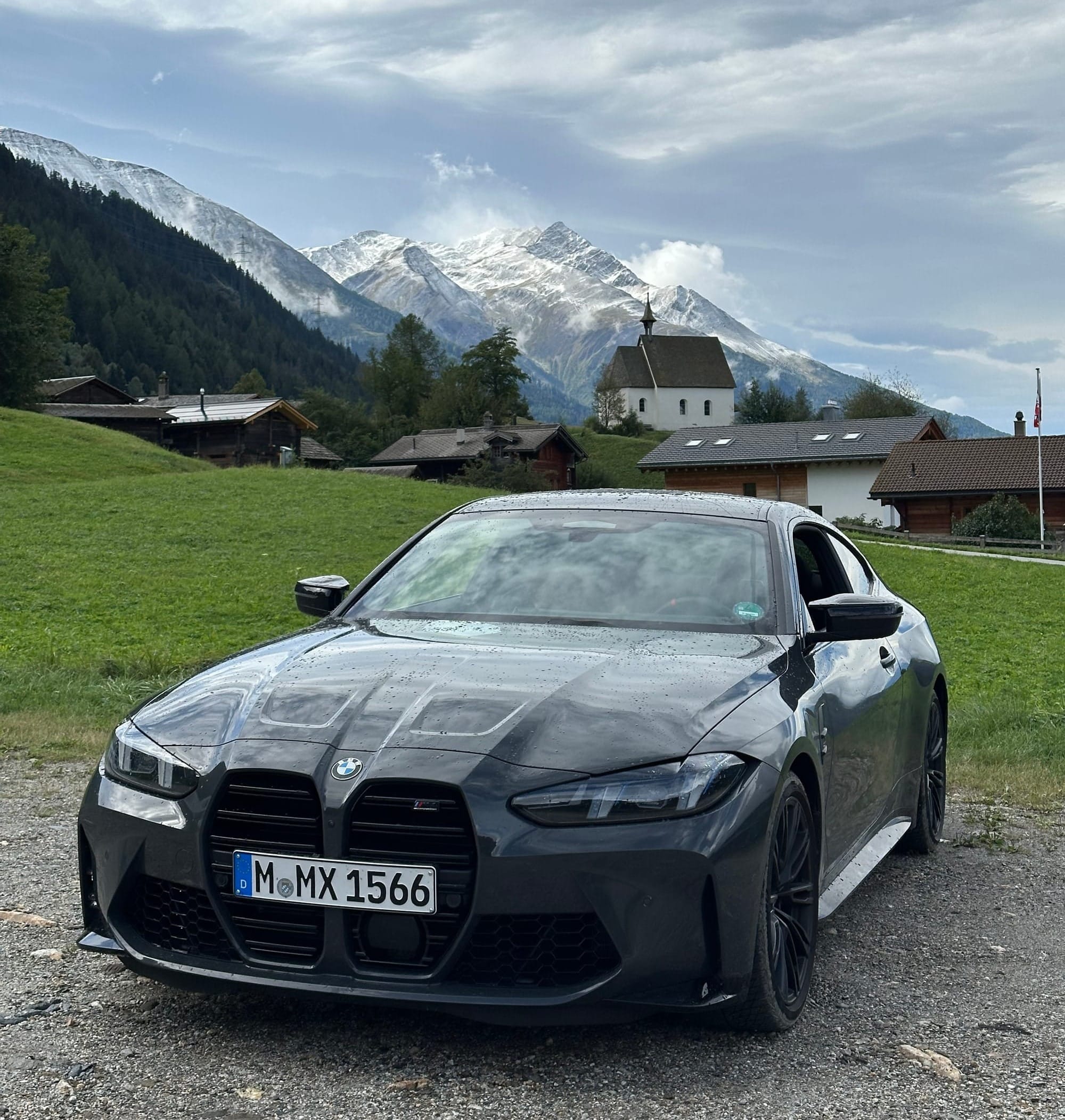
I loved driving the M4, but I was also a bit underwhelmed. I guess I was expecting a bit more excitement on those winding alpine roads.
It felt incredibly powerful when I stepped on the gas, and that was fun, but I could do it very, very rarely. Speed limits and cars in front of me were a buzzkill.
The M4 seems to be designed for the German autobahn - where there are no speed limits. Driving in Germany was surprisingly more fun than on the Swiss alpine roads. On the autobahn I could overtake at will, quickly going from cruising at 150km/h to overtaking at 220km/h in just a few seconds.
I realized that if you're looking for excitement (and you don't live in Germany), then just get a motorcycle! An average road bike will give you a much more engaging sensory driving experience than a car, even below the speed limit, while also being ten times cheaper. The BMW on the other hand felt like I needed to break the law to have fun, it was a constant temptation.
To be fair, it's a racecar. I didn't take the car to a racetrack, I didn't drift (the M4 even comes with a drift analyzer on the computer). So I feel like I didn't fully experience all the fun it had to offer.
I was also really impressed with the overall quality of the BMW. It just felt solid, and well-built, everything worked great. The parking sensors and 3D exterior view of the car were really useful. The sound system was amazing! And from the outside, the car looks like a batmobile.
This came with drawbacks though. It was very low and visibility wasn't great, hard to get in and out of, hard to throw your backpack on the back seat because it's a coupe with no rear doors. There were lots of minor issues making it annoying to live with a sports car for your everyday life. I don't think it was fuel-efficient either, even in comfort mode.
So I wouldn't buy the M4, even if I was rich. I thought the experience would inspire me to get a BMW. But now I think I'd ideally prefer a rugged go-anywhere SUV for practical road trips, and a motorcycle for fun drives.


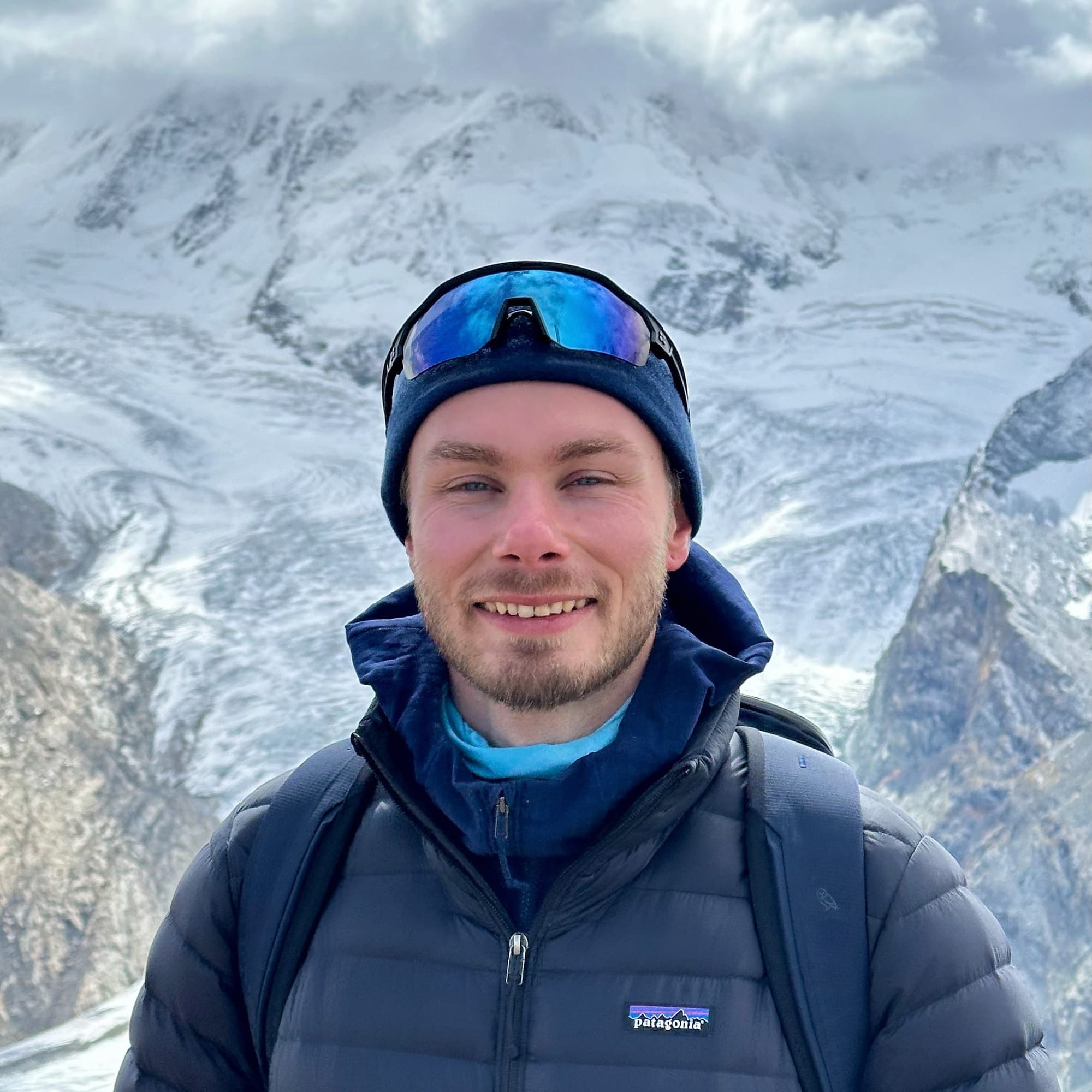
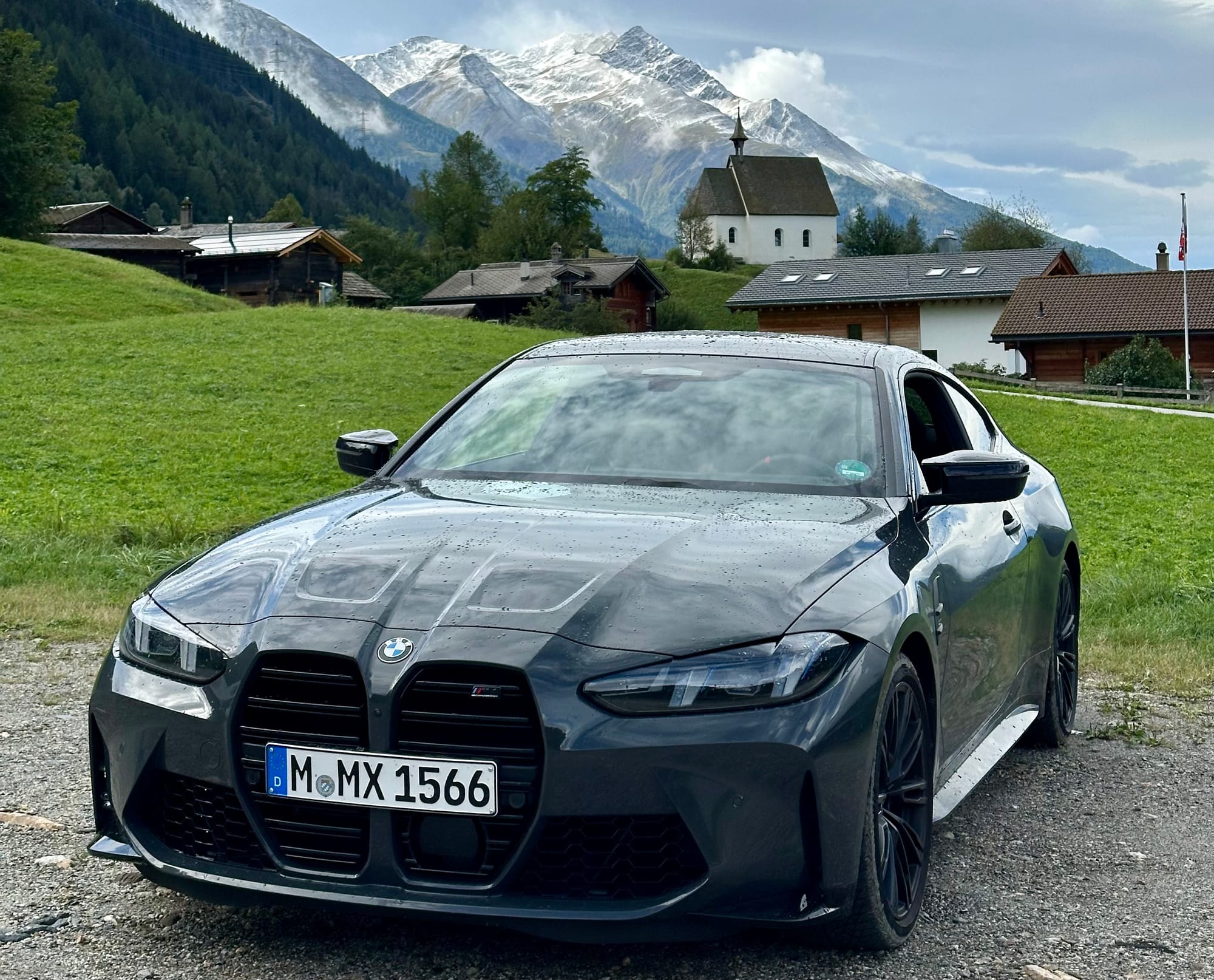
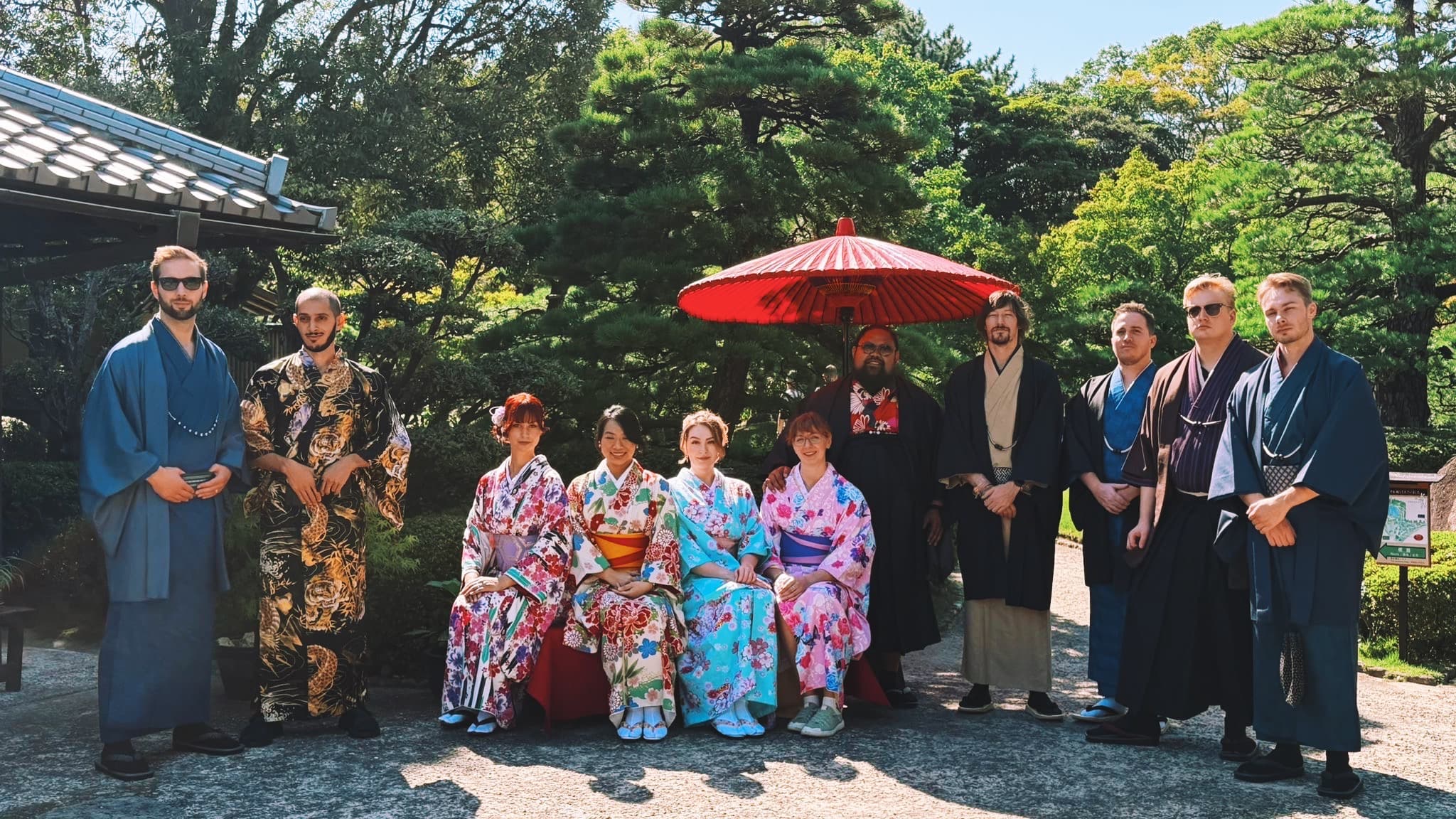
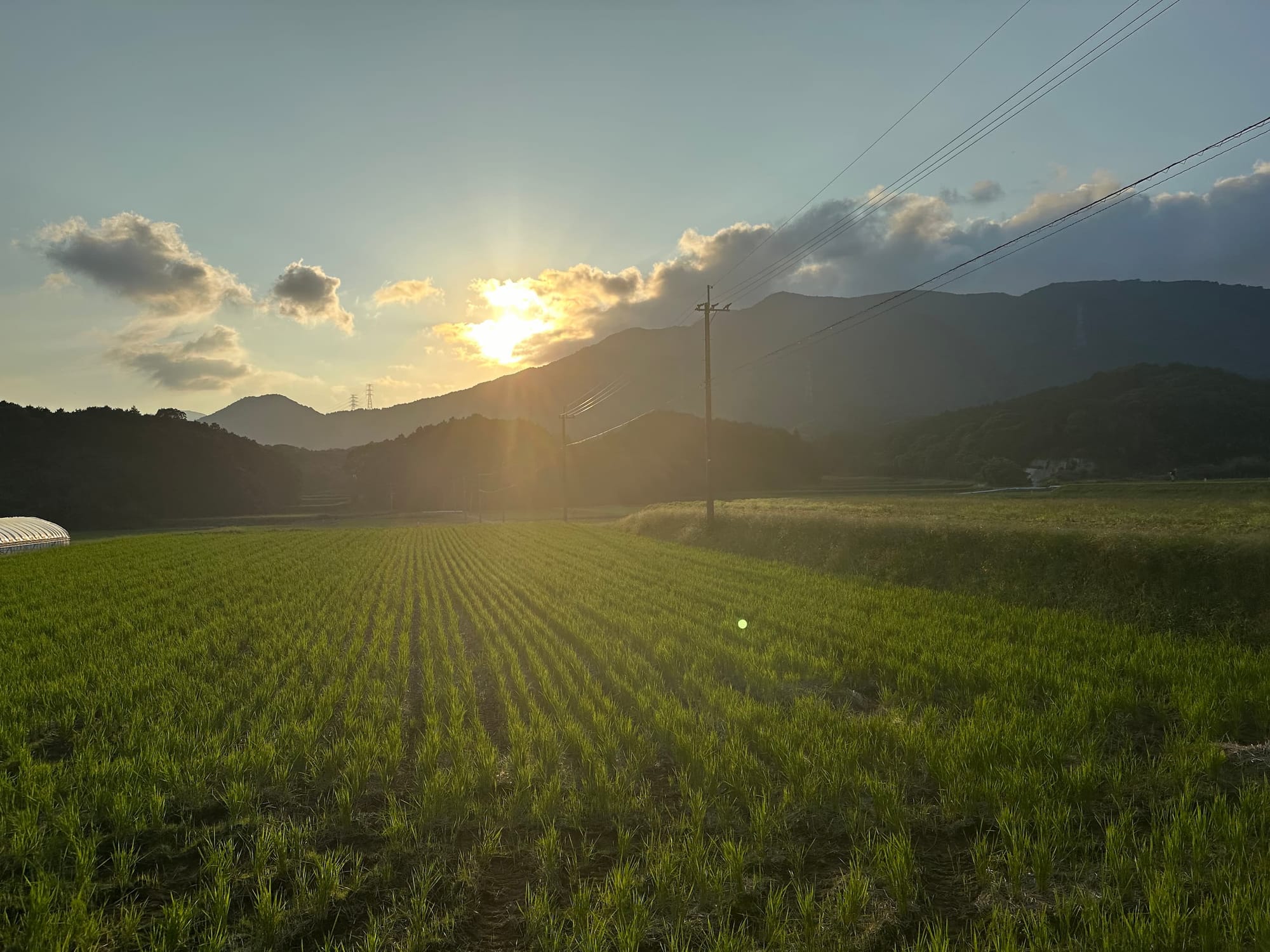
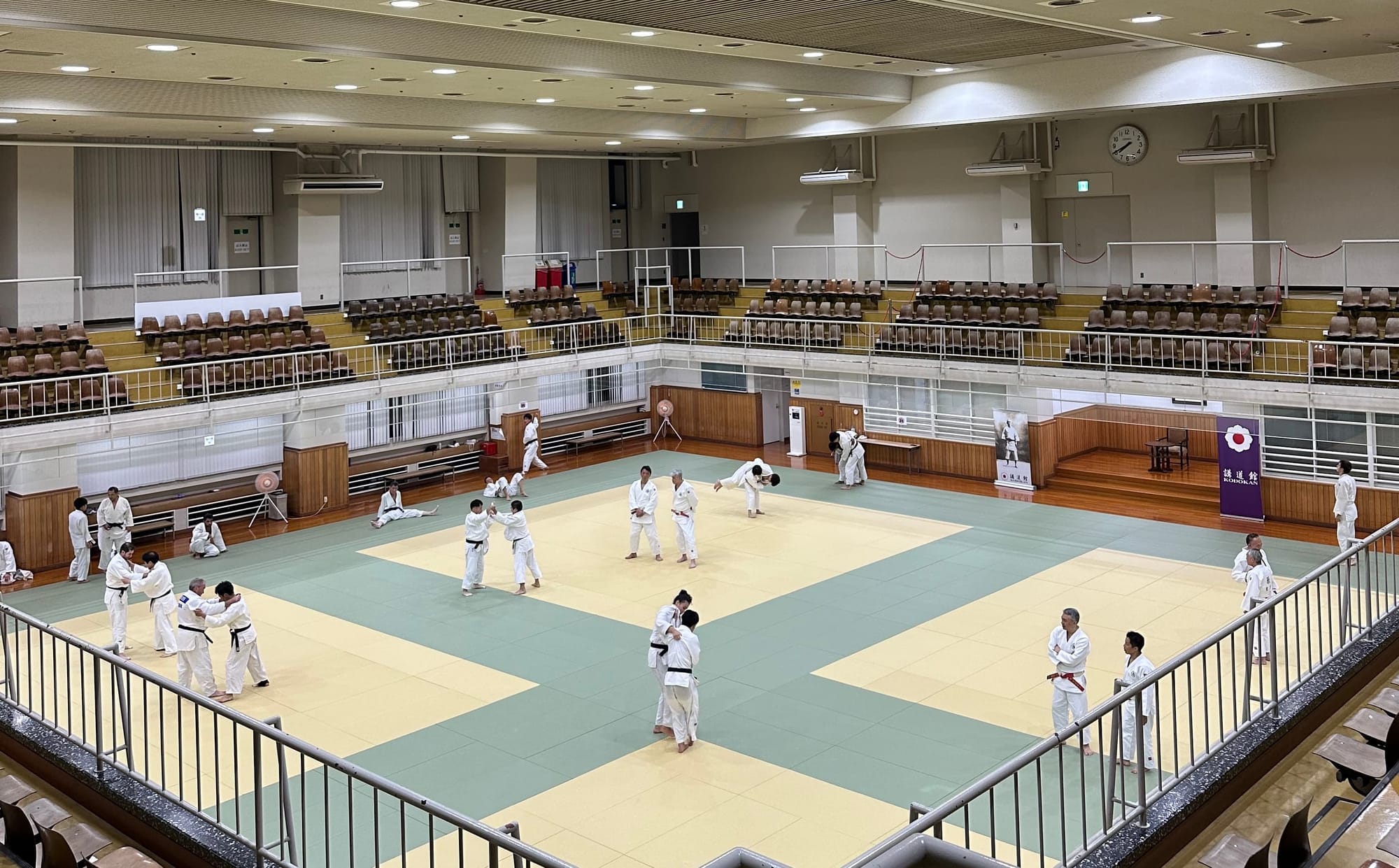
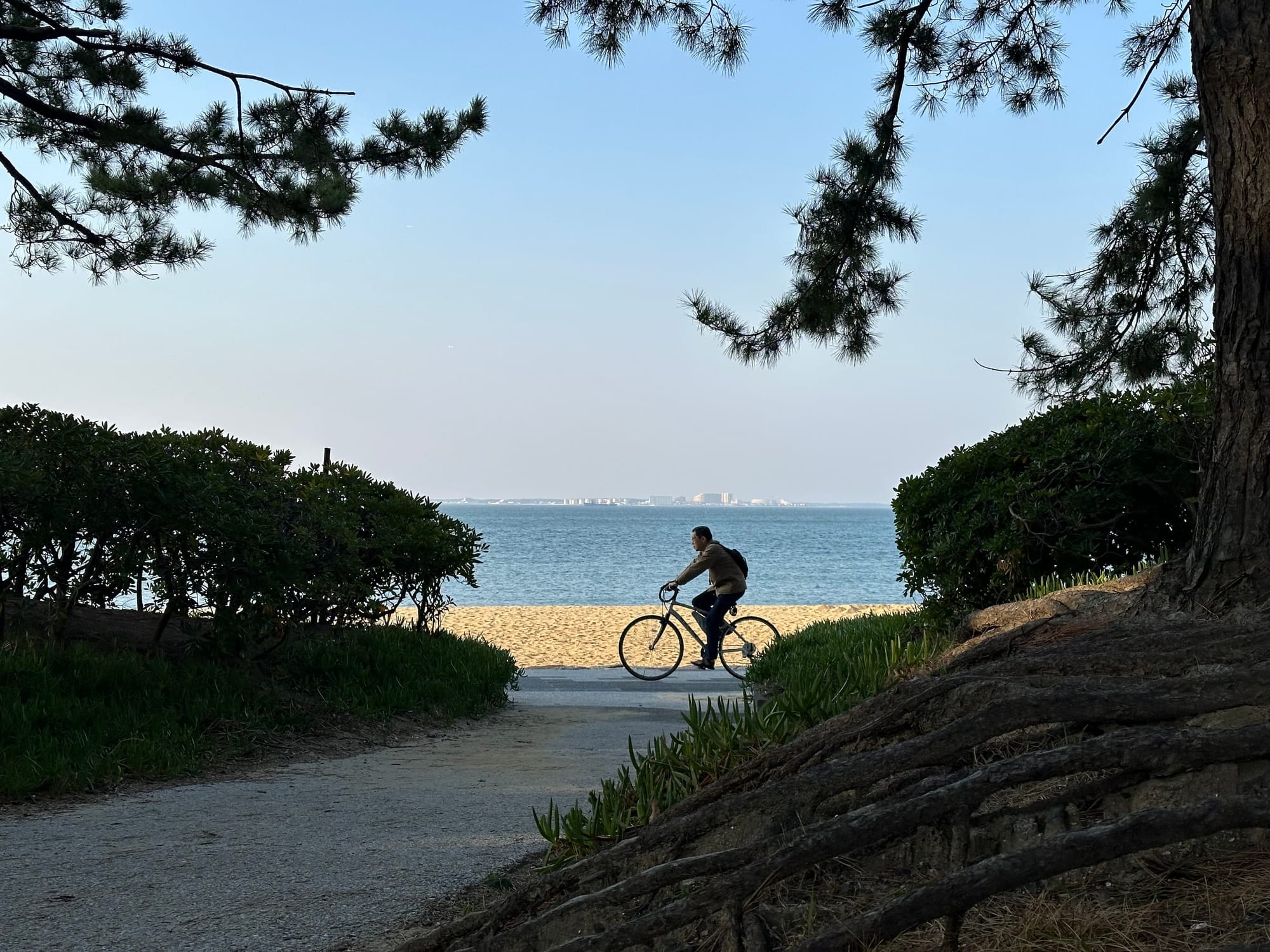
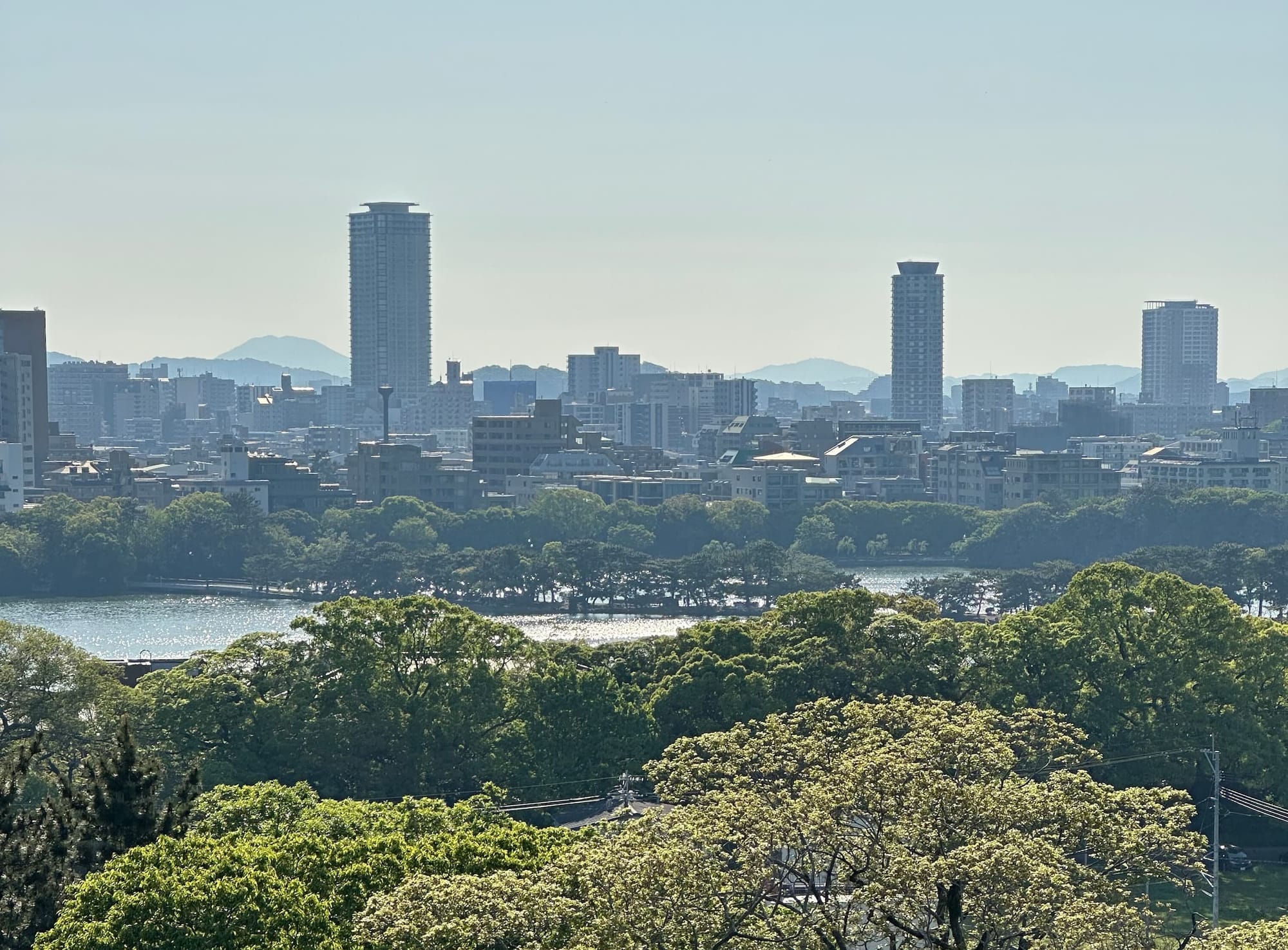
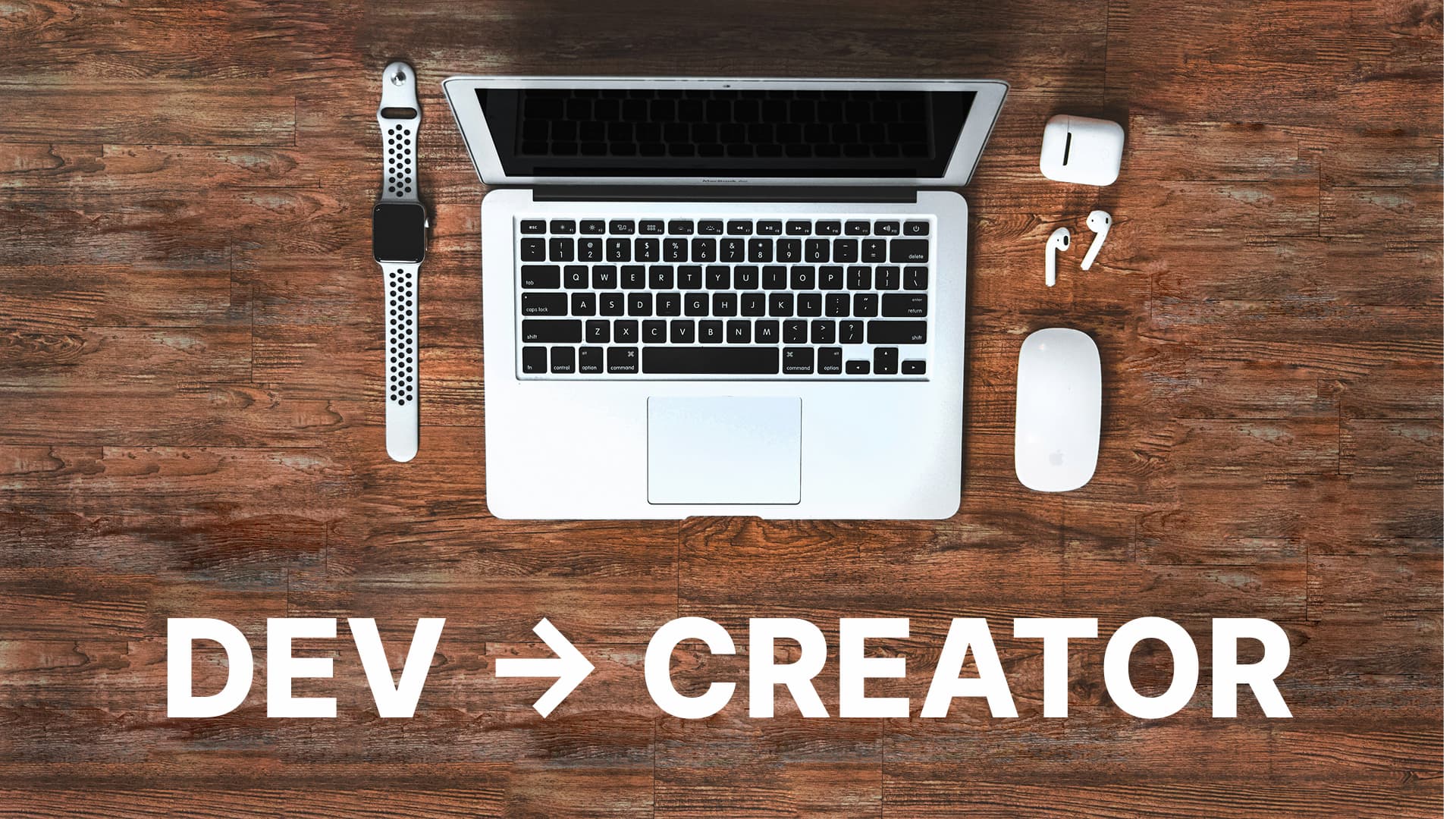
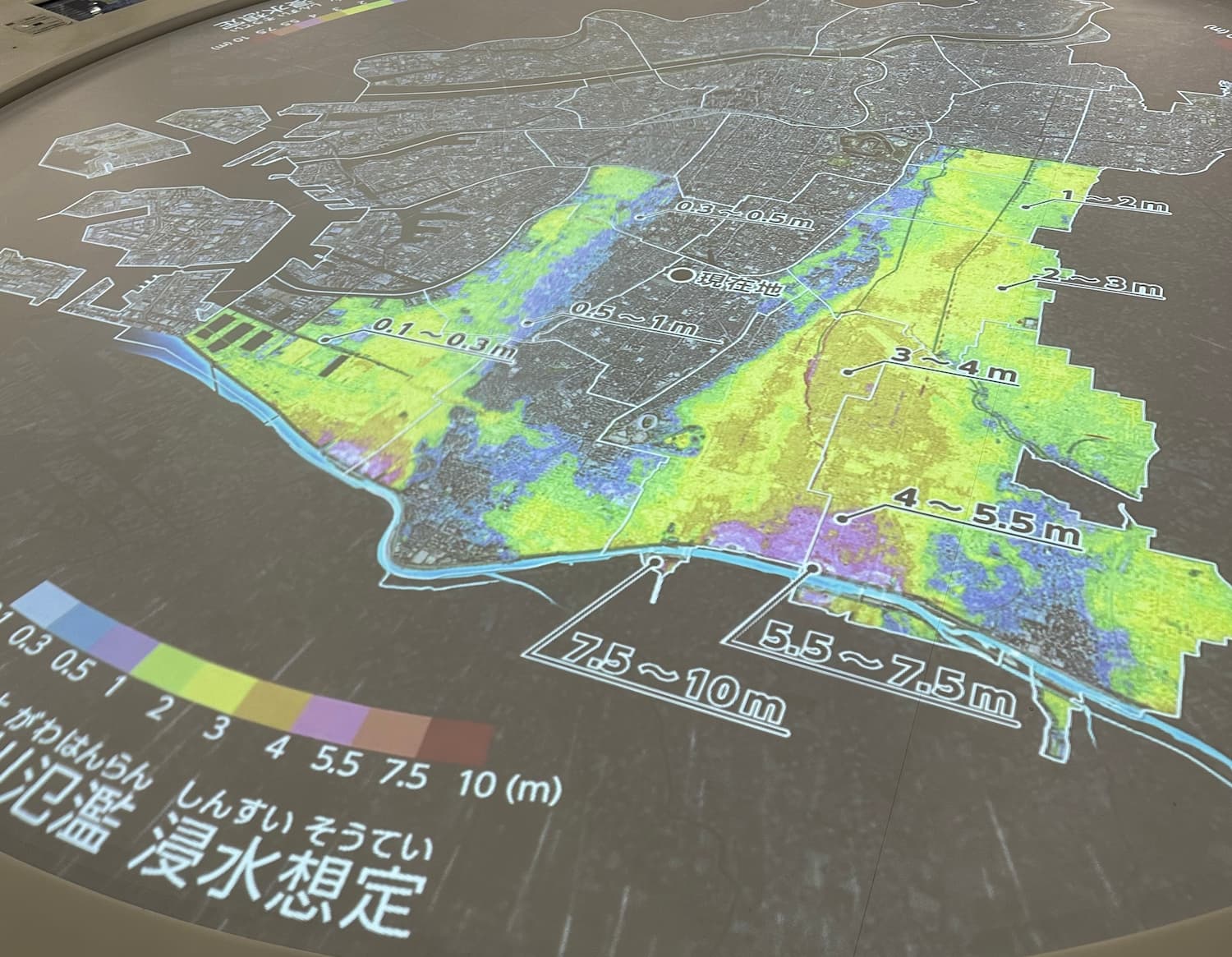
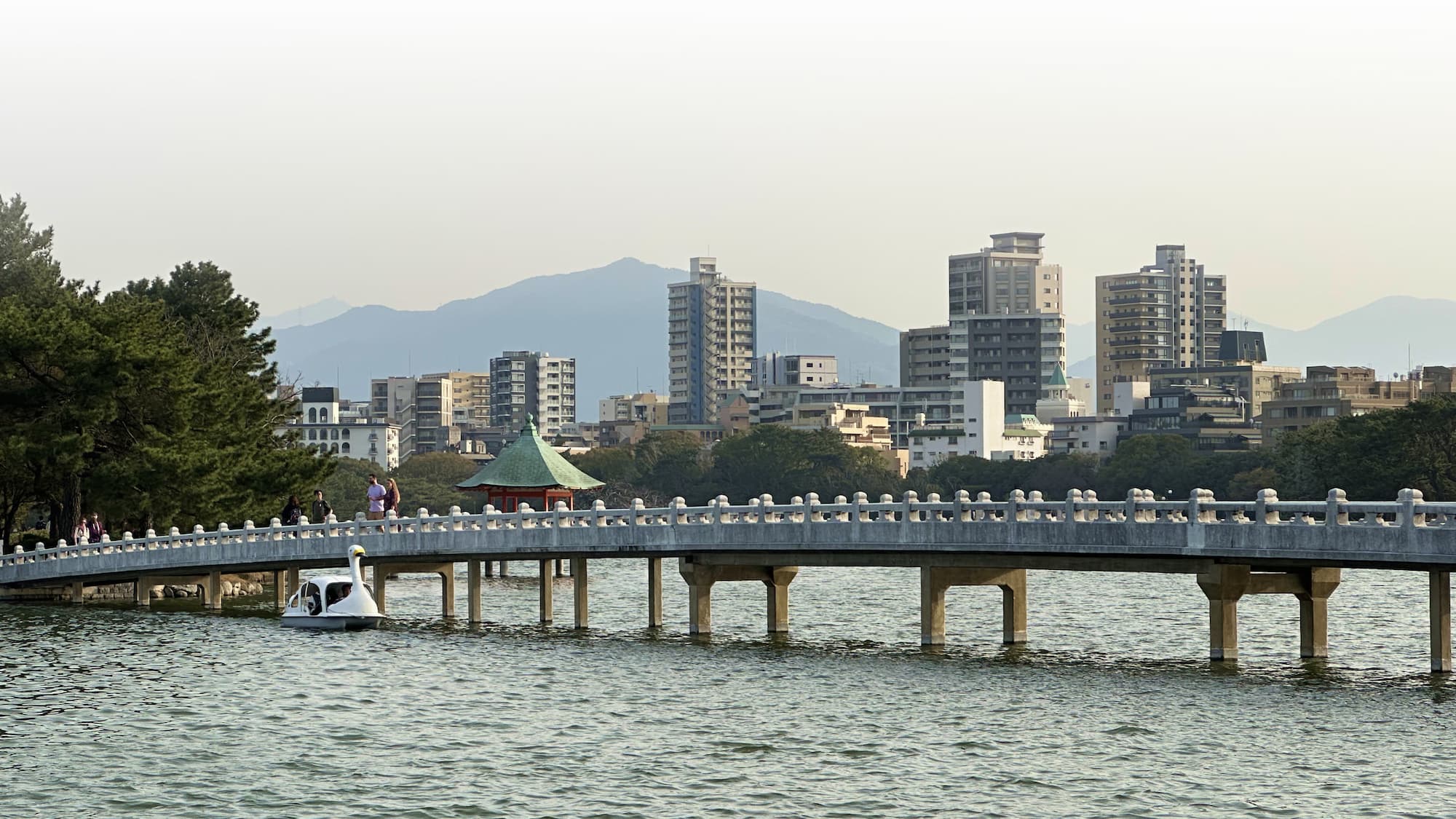
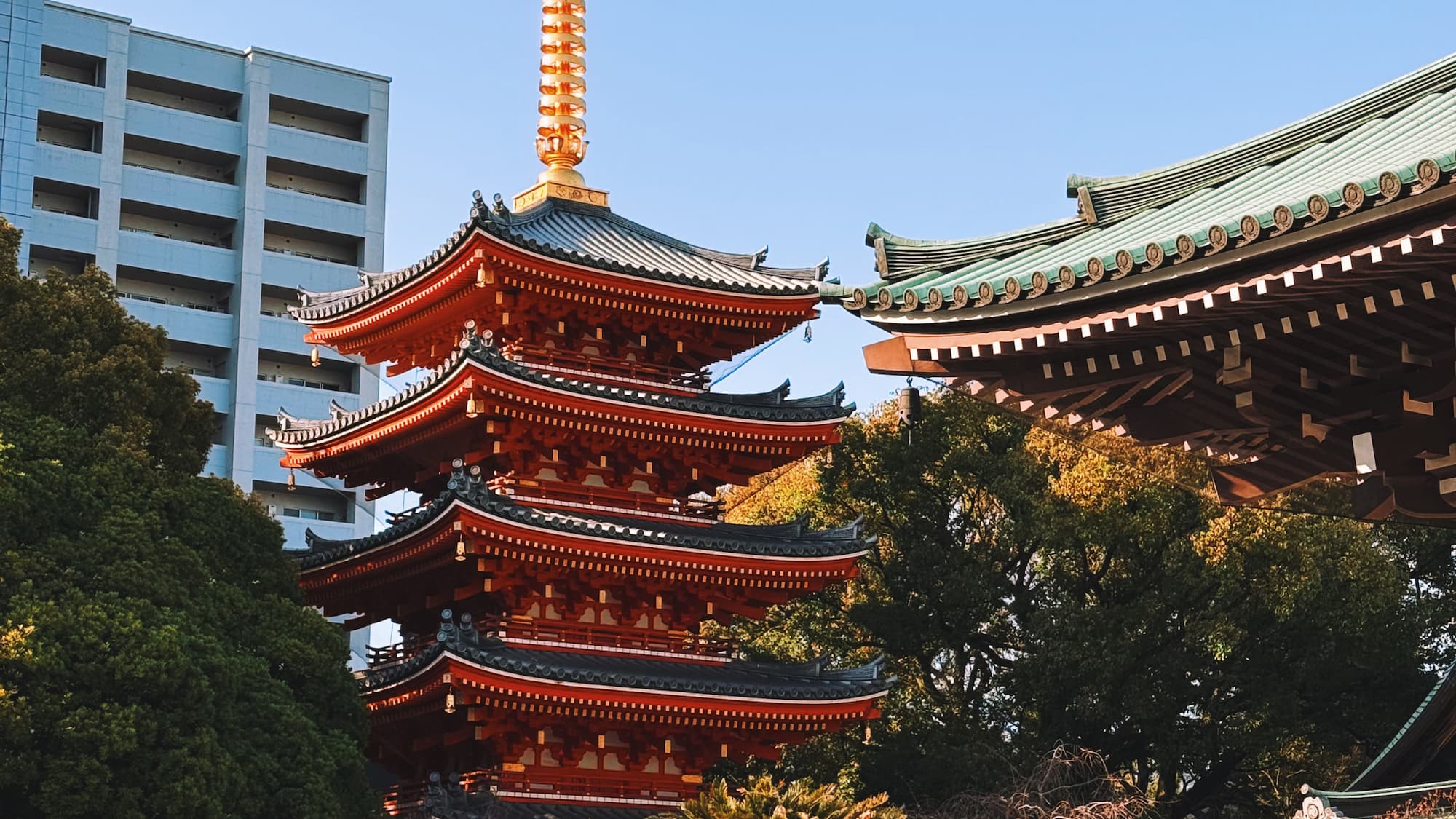
Discussion